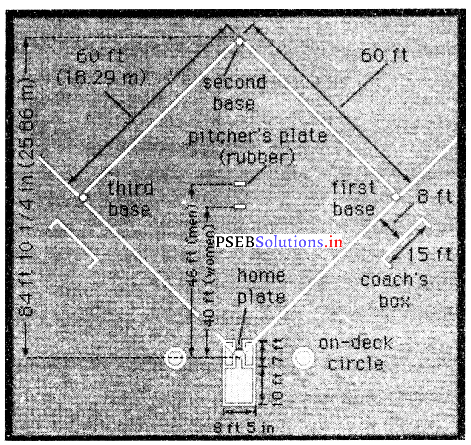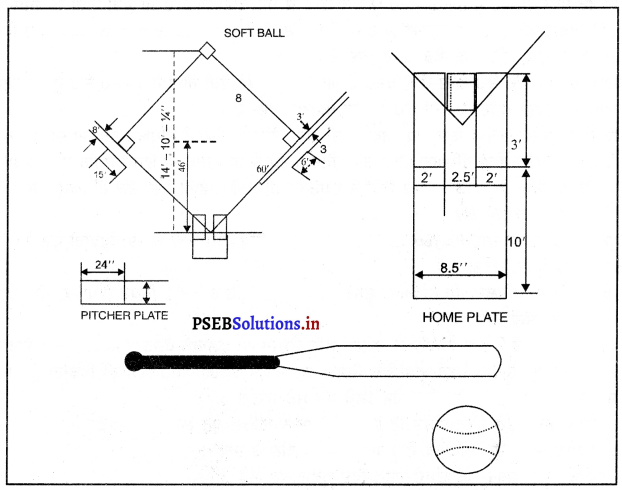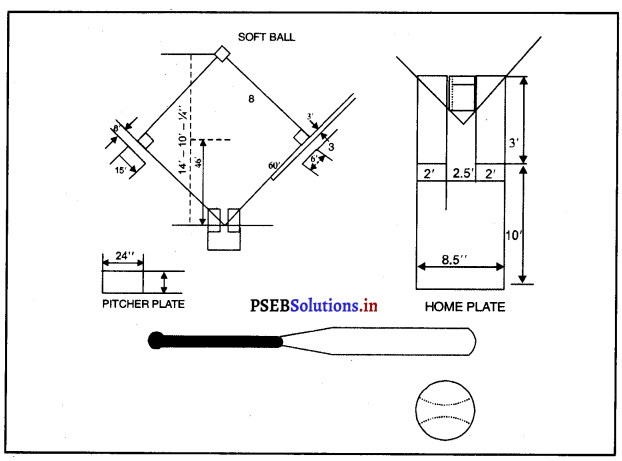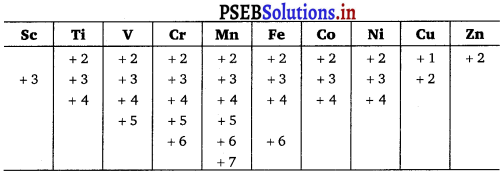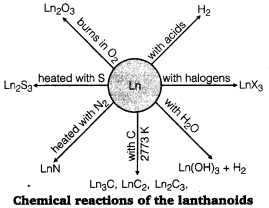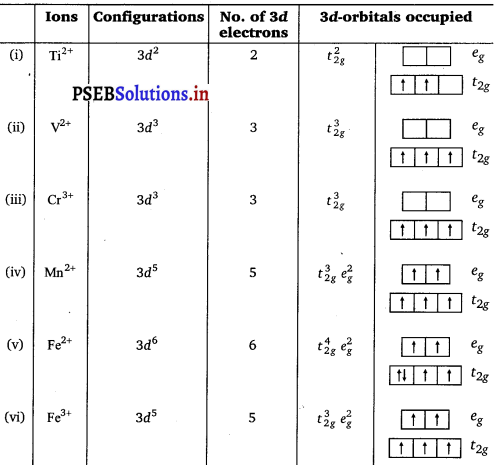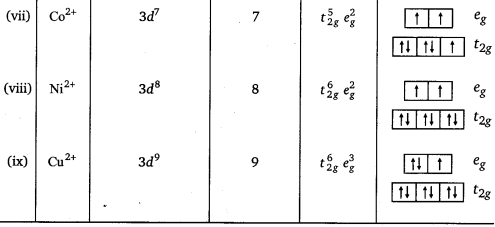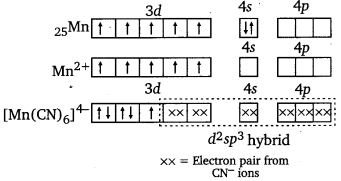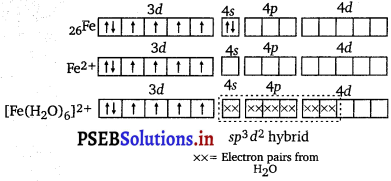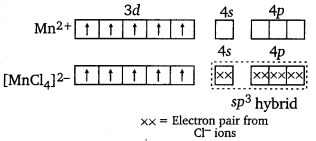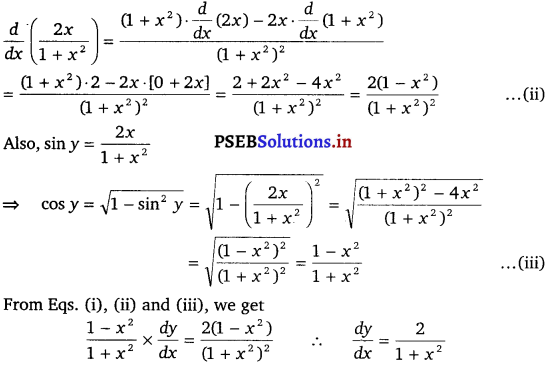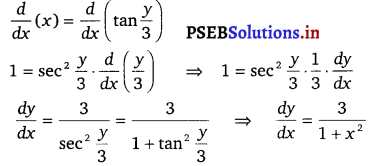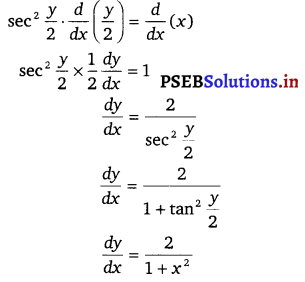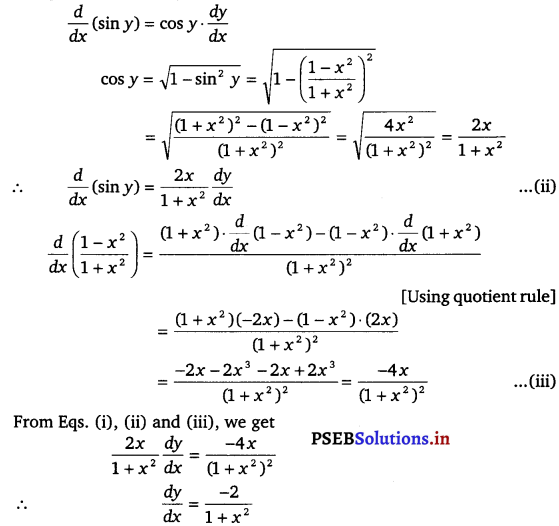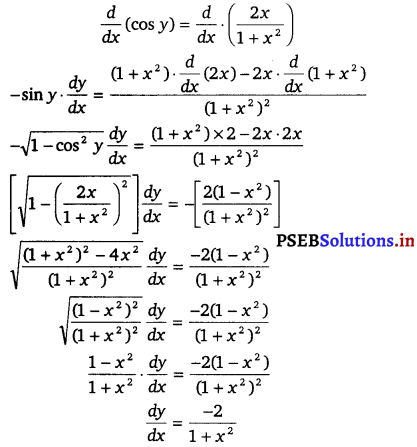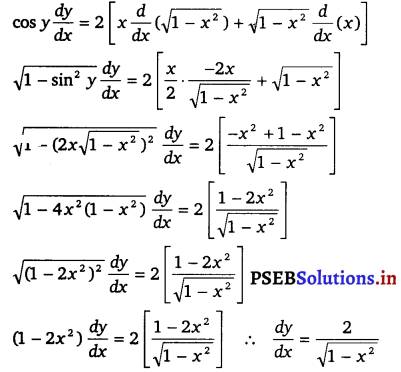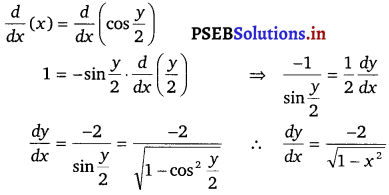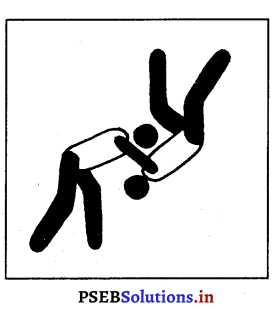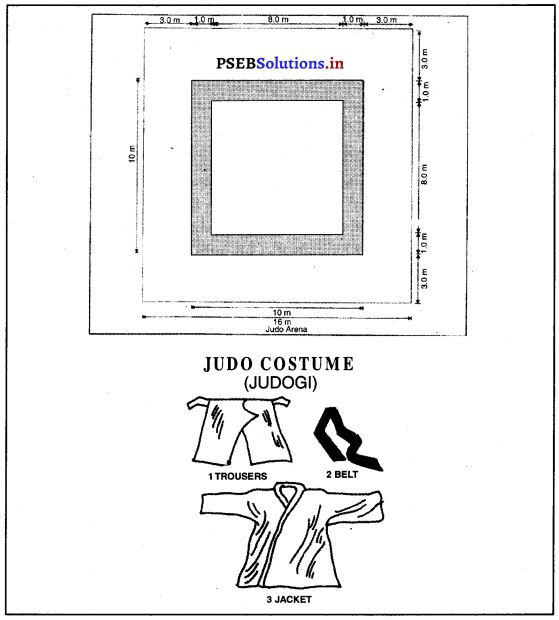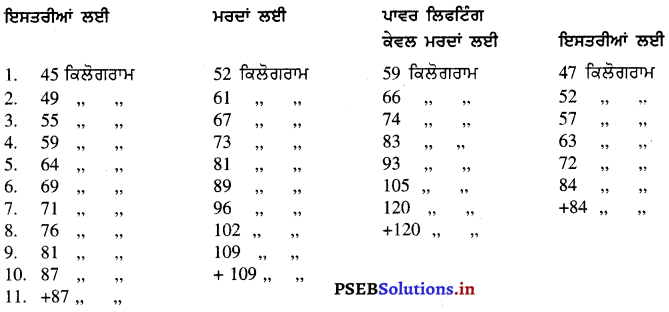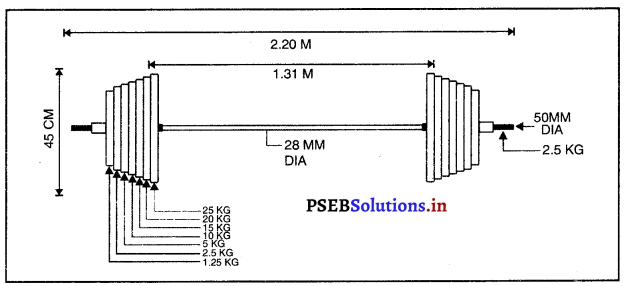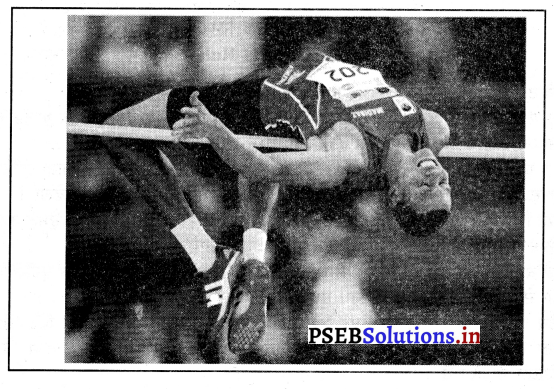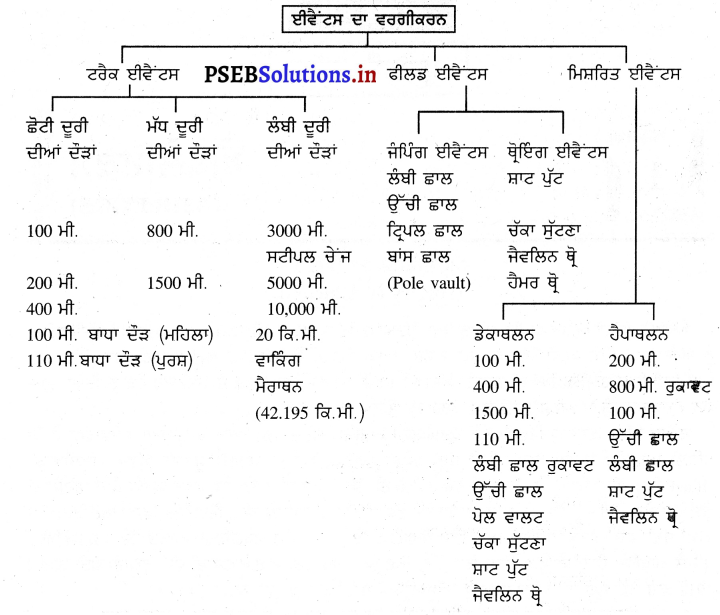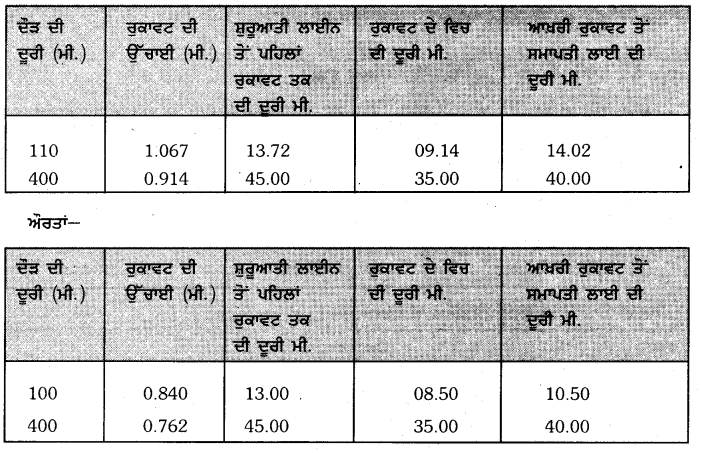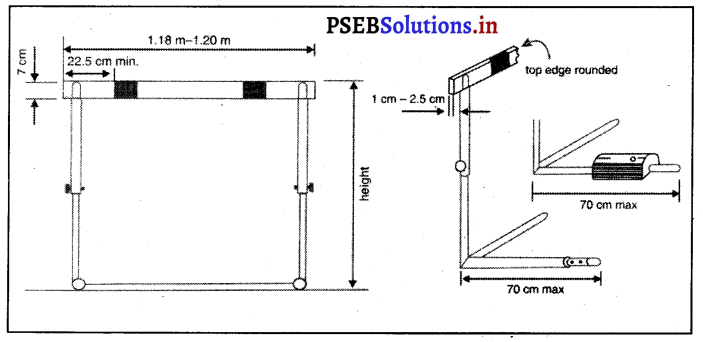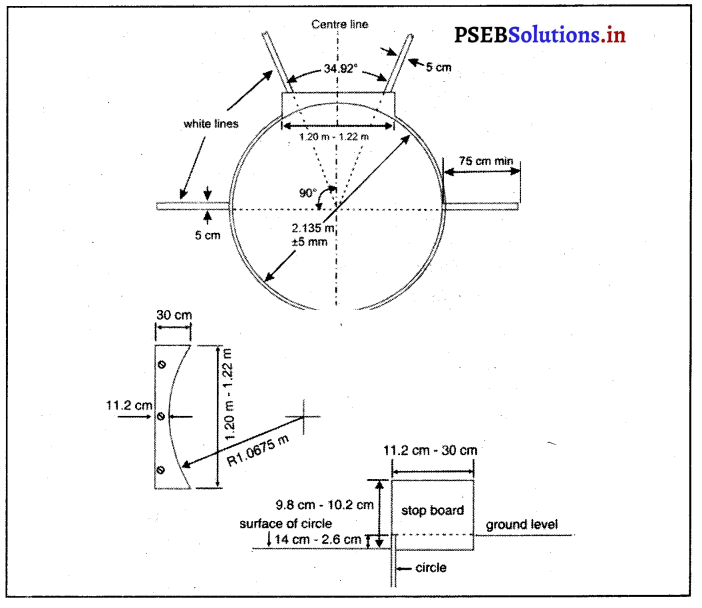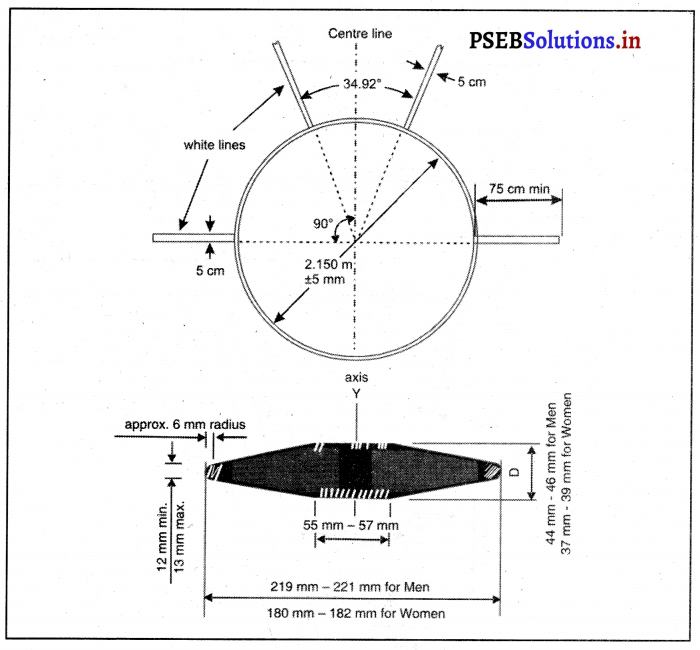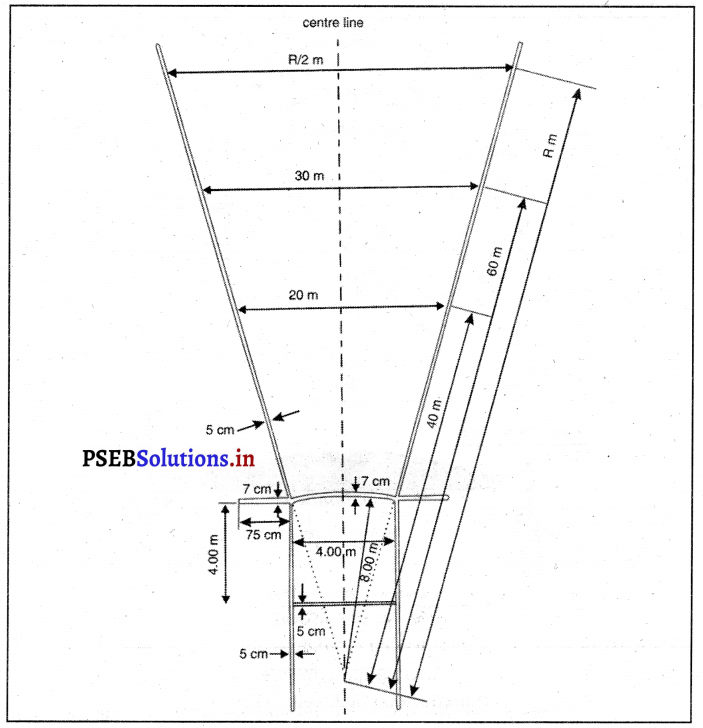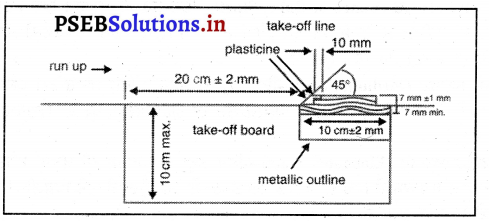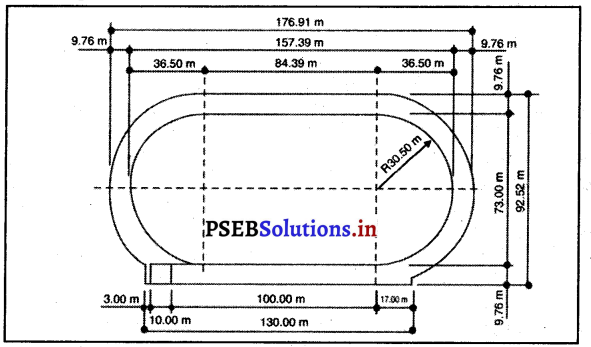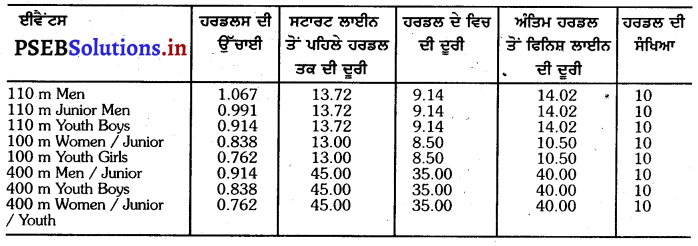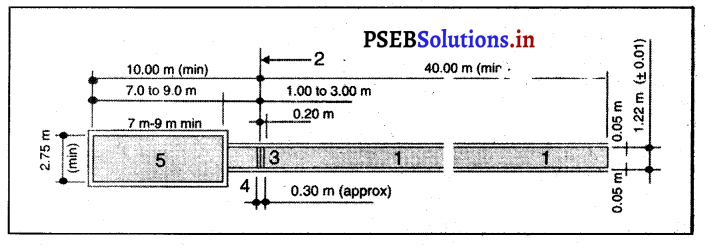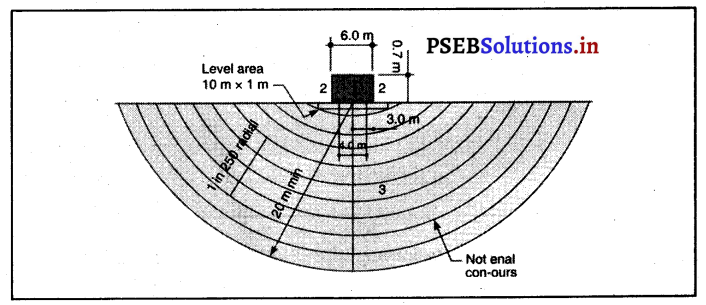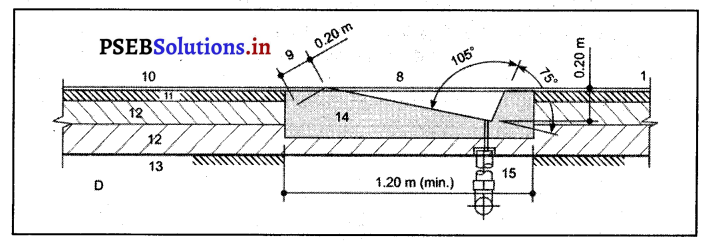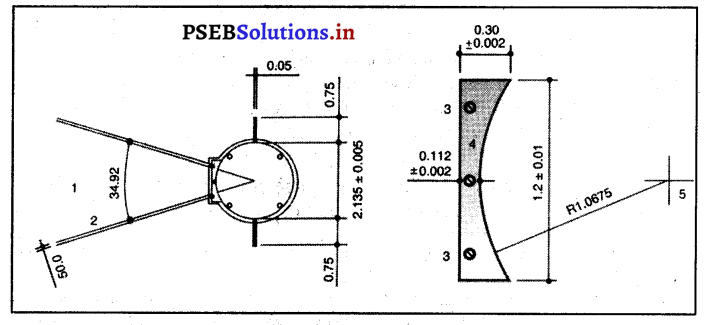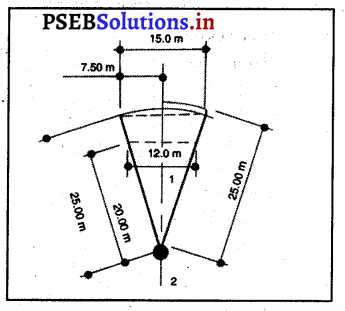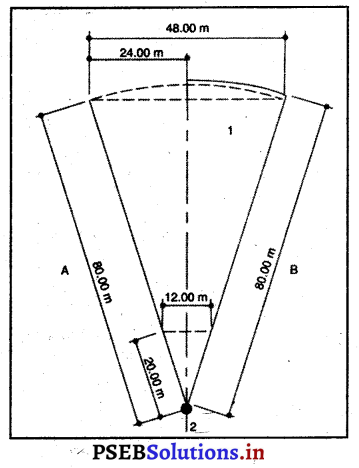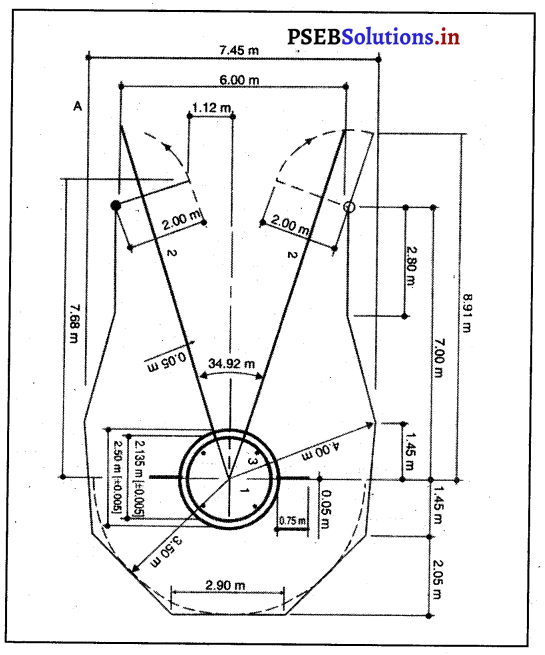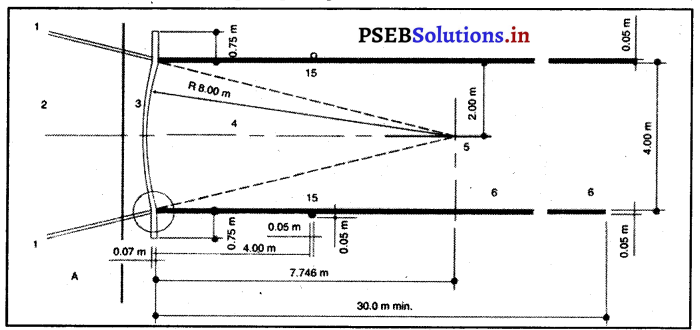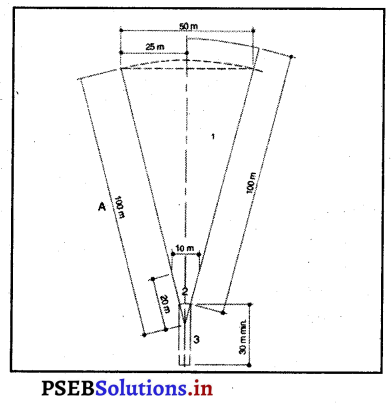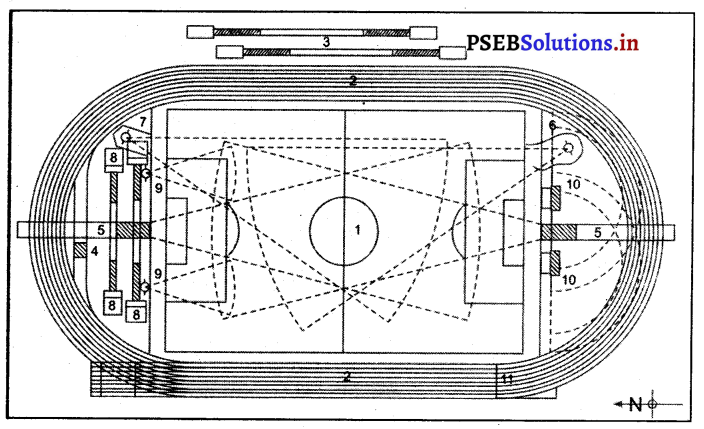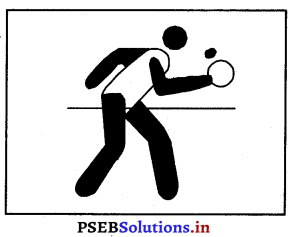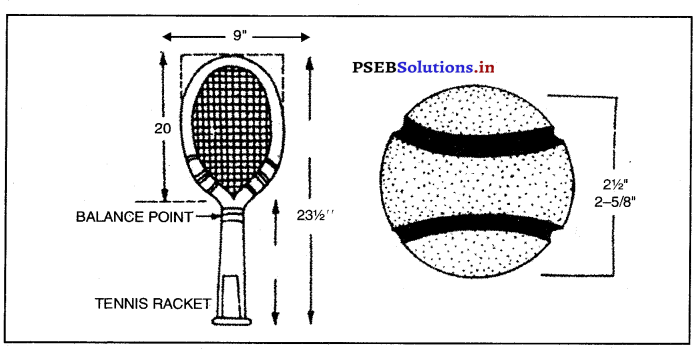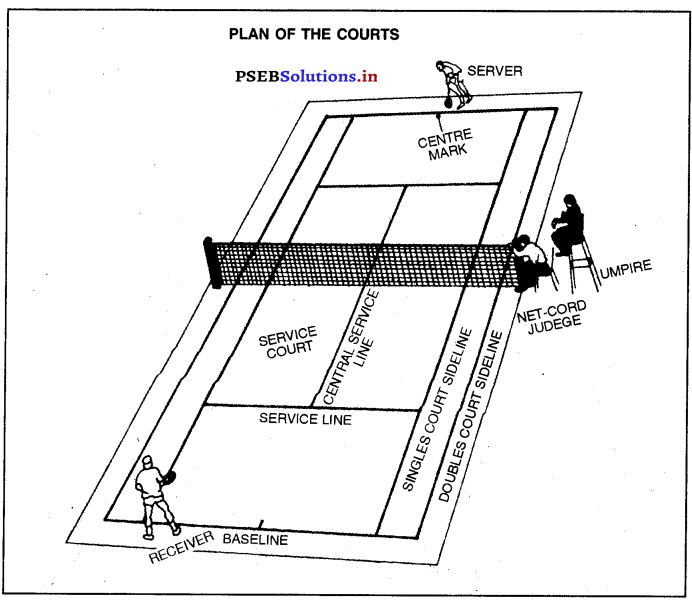Punjab State Board PSEB 12th Class Physical Education Book Solutions Chapter 6 ਸਰੀਰਿਕ ਸਿੱਖਿਆ ਦੇ ਸਮਾਜਿਕ ਅਤੇ ਮਨੋਵਿਗਿਆਨਕ ਪੱਖ Textbook Exercise Questions and Answers.
PSEB Solutions for Class 12 Physical Education Chapter 6 ਸਰੀਰਿਕ ਸਿੱਖਿਆ ਦੇ ਸਮਾਜਿਕ ਅਤੇ ਮਨੋਵਿਗਿਆਨਕ ਪੱਖ
Physical Education Guide for Class 12 PSEB ਸਰੀਰਿਕ ਸਿੱਖਿਆ ਦੇ ਸਮਾਜਿਕ ਅਤੇ ਮਨੋਵਿਗਿਆਨਕ ਪੱਖ Textbook Questions and Answers
ਇੱਕ ਅੰਕ ਵਾਲੇ ਪ੍ਰਸ਼ਨ-ਉੱਤਰ (One Mark Question-Answers)
ਪ੍ਰਸ਼ਨ 1.
ਸਮਾਜ ਸ਼ਾਸਤਰ ਅੰਗਰੇਜ਼ੀ ਦੇ ਕਿਸ ਸ਼ਬਦ ਦਾ ਅਨੁਵਾਦ ਹੈ ?
ਉੱਤਰ:
ਸਮਾਜ ਸ਼ਾਸਤਰ ਦੋ ਸ਼ਬਦਾਂ ਦੇ ਸੁਮੇਲ ਤੋਂ ਬਣਿਆ ਹੈ ਜਿਸ ਵਿਚ ‘ “ਸੋਸੁਜ਼’’ (Socius) ਦਾ ਮਤਲਬ ਐਸੋਸਿਏਟ ਜਾਂ ਸਮਾਜਿਕ ਅਤੇ “ਲੋਗੋ’’ (Logos) ਤੋਂ ਭਾਵ ਵਿਗਿਆਨ ਜਾਂ ਅਧਿਐਨ ਤੋਂ ਹੈ ।
ਪ੍ਰਸ਼ਨ 2.
ਕਿਹੜੇ ਦੇਸ਼ ਨੂੰ ਸੰਸਾਰ ਦੀਆਂ ਸਭ ਤੋਂ ਪੁਰਾਣੀਆਂ ਸੱਭਿਆਤਾਵਾਂ ਦੇ ਰੂਪ ਵਿੱਚ ਮੰਨਿਆ ਜਾਂਦਾ ਹੈ ?
ਉੱਤਰ:
ਯੂਨਾਨ ।
ਪ੍ਰਸ਼ਨ 3.
ਕਿਹੜੀ ਖੇਡ ਨੂੰ ਸਭ ਖੇਡਾਂ ਦੀ ਮਾਂ ਦੇ ਰੂਪ ਵਿੱਚ ਜਾਣਿਆ ਜਾਂਦਾ ਹੈ ?
ਉੱਤਰ:
ਜਿਮਨਾਸਟਿਕ ।
ਪ੍ਰਸ਼ਨ 4.
ਸਮਾਜ ਸ਼ਾਸਤਰ ਕਿਸ ਭਾਸ਼ਾ ਦਾ ਸ਼ਬਦ ਹੈ ?
ਉੱਤਰ:
ਇਹ ਦੋ ਸ਼ਬਦਾਂ ਤੋਂ ਮਿਲ ਕੇ ਬਣਿਆ ਹੈ-ਲਾਤੀਨੀ ਭਾਸ਼ਾ ਦੇ ਸ਼ਬਦ (Socius) ਜਿਸਦਾ ਅਰਥ ਹੈCompanion ਸਾਥੀ ਅਤੇ ਯੂਨਾਨੀ ਭਾਸ਼ਾ ਦੇ ਸ਼ਬਦ (Logos) ਜਿਸਦਾ ਅਰਥ ਹੈ-Knowledge ਗਿਆਨ ।

ਦੋ ਅੰਕਾਂ ਵਾਲੇ ਪ੍ਰਸ਼ਨ-ਉੱਤਰ (Two Marks Question-Answers)
ਪ੍ਰਸ਼ਨ 5.
ਸਮਾਜ ਸ਼ਾਸਤਰ ਦੀ ਪਰਿਭਾਸ਼ਾ ਦਿਉ ।
ਉੱਤਰ:
ਗਰੇਟ (Garrett) ਦੇ ਅਨੁਸਾਰ, “ਸਮਾਜਿਕਤਾ ਇੱਕ ਅਜਿਹੀ ਪ੍ਰਕ੍ਰਿਆ ਹੈ ਜਿਸ ਦੁਆਰਾ ਜੀਵ ਜੰਤੂ ‘ ਵਿਅਕਤੀਗਤ ਮਨੁੱਖੀ ਜੀਵਨ ਵਿਚ ਤਬਦੀਲ ਹੋ ਜਾਂਦਾ ਹੈ।” ਔਗਬਰਨ (Ogburn) ਦੇ ਅਨੁਸਾਰ, “ਸਮਾਜੀਕਰਨ ਉਹ ਪ੍ਰਕ੍ਰਿਆ ਹੈ ਜਿਸ ਰਾਹੀਂ ਵਿਅਕਤੀ ਸਮੂਹ ਦੇ ਨਿਯਮਾਂ ਨੂੰ ਧਾਰਨ ਕਰਨਾ ਸਿੱਖਦਾ ਹੈ ।
ਪ੍ਰਸ਼ਨ 6.
ਸਮਾਜ ਸ਼ਾਸਤਰ ਦਾ ਕੀ ਅਰਥ ਹੈ ?
ਉੱਤਰ:
ਸਮਾਜ ਸ਼ਾਸਤਰ ਦੋ ਸ਼ਬਦਾਂ ਦੇ ਸੁਮੇਲ ਤੋਂ ਬਣਿਆ ਹੈ ਜਿਸ ਵਿਚ ‘ਸ਼ੋਸ਼ੂਜ” ਦਾ ਮਤਲਬ ਐਸੋਸਿਏਟ ਜਾਂ ਸਮਾਜਿਕ ਅਤੇ ‘‘ਲੋਗੋ” ਤੋਂ ਭਾਵ ਵਿਗਿਆਨ ਜਾਂ ਅਧਿਐਨ ਤੋਂ ਹੈ । ਇਸ ਲਈ ਸਮਾਜ ਸ਼ਾਸਤਰ ਸਮਾਜ ਦਾ ਵਿਗਿਆਨ ਹੈ । ਉਗਬਰਨ ਦੇ ਅਨੁਸਾਰ, “ਸਮਾਜੀਕਰਨ ਉਹ ਪ੍ਰਕਿਰਿਆ ਹੈ ਜਿਸ ਵਿਚ ਵਿਅਕਤੀ ਸਮੂਹ ਦੇ ਨਿਯਮਾਂ ਨੂੰ ਧਾਰਨਾ ਕਰਨਾ ਸਿੱਖਦਾ ਹੈ । ਸਰੀਰਕ ਸਿੱਖਿਆ ਅਤੇ ਖੇਡਾਂ ਇਕ ਵਿਅਕਤੀ ਵਿਚ ਸਮਾਜਿਕ ਗੁਣਾਂ ਦੇ ਰੁਝਾਨ ਨੂੰ ਬਣਾਉਣ ਲਈ ਇਕ ਬਲਾਕ ਦਾ ਕੰਮ ਕਰਦਾ ਹੈ । ਇਹ ਖੇਤਰ ਕਈ ਤਰ੍ਹਾਂ ਦੇ ਸਮਾਜਿਕ ਗੁਣ ਜਿਵੇਂ ਕਿ ਚਰਿੱਤਰ, ਗੁਣ, ਸਮੂਹ ਭਾਵਨਾਵਾਂ, ਜ਼ਿੰਮੇਵਾਰੀਆਂ, ਰੁਈਂਆਂ, ਸਮਰਪਣ ਅਤੇ ਸਮਾਜਿਕ ਸੰਚਾਰ ਆਦਿ ਭਿੰਨਤਾਵਾਂ ਪ੍ਰਦਾਨ ਕਰਦਾ ਹੈ :
ਪ੍ਰਸ਼ਨ 6.
ਆਪਸੀ ਭਾਈਚਾਰੇ ਦੀ ਸਾਂਝ ਬਾਰੇ ਲਿਖੋ ।
ਉੱਤਰ:
ਖੇਡਾਂ ਭਾਈਚਾਰੇ ਦੀ ਨੀਂਹ ਨੂੰ ਬੱਚਿਆਂ ਅਤੇ ਨੌਜਵਾਨਾਂ ਵਿਚ ਇਕ ਸਮਾਜਿਕ ਏਕਤਾ ਅਤੇ ਸਮਾਜਿਕ ਪੂੰਜੀ ਦੇ ਮਜ਼ਬੂਤ ਸੰਬੰਧ ਨੂੰ ਦਰਸਾਉਂਦੀਆਂ ਹਨ । ਖੇਡਾਂ ਇਹਨਾਂ ਬੱਚਿਆਂ ਅਤੇ ਨੌਜਵਾਨਾਂ ਨੂੰ ਕਈ ਮੌਕੇ ਪ੍ਰਦਾਨ ਕਰਦੀਆਂ ਹਨ, ਜਿੱਥੇ ਉਹ ਆਪਣੀ ਸਵੈ-ਇੱਛਾ ਨਾਲ ਭਾਗ ਲੈ ਸਕਦੇ ਹਨ ਅਤੇ ਜਿਸ ਕਾਰਨ ਉਹਨਾਂ ਵਿਚ ਲੀਡਰਸ਼ਿਪ ਦੇ ਗੁਣ, ਸਕਾਰਾਤਮਕ ਹੀਣੀ ਰਿਸਤੇ, ਸਨਮਾਨ ਅਤੇ ਨੈਤਿਕਤਾ ਦੇ ਗੁਣਾਂ ਦਾ ਵਿਕਾਸ ਹੁੰਦਾ ਹੈ ।
ਤਿੰਨ ਅੰਕਾਂ ਵਾਲੇ ਪ੍ਰਸ਼ਨ-ਉੱਤਰ (Three Marks Question-Answers)
ਪ੍ਰਸ਼ਨ 7.
ਮਾਨਸਿਕ ਅਤੇ ਸਰੀਰਿਕ ਤਣਾਅ ਤੋਂ ਛੁਟਕਾਰਾ ਕਿਵੇਂ ਪਾਇਆ ਜਾ ਸਕਦਾ ਹੈ ?
ਉੱਤਰ:
ਹੇਠ ਦਿੱਤੇ ਅਨੁਸਾਰ ਮਾਨਸਿਕ ਅਤੇ ਸਰੀਰਕ ਤਣਾਅ ਤੋਂ ਛੁਟਕਾਰਾ ਪਾਇਆ ਜਾ ਸਕਦਾ ਹੈ-
- ਧਿਆਨ ਅਤੇ ਲੰਬੇ ਸਾਹ ਲੈ ਕੇ ।
- ਵਿਕਾਸਾਤਮਕ ਗਤੀਵਿਧੀਆਂ ਵਿਚ ਆਪਣੇ ਆਪ ਨੂੰ ਲਗਾ ਕੇ ।
- ਤਨਾਵ ਦੇ ਕਾਰਨਾਂ ਦਾ ਪਤਾ ਲਗਾ ਕੇ ।
- ਸਵੈ-ਮੁਲਾਂਕਣ ਕਰਕੇ ।
- ਸਮੂਹ ਵਿਚ ਗੱਲਾਂ-ਬਾਤਾਂ ਕਰਕੇ ਤਨਾਵ ਨੂੰ ਦੂਰ ਕਰਨਾ ।
- ਖੇਡਾਂ ਅਤੇ ਮਨੋਰੰਜਕ ਗਤੀਵਿਧੀਆਂ ਵਿਚ ਭਾਗ ਲੈ ਕੇ ।
ਪ੍ਰਸ਼ਨ 8.
ਸਮਾਜਿਕ ਭਾਵਨਾ ਦਾ ਵਿਕਾਸ ਕਿਵੇਂ ਹੁੰਦਾ ਹੈ ?
ਉੱਤਰ:
ਖਿਡਾਰੀਆਂ ਵਲੋਂ ਜਦੋਂ ਕਿਸੇ ਖੇਡ ਮੁਕਾਬਲੇ ਵਿਚ ਇਕ ਟੀਮ ਦੇ ਤੌਰ ਤੇ ਹਿੱਸਾ ਲਿਆ ਜਾਂਦਾ ਹੈ ਤਾਂ ਉਹ ਆਪਣੀ ਟੀਮ ਨੂੰ ਜਿਤਾਉਣ ਲਈ ਪੂਰਾ ਜ਼ੋਰ ਲਾਉਂਦੇ ਹਨ ਤੇ ਆਪਸੀ ਸਹਿਯੋਗ ਤੇ ਤਾਲਮੇਲ ਕਰਦੇ ਹਨ । ਇਸ ਤਰ੍ਹਾਂ ਨਾਲ ਉਨ੍ਹਾਂ ਵਿਚ ਸਮਾਜਿਕ ਭਾਵਨਾ ਦਾ ਵਿਕਾਸ ਹੁੰਦਾ ਹੈ ।
ਪ੍ਰਸ਼ਨ 9.
ਰਾਸ਼ਟਰੀ ਏਕਤਾ ਵਿੱਚ ਖੇਡਾਂ ਦਾ ਕੀ ਯੋਗਦਾਨ ਹੈ ?
ਉੱਤਰ:
ਸਰੀਰਕ ਸਿੱਖਿਆ ਅਤੇ ਖੇਡਾਂ ਦੇ ਪ੍ਰੋਗਰਾਮ ਰਾਸ਼ਟਰੀ ਅਤੇ ਅੰਤਰਰਾਸ਼ਟਰੀ ਅਖੰਡਤਾ ਵਿਚ ਕੀਮਤੀ ਰੂਪ ਨਾਲ ਵਿਕਾਸ ਦਾ ਕੰਮ ਕਰਦੇ ਹਨ । ਇਹ ਅਜਿਹੀਆਂ ਗਤੀਵਿਧੀਆਂ ਪ੍ਰਦਾਨ ਕਰਦੇ ਹਨ, ਜੋ ਖੇਡਾਂ ਵਿਚ ਭਾਗ ਲੈਣ ਵਾਲਿਆਂ ਨੂੰ ਸੱਭਿਆਚਾਰ ਵਿਭਿੰਨਤਾਵਾਂ, ਵੱਖ-ਵੱਖ ਜਾਤਾਂ ਅਤੇ ਧਰਮ, ਉਸ ਦੇ ਸਮਾਜਿਕ ਨਿਯਮਾਂ, ਨੈਤਿਕ ਅਤੇ ਨੈਤਿਕ ਮੁੱਦੇ ਨੂੰ ਸਮਝਣ ਦੀ ਕੋਸ਼ਿਸ਼ ਕਰਦੇ ਹਨ । ਸਰੀਰਕ ਸਿੱਖਿਆ ਅਤੇ ਖੇਡਾਂ ਸਾਂਝੇ ਮੰਤਵ ਲਈ ਕੰਮ ਕਰਨ ਵਾਲਿਆਂ ਲੋਕਾਂ ਨੂੰ ਇੱਕ-ਜੁੱਟ ਕਰਕੇ ਇਕ ਸਾਂਝਾ ਪਲੇਟਫਾਰਮ ਪ੍ਰਦਾਨ ਕਰਦੀਆਂ ਹਨ । ਇਸ ਲਈ ਸਰੀਰਕ ਸਿੱਖਿਆ ਅਤੇ ਖੇਡਾਂ ਨੂੰ ਸਕੂਲੀ ਪ੍ਰੋਗਰਾਮ ਵਿਚ ਨੈਤਿਕ ਮੁੱਲ ਅਪਣਾਉਣ ਲਈ ਅਭਿਆਸ ਕਰਨਾ ਚਾਹੀਦਾ ਹੈ ।
ਖੇਡਾਂ ਰਾਹੀਂ ਭਾਈਚਾਰਕ ਏਕਤਾ ਦੇ ਵਿਕਾਸ ਨੂੰ ਧਿਆਨ ਵਿੱਚ ਰੱਖਦੇ ਹੋਏ ਇਸ ਨੂੰ ਵਿੱਦਿਆ (Education) ਦਾ ਖਾਸ ਹਿੱਸਾ ਹੋਣਾ ਚਾਹੀਦਾ ਹੈ । ਉਲੰਪਿਕ ਖੇਡਾਂ ਦੀ ਉਤਪੱਤੀ ਦੇ ਵਿਚਾਰ ਪਿੱਛੇ ਯੂਨਾਨੀਆਂ ਦੁਆਰਾ ਖੇਡਾਂ ਵਿਚ ਭਾਈਚਾਰੇ ਅਤੇ ਸਹਿਯੋਗ ਦੀ ਭਾਵਨਾ ਦਾ ਵਿਕਾਸ ਕਰਨਾ ਸੀ । ਫਰਾਸ ਦੇ ਬੈਰਨ ਪਰੇਰੇ ਡੀ ਕੁਬਰਟਿਨ (Barran Pierre de Coubertin) ਨੇ ਇਸ ਵਿਚਾਰ ਨੂੰ ਅੱਗੇ ਵਧਾਇਆ ਅਤੇ ਉਲੰਪਿਕ ਖੇਡਾਂ ਨੂੰ 1896 ਵਿਚ ਫਿਰ ਤੋਂ ਸੁਰਜੀਤ ਕੀਤਾ ।

ਪ੍ਰਸ਼ਨ 10.
ਹੇਠ ਲਿਖਿਆਂ ਵਿੱਚੋਂ ਕਿਸੇ ਇੱਕ ‘ਤੇ ਨੋਟ ਲਿਖੋ ।
(ਉ) ਵਿੱਦਿਅਕ ਅਦਾਰਾ
(ਅ) ਮਿੱਤਰ ਮੰਡਲੀ
(ਇ) ਅਗਵਾਈ ਦਾ ਵਿਕਾਸ
(ਸ) ਉੱਚਿਤ ਖੇਡਾਂ ਦੀ ਚੋਣ ।
ਉੱਤਰ-
(ਉ) ਵਿੱਦਿਅਕ ਅਦਾਰਾ-ਵਿੱਦਿਅਕ ਸੰਸਥਾਵਾਂ ਜਿਵੇਂ ਕਿ ਸਕੂਲ ਬੱਚੇ ਦੇ ਜੀਵਨ ਵਿਚ ਮਹੱਤਵਪੂਰਨ ਭੂਮਿਕਾ ਨਿਭਾਉਂਦੇ ਹਨ । ਇਹ ਸੰਸਥਾਵਾਂ ਬੱਚਿਆਂ ਦੀ ਸ਼ਖਸੀਅਤ ਨੂੰ ਬਣਾਉਣ ਅਤੇ ਦੋਸਤ, ਪਰਿਵਾਰ ਅਤੇ ਅਧਿਆਪਕਾਂ ਨਾਲ ਸਕਾਰਾਤਮਕ ਗੱਲਬਾਤ ਕਰਨ ਵਿਚ ਮਦਦ ਕਰਦੀਆਂ ਹਨ । ਇਸ ਲਈ ਸਕੂਲ ਨੂੰ ਬੱਚੇ ਦਾ ਦੂਜਾ ਘਰ ਕਿਹਾ ਜਾਂਦਾ ਹੈ । ਬੱਚਿਆਂ ਦਾ ਵਿਵਹਾਰ ਅਤੇ ਉਨ੍ਹਾਂ ਦੀ ਸ਼ਖਸੀਅਤ ਦਾ ਵਿਕਾਸ ਅਤੇ ਪਾਲਣ-ਪੋਸ਼ਣ ਸਿਰਫ ਮਾਪਿਆਂ ਤੇ ਨਿਰਭਰ ਨਹੀਂ ਕਰਦਾ ਹੈ, ਪਰ ਜਿਸ ਤਰੀਕੇ ਨਾਲ ਉਹ ਵਿਕਾਸ ਕਰਦੇ ਹਨ, ਸਕੂਲਾਂ ਲਈ ਵੀ ਇਕ ਚੁਣੌਤੀਪੂਰਨ ਕੰਮ ਹੈ ।
(ਅ) ਮਿੱਤਰ ਮੰਡਲੀ-ਬੱਚਿਆਂ ਦੇ ਵਿਹਾਰ ਤੇ ਹਾਣੀ ਗਰੁੱਪ ਦਾ ਪ੍ਰਭਾਵ ਪਰਿਵਾਰ ਦੀ ਤਰ੍ਹਾਂ ਮਹੱਤਵਪੂਰਨ ਹੈ । ਜਦੋਂ ਬੱਚੇ ਆਪਣੇ ਦੋਸਤਾਂ ਨਾਲ ਸਮਾਜਿਕ ਹੁਨਰ ਸਿੱਖਦੇ ਹਨ ਜਿਵੇਂ ਕਿ ਸਮੂਹ ਵਿਚ ਸੰਚਾਰ, ਸਹਾਇਕਤਾ, ਸਹਿਕਾਰਤਾ, ਭਾਈਚਾਰਾ ਆਦਿ, ਪਰ ਬਦਕਿਸਮਤੀ ਨਾਲ ਸਾਨੂੰ ਹਮੇਸ਼ਾ ਇਹ ਨਹੀਂ ਪਤਾ ਹੁੰਦਾ ਹੈ ਕਿ ਬੱਚੇ ਆਪਣੇ ਦੋਸਤਾਂ ਨਾਲ ਕਿਵੇਂ ਜੁੜੇ ਹੋਏ ਹਨ ਅਤੇ ਉਹਨਾਂ ਦੇ ਵਿਹਾਰ ਤੇ ਉਨ੍ਹਾਂ ਦਾ ਕੀ ਪ੍ਰਭਾਵ ਹੈ । ਇਸ ਲਈ ਜੇਕਰ ਕੋਈ ਬੱਚਾ ਬੁਰੀ ਸੰਗਤ ਵਿਚ ਰਹਿੰਦਾ ਹੈ, ਤਾਂ ਉਹ ਬੁਰੀਆਂ ਆਦਤਾਂ ਹੀ ਸਿੱਖੇਗਾ ਅਤੇ ਅਗਰ ਚੰਗੀ ਸੰਗਤ ਵਿਚ ਹੈ, ਤਾਂ ਚੰਗੇ ਪ੍ਰਭਾਵ ਉਸਦੀ ਸ਼ਖ਼ਸੀਅਤ ਤੇ ਦੇਖਣ ਨੂੰ ਮਿਲਣਗੇ ।
(ਬ) ਅਗਵਾਈ ਦਾ ਵਿਕਾਸ-ਖੇਡ ਅਤੇ ਕਿਰਿਆਵਾਂ ਵਿੱਚ ਕਈ ਅਜਿਹੇ ਮੌਕਾ ਆਉਂਦੇ ਹਨ, ਜਿੱਥੇ ਖਿਡਾਰੀ ਵਿੱਚ ਨੇਤਾ ਦੇ ਗੁਣਾਂ ਨੂੰ ਵਿਕਸਿਤ ਕਰਨ ਵਿੱਚ ਸਹਾਇਤਾ ਮਿਲਦੀ ਹੈ । ਕਿਸੇ ਵੀ ਟੀਮ ਜਾਂ ਸਮੂਹ ਨੂੰ ਨਿਰਦੇਸ਼ਿਤ | ਕਰਨਾ ਅਤੇ ਖੇਡ ਟੀਚੇ ਨੂੰ ਅਧਾਰ ਕਰਨਾ, ਖੇਡਾਂ ਵਿਦਿਆਵਾਂ ਦਾ ਮੁੱਖ ਅਧਾਰ ਹਨ : ਖੇਡ ਕਿਰਿਆਵਾਂ ਦੇ ਨਾਲ ਖਿਡਾਰੀਆਂ ਵਿੱਚ ਕਈ ਨੇਤਾ ਦੇ ਗੁਣ ਵਿਕਸਿਤ ਕੀਤੇ ਜਾ ਸਕਦੇ ਹਨ ।
(ਸ) ਉੱਚਿਤ ਖੇਡਾਂ ਦੀ ਚੋਣ-ਖੇਡਾਂ ਵਿਚ ਵਧੀਆ ਪ੍ਰਦਰਸ਼ਨ ਲਈ ਖਿਡਾਰੀ ਨੂੰ ਚਾਹੀਦਾ ਹੈ ਕਿ ਉਹ ਉੱਚਿਤ ਖੇਡ ਦੀ ਚੋਣ ਕਰੇ । ਜੇਕਰ ਖਿਡਾਰੀ ਖੇਡ ਦੀ ਚੋਣ ਮਨੋਵਿਗਿਆਨਕ ਪੱਖਾਂ ਨੂੰ ਧਿਆਨ ਵਿਚ ਰੱਖ ਕੇ ਕਰੇ ਤਾਂ ਇਸ ਦੇ ਸਾਰਥਕ ਨਤੀਜੇ ਨਿਕਲਦੇ ਹਨ ।
ਪੰਜ ਅੰਕਾਂ ਵਾਲੇ ਪ੍ਰਸ਼ਨ-ਉੱਤਰ ਦੇ (Five Marks Question-Answers)
ਪ੍ਰਸ਼ਨ 11.
ਸਿੱਖਣਾ ਕੀ ਹੈ ? ਇਸ ਦੀ ਪਰਿਭਾਸ਼ਾ ਅਤੇ ਨਿਯਮਾਂ ਦਾ ਵਰਣਨ ਕਰੋ ।
ਉੱਤਰ:
ਸਿੱਖਣ ਦੀ ਧਾਰਨਾ ਨੂੰ ਵਿਵਹਾਰ ਦੇ ਬਦਲਾਵ ਦੇ ਤਜ਼ਰਬਾ, ਨਵੀਆਂ ਆਦਤਾਂ ਅਤੇ ਹੁਨਰ ਪ੍ਰਾਪਤੀ ਵਜੋਂ ਸਮਝਿਆ ਜਾ ਸਕਦਾ ਹੈ । ਵਿਵਹਾਰ ਵਿਚ ਬਦਲਾਵ ਆਮ ਤੌਰ ਤੇ ਸਥਾਈ ਹੁੰਦਾ ਹੈ । ਇਹ ਵਿਸ਼ਵਾਸ ਕੀਤਾ ਜਾਂਦਾ ਹੈ ਕਿ ਸਿੱਖਣਾ ਇਕ ਜੀਵਨ ਭਰ ਚੱਲਣ ਵਾਲੀ ਪ੍ਰਕਿਰਿਆ ਹੈ, ਜੋ ਕਿ ਪੰਘੂੜੇ ਵਿਚ ਸ਼ੁਰੂ ਹੁੰਦੀ ਹੈ ਅਤੇ ਕਬਰ ਵਿਚ ਖ਼ਤਮ ਹੋ ਜਾਂਦੀ ਹੈ । ਭਾਵ ਸਿੱਖਣਾ ਜਨਮ ਹੁੰਦਿਆਂ ਹੀ ਸ਼ੁਰੂ ਹੋ ਜਾਂਦਾ ਹੈ ਅਤੇ ਮਰਨ ਉਪਰੰਤ ਹੀ ਖ਼ਤਮ ਹੋ ਜਾਂਦਾ ਹੈ । ਇਹ ਦੇਖਿਆ ਜਾਂਦਾ ਹੈ ਕਿ ਇਕ ਵਿਅਕਤੀ ਆਪਣੇ ਆਪ ਨੂੰ ਬਚਾਉਣ ਭਾਵ ਜਿੰਦਾ ਰੱਖਣ ਲਈ ਸਮਾਜਿਕ ਹੁਨਰ ਅਤੇ ਵਾਤਾਵਰਣ ਨੂੰ ਗ੍ਰਹਿਣ ਕਰ ਲੈਂਦਾ ਹੈ । ਇਹ ਜ਼ਰੂਰੀ ਨਹੀਂ ਹੈ ਕਿ ਵਿਅਕਤੀ ਦੇ ਵਿਹਾਰ ਵਿਚ ਸਕਾਰਾਤਮਕ ਤਬਦੀਲੀ ਹੀ ਹੋਵੇ । ਵਿਹਾਰ ਵਿਚ ਢੁੱਕਵੀਂ ਤਬਦੀਲੀ ਸਮਾਜਿਕ ਸੰਤੁਸ਼ਟੀ ਅਤੇ ਸੰਪੂਰਨਤਾ ਤੇ ਵੀ ਨਿਰਭਰ ਕਰਦੀ ਹੈ ! ਇਸ ਲਈ ਕਿਹਾ ਜਾ ਸਕਦਾ ਹੈ ਕਿ ਸਿੱਖਣਾ ਵਿਹਾਰ ਵਿਚ ਬਦਲਾਵ ਕਰਨਾ, ਨਵੇਂ ਵਿਹਾਰ ਦਾ ਅਭਿਆਸ ਕਰਨਾ ਅਤੇ ਉਸਦੇ ਆਏ ਨਤੀਜਿਆਂ ਤੋਂ ਵਿਹਾਰ ਨੂੰ ਸਥਾਈ ਰੂਪ ਦੇਣਾ ਹੀ ਸਿੱਖਣਾ ਹੈ । ਸਿੱਖਣ ਨੂੰ ਕੁੱਝ ਅੱਗੇ ਦਿੱਤੀਆਂ ਪਰਿਭਾਸ਼ਾਵਾਂ ਦੁਆਰਾ ਵੀ ਸਮਝਿਆ ਜਾ ਸਕਦਾ ਹੈ ।
ਗੇਟਸ (Gates) ਦੇ ਅਨੁਸਾਰ, “ਸਿੱਖਣਾ, ਅਨੁਭਵ ਤੇ ਸਿਖਲਾਈ ਦੀ ਤਬਦੀਲੀ ਹੈ ।”. ਈ.ਆਰ. ਹਿਲਰਡ (E.R. Hilgard) ਦੇ ਅਨੁਸਾਰ, “ਸਿੱਖਣਾ ਵਿਹਾਰ ਵਿਚ ਇਕ ਸਥਾਈ ਤਬਦੀਲੀ ਹੈ ਜੋ ਕਿ ਪੁਰਾਣੇ ਅਨੁਭਵਾਂ ਦੇ ਅਨੁਸਾਰ ਵਾਪਰਦਾ ਹੈ ।”
ਸਿੱਖਣ ਦੇ ਨਿਯਮ (Rules of Learning)-
1. ਤਤਪਰਤਾ/ਤਿਆਰੀ ਦਾ ਨਿਯਮ (Law of Readiness)-ਸਿੱਖਣ ਨਾਲ ਸੰਬੰਧਿਤ ਸਭ ਤੋਂ ਮਹੱਤਵਪੂਰਨ · ਨਿਯਮ ਇਹ ਹੈ ਕਿ ਵਿਅਕਤੀ ਸਿੱਖਣ ਲਈ ਤਿਆਰ ਹੋਣਾ ਚਾਹੀਦਾ ਹੈ ਭਾਵ ਉਸ ਦੀ ਉਸ ਕੰਮ ਨੂੰ ਸਿੱਖਣ ਦੇ ਪ੍ਰਤੀ ਦਿਲਚਸਪੀ ਹੋਣੀ ਚਾਹੀਦੀ ਹੈ । ਜੇਕਰ ਵਿਅਕਤੀ ਵਿਚ ਕੰਮ ਦੇ ਪਤੀ ਦਿਲਚਸਪੀ ਨਹੀਂ ਹੋਵੇਗੀ, ਤਾਂ ਉਹ ਕਦੇ ਵੀ ਉਸ ਕੰਮ ਨੂੰ ਸਿੱਖ ਨਹੀਂ ਸਕੇਗਾ । ਉਸ ਕੋਲ ਸਿੱਖਣ ਦਾ ਉਦੇਸ਼ ਤੇ ਸਥਿਤੀ ਸਾਫ਼ ਹੋਣੀ ਚਾਹੀਦੀ ਹੈ । ਉਦਾਹਰਣ ਦੇ ਤੌਰ ‘ਤੇ ਇਹ ਕਿਹਾ ਜਾਂਦਾ ਹੈ ਕਿ ਤੁਸੀਂ ਇਕ ਘੋੜੇ ਨੂੰ ਤਲਾਅ ਵਿਚ ਲੈ ਜਾ ਸਕਦੇ ਹੋ, ਪਰ ਪਾਣੀ ਪੀਣ ਲਈ ਮਜ਼ਬੂਰ ਨਹੀਂ ਕਰ ਸਕਦੇ, ਜੇਕਰ ਉਹ ਪਿਆਸਾ ਨਾ ਹੋਏ । ਇਸੇ ਤਰ੍ਹਾਂ ਇੱਕ ਬੱਚਾ ਵੀ ਨਹੀਂ ਸਿੱਖਦਾ ਜੇਕਰ ਉਸ ਕੋਲ ਸਿੱਖਣ ਦਾ ਕੋਈ ਕਾਰਣ ਨਾ ਹੋਵੇ । ਬੌਰਨਡਾਈਕ ਅਨੁਸਾਰ (According to Thorndike) “ਜਦੋਂ ਕੋਈ ਵਾਹਨ ਚਾਲਕ ਇਕਾਈ ਸੰਚਾਲਨ ਕਰਨ ਲਈ ਤਿਆਰ ਹੁੰਦੀ ਹੈ, ਉਸ ਨੂੰ ਇਹ ਕੰਮ ਕਰਨ ਵਿਚ ਤਸੱਲੀ ਮਿਲਦੀ ਹੈ । ਜੇ ਕੋਈ ਵਾਹਕ ਇਕਾਈ ਸੰਚਾਲਨ ਕਰਨ ਲਈ ਤਿਆਰ ਹੀ ਨਹੀਂ, ਤਾਂ ਉਸ ਲਈ ਇਹ ਕੰਮ ਨਾਰਾਜ਼ਗੀ ਪੈਦਾ ਕਰਦਾ ਹੈ । ਜਦੋਂ ਕੋਈ ਵਾਹਕ ਇਕਾਈ ਸੰਚਾਲਨ ਕਰਨ ਲਈ ਰਜ਼ਾਮੰਦ ਹੁੰਦਾ ਹੈ, ਤਾਂ ਸੰਚਾਲਨ ਨਾ ਕਰ ਸਕਣਾ ਉਸ ਲਈ ਨਾਰਾਜ਼ਗੀ ਦਾ ਕਾਰਨ ਬਣਦਾ ਹੈ ।’’
2. ਪ੍ਰਭਾਵ ਦਾ ਨਿਯਮ (Law of Effect)-ਇਹ ਕੁਦਰਤੀ ਹੈ ਕਿ ਇਕ ਵਿਅਕਤੀ ਤਦ ਤੱਕ ਸਿੱਖਦਾ ਰਹਿੰਦਾ ਹੈ, ਜਦ ਤਕ ਉਸਦੇ ਸਿੱਖਣ ਦੇ ਨਤੀਜੇ ਸਕਾਰਾਤਮਕ ਪ੍ਰਭਾਵ ਪਾਉਂਦੇ ਹਨ ਜਾਂ ਫਿਰ ਸੁਆਰਥੀ ਸੰਤੋਸ਼ਜਨਕ ਅਤੇ ਖੁਸ਼ਹਾਲ ਮਹਿਸੂਸ ਕਰਦਾ ਹੈ । ਇਹ ਸਿੱਖਣ ਵਾਲੇ ਨੂੰ ਸਕਾਰਾਤਮਕ ਸ਼ਕਤੀ ਅਤੇ ਪ੍ਰੇਰਨਾ ਦਿੰਦਾ ਹੈ ਅਗਰ ਸਿੱਖਣ ਵਾਲਾ ਸੰਤੁਸ਼ਟ ਹੈ ਅਤੇ ਲਗਾਤਾਰ ਸੁਧਾਰ ਕਰਦਾ ਰਹਿੰਦਾ ਹੈ । ਦੂਜੇ ਪਾਸੇ ਜੇਕਰ ਸਿੱਖਣ ਵਾਲਾ ਅਸੰਤੁਸ਼ਟ ਹੈ ਅਤੇ ਬੁਰੀ ਭਾਵਨਾਵਾਂ ਦਾ ਸਾਹਮਣਾ ਕਰਦਾ ਹੈ, ਤਾਂ ਇਹ ਅਨੁਭਵ ਸਿੱਖਣ ਵਾਲੇ ਦੇ ਕੰਮ ਵਿਚ ਮੁਸ਼ਕਲ ਪੈਦਾ ਕਰ ਦੇਵੇਗਾ । ਇਸ ਲਈ ਇਹ ਇਕ ਅਧਿਆਪਕ ਅਤੇ ਟਰੇਨਰ ਲਈ ਚੁਣੌਤੀਪੂਰਨ ਕੰਮ ਹੈ ਕਿ ਉਹ ਸਿੱਖਣ ਵਾਲੇ ਦੀ ਸਿੱਖਣ ਦੀ ਸਥਿਤੀ ਤੋਂ ਸਕਾਰਾਤਮਕ ਨਤੀਜੇ ਬਰਕਰਾਰ ਰੱਖੇ | ਥੋਰਨਡਾਈਕ ਦੇ ਅਨੁਸਾਰ (Thorndike), “ਜੇ ਉੱਤੇਜਨਾ ਅਤੇ ਹੁੰਗਾਰੇ ਵਿਚਕਾਰ ਪਰਿਵਰਤਨਯੋਗ ਸੰਬੰਧ · ਸਥਾਪਿਤ ਹੋ ਜਾਣ ਤੇ ਤਸੱਲੀ ਦਾ ਪ੍ਰਭਾਵ ਪ੍ਰਗਟ ਹੋ ਜਾਵੇ ਤਾਂ ਇਹ ਸੰਬੰਧ ਮਜ਼ਬੂਤ ਹੋ ਜਾਂਦਾ ਹੈ, ਜੇ ਇਸ ਸੰਬੰਧ ਨਾਲ ਨਾਰਾਜ਼ਗੀ ਜਾਂ ਕੁੜੱਤਣ ਪੈਦਾ ਹੋ ਜਾਵੇ, ਤਾਂ ਸੰਬੰਧ ਦੀ ਤਾਕਤ ਕਮਜ਼ੋਰ ਹੋ ਜਾਂਦੀ ਹੈ ।”
3. ਅਭਿਆਸ ਦਾ ਨਿਯਮ (Law of Exercise-ਅਭਿਆਸ ਦਾ ਨਿਯਮ ਇਹ ਕਹਿੰਦਾ ਹੈ ਕਿ ਅਭਿਆਸ ਜਾਂ ਦੁਹਰਾਉਣਾ ਮਹੱਤਵਪੂਰਨ ਹੈ | ਕੁਝ ਚੀਜ਼ਾਂ ਨੂੰ ਚੰਗੀ ਅਤੇ ਸਟੀਕ ਤਰੀਕੇ ਨਾਲ ਯਾਦ ਰੱਖਣ ਲਈ ਦੁਹਰਾਓ ਜ਼ਰੂਰੀ ਹੈ । ਦੂਜੇ ਪਾਸੇ ਜੇਕਰ ਕਿਰਿਆ ਨੂੰ ਕੇਵਲ ਇਕ ਵਾਰ ਕੀਤਾ ਜਾਵੇ ਤਾਂ ਸਿੱਖਣ ਅਤੇ ਯਾਦ ਰਹਿਣ ਦੀ ਸੰਭਾਵਨਾ ਘੱਟ ਜਾਂਦੀ ਹੈ । ਇਹ ਨਿਯਮ ਅੱਗੇ ਲਿਖੇ ਦੋ ਭਾਗਾਂ ਵਿਚ ਵੰਡਿਆ ਹੋਇਆ ਹੈ –
(1) ਵਰਤੋਂ ਦਾ ਨਿਯਮ (Law of Use)-ਕਿਸੇ ਕਿਰਿਆ ਦੀ ਵਾਰ-ਵਾਰ ਵਰਤੋਂ ਕਰਨ ਨਾਲ ਸਿੱਖਣ ਪ੍ਰਕਿਰਿਆ ਜ਼ਿਆਦਾ ਹੁੰਦੀ ਹੈ ।
(2) ਗੈਰ ਵਰਤੋਂ ਦਾ ਨਿਯਮ (Law of Disuse-ਜੇਕਰ ਸਿੱਖੇ ਹੋਏ ਗੁਣ ਨੂੰ ਕਾਫੀ ਲੰਬਾ ਸਮਾਂ ਵਰਤੋਂ ਵਿੱਚ ਨਾ ਲਿਆਂਦਾ ਜਾਵੇ ਤਾਂ ਇਹ ਯਾਦ ਵਿਚੋਂ ਨਿਕਲ ਜਾਂਦਾ ਹੈ । ਇਸ ਲਈ ਸਿੱਖੀ ਹੋਈ ਗੱਲ ਦਾ ਦੁਹਰਾਓ ਅਤਿ ਜ਼ਰੂਰੀ ਹੈ । ਬਾਰਨਡਾਈਕ ਅਨੁਸਾਰ, “ਜਦੋਂ ਕਿਸੇ ਸਥਿਤੀ ਤੇ ਹੁੰਗਾਰੇ ਵਿਚਕਾਰ ਪਰਿਵਰਤਨ ਯੋਗ ਸੰਬੰਧ ਕਾਇਮ ਨਹੀਂ ਹੁੰਦਾ ਹੈ ਤਾਂ ਹੋਰ ਗੱਲਾਂ ਸਮਾਨ ਹੋਣ ਤੇ ਵੀ ਇਹ ਸੰਬੰਧ ਕਮਜ਼ੋਰ ਪੈ ਜਾਂਦਾ ਹੈ । ਜਦੋਂ ਕਿਸੇ ਸਥਿਤੀ ਤੇ ਹੁੰਗਾਰੇ ਵਿਚਕਾਰ ਪਰਿਵਰਤਨ ਯੋਗ ਸੰਬੰਧ ਕਾਇਮ ਨਹੀਂ ਹੁੰਦਾ ਤਾਂ ਹੋਰ ਗੱਲਾਂ ਸਮਾਨ ਹੋਣ ਤੇ ਵੀ ਇਹ ਸੰਬੰਧ ਕਮਜ਼ੋਰ ਪੈ ਜਾਂਦਾ ਹੈ ।”

ਪ੍ਰਸ਼ਨ 12.
ਕਿਸ਼ੋਰ ਅਵਸਥਾ ਦੀਆਂ ਸਮੱਸਿਆਵਾਂ ਬਾਰੇ ਤੁਸੀਂ ਕੀ ਜਾਣਦੇ ਹੋ ? ਵਿਸਥਾਰਪੂਰਵਕ ਲਿਖੋ ।
ਉੱਤਰ:
ਕਿਸ਼ੋਰ ਅਵਸਥਾ ਦੀਆਂ ਸਮੱਸਿਆਵਾਂ (Problems of Adolescents)-ਵਿਕਾਸ ਦੇ ਇਸ ਸਮੇਂ ਦੇ ਦੌਰਾਨ, ਕਿਸ਼ੋਰਾਂ ਵਿਚ ਬਹੁਤ ਸਾਰੇ ਸਰੀਰਕ, ਜੈਵਿਕ, ਮਾਨਸਿਕ ਅਤੇ ਵਿਵਹਾਰਿਕ ਤਬਦੀਲੀਆਂ ਦੇਖੀਆਂ ਜਾਂਦੀਆਂ ਹਨ । ਇਹ ਅਸ਼ ਅਤੇ ਤੇਜ਼ ਤਬਦੀਲੀਆਂ ਵਿਚ ਕਿਸ਼ੋਰਾਂ ਨੂੰ ਬਹੁਤ ਸਮੱਸਿਆਵਾਂ ਦਾ ਸਾਹਮਣਾ ਕਰਨਾ ਪੈਂਦਾ ਹੈ ਜੋ ਕਿ ਹੇਠ ਲਿਖੇ ਅਨੁਸਾਰ ਹੈ –
1. ਜੈਵਿਕ ਤਬਦੀਲੀਆਂ ਨਾਲ ਸੰਬੰਧਿਤ ਸਮੱਸਿਆਵਾਂ (Problems related to Biological Changes) ਸਰੀਰਕ ਜਾਂ ਜੈਵਿਕ ਬਦਲਾਵ ਦੋਵੇਂ ਮੁੰਡੇ ਅਤੇ ਕੁੜੀਆਂ ਵਿਚ ਦੇਖਣ ਨੂੰ ਮਿਲਦੇ ਹਨ । ਇਹ ਬਦਲਾਵ ਅੰਦਰੂਨੀ ਹੁੰਦੇ ਹਨ ਜਿਵੇਂ ਕਿ ਕੁੜੀਆਂ ਨੂੰ ਮਹਾਵਾਰੀ ਆਉਣਾ ਅਤੇ ਮੁੰਡਿਆਂ ਨੂੰ ਰਾਤ ਨੂੰ ਸਪਨੇ ਆਉਣਾ । ਬਿਨਾਂ ਅਚਾਨਕ ਹੋਣ ਵਾਲੇ ਸਰੀਰਕ ਬਦਲਾਵ ਉਹਨਾਂ ਨੂੰ ਬੇਚੈਨ ਕਰ ਦਿੰਦੇ ਹਨ ਅਤੇ ਉਹਨਾਂ ਨੂੰ ਇਹਨਾਂ ਦੇ ਅਨੁਕੂਲ ਹੋਣਾ ਔਖਾ ਲਗਦਾ ਹੈ । ਇਹ ਤਬਦੀਲੀਆਂ ਸਰੀਰ ਦੇ ਬਾਹਰ ਵੀ ਦੇਖੇ ਜਾਂਦੇ ਹਨ, ਜਿਵੇਂ ਮੁੰਡੇ ਕੁੜੀਆਂ ਦੇ ਸਰੀਰ ਤੇ ਵਾਲ ਆਉਣਾ ਆਦਿ ।
2. ਮਨੋਵਿਗਿਆਨਿਕ ਵਿਹਾਰ ਨਾਲ ਸੰਬੰਧਿਤ ਸਮੱਸਿਆਵਾਂ (Problems related to psychological Behaviour)-ਇਸ ਉਮਰ ਦੇ ਦੌਰਾਨ ਸਰੀਰਕ ਬਦਲਾਵ ਕਾਰਨ ਕਿਸ਼ੋਰ ਜ਼ਿਆਦਾ ਅਨਕੁਲ ਨਹੀਂ ਹੋ ਪਾਉਂਦੇ ਉਹ ਤਨਾਅ, ਚਿੰਤਾ, ਝਗੜਾ, ਵਾਲੇ ਵਿਵਹਾਰ ਆਦਿ ਚੇਤਨਾ ਵਿਚ ਘਿਰ ਜਾਂਦੇ ਹਨ । ਉਹ ਛੋਟੀ-ਛੋਟੀ ਗੱਲ ਉੱਪਰ ਆਪਣੇ ਵੱਡਿਆਂ ਨਾਲ ਝਗੜਾ ਕਰਦੇ ਹਨ । ਕਈ ਵਾਰ ਕਿਸ਼ੋਰ ਆਪਣੇ ਆਪ ਨੂੰ ਹਵਾ ਵਿਚ ਮਹਿਸੂਸ ਕਰਦੇ ਹਨ ਅਤੇ ਕਦੇ-ਕਦੇ ਖੁਦ ਨੂੰ ਡਿਪਰੈਸ਼ਨ ਵਿਚ ਪਾਉਂਦੇ ਹਨ ।
3. ਆਜ਼ਾਦੀ (Freedom)-ਇਸ ਉਮਰ ਵਿਚ ਨੌਜਵਾਨ ਆਪਣੇ ਵਿਚਾਰਾਂ ਅਤੇ ਕੰਮਾਂ ਤੋਂ ਅਜ਼ਾਦੀ ਚਾਹੁੰਦਾ ਹੈ । ਉਹ ਆਪਣੇ ਆਪ ਨੂੰ ਮਾਪਿਆਂ ਦੇ ਨਿਯੰਤਰਣ ਤੋਂ ਮੁਕਤ ਕਰਾਉਣਾ ਚਾਹੁੰਦਾ ਹੈ । ਉਹ ਆਪਣੇ ਆਪ ਨੂੰ ਨਾ ਹੀ ਜ਼ਿਆਦਾ ਸੁਰੱਖਿਆ ਵਿਚ ਰੱਖਣਾ ਤੇ ਨਾ ਹੀ ਘੱਟ ਸੁਰੱਖਿਆ ਵਿਚ ।
4. ਪਛਾਣ ਅਤੇ ਸਵੈ-ਨਿਰਣਾ (Recognition and Self Consciousness)-ਇਸ ਅੱਲ੍ਹੜ ਉਮਰ ਵਿਚ ਬੱਚਾ ਸਮਾਜ ਵਿਚ ਆਪਣੀ ਪਛਾਣ ਬਣਾਉਣਾ ਚਾਹੁੰਦਾ ਹੈ । ਉਹ ਚਾਹੁੰਦਾ ਹੈ ਕਿ ਸਭ ਉਸਨੂੰ ਸਿਆਣਾ ਅਤੇ ਸਮਾਜ ਨੂੰ ਸਮਝਣ ਵਾਲਾ ਸਮਝਣ । ਉਹ ਸਮੂਹ ਵਿਚ ਸਭ ਨੂੰ ਆਕਰਸ਼ਿਤ ਕਰਨ ਦੀ ਕੋਸ਼ਿਸ਼ ਕਰਦਾ ਹੈ । ਉਹ ਆਪਣੀ ਸਿਆਣਪ ਨਾਲ ਸਰੀਰਕ ਅਤੇ ਮਾਨਸਿਕ ਵਿਹਾਰ ਨੂੰ ਬਦਲਣ ਦੀ ਕੋਸ਼ਿਸ਼ ਕਰਦਾ ਹੈ ।
5. ਵਿਨਾਸ਼ਕਾਰੀ ਰੁਝਾਨ ਅਤੇ ਵਿਹਾਰ (Destructive Tendencies and Behaviour)-ਇਸ ਅੱਲ੍ਹੜ ਉਮਰ ਵਿਚ ਅਗਰ ਬਾਲਕ ਨੂੰ ਸਹੀ ਗਾਈਡ ਨਾ ਕੀਤਾ ਜਾਵੇ ਤਾਂ ਉਹ ਵਿਨਾਸ਼ਕਾਰੀ ਰੁਝਾਨਾਂ ਵਾਲੇ ਵਿਹਾਰ ਨੂੰ ਅਪਣਾ ਲੈਂਦਾ ਹੈ । ਉਹ ਕਈ ਵਾਰ ਹਮਲਾਵਰ ਵਾਲਾ ਵਿਵਹਾਰ ਕਰਦਾ ਜੋ ਉਸਨੂੰ ਆਪਣੀ ਇੱਛਾ ਦੇ ਵਿਰੁੱਧ ਕਰਨਾ ਪੈਂਦਾ ਹੈ । ਅਗਿਆਨਤਾ ਦੇ ਪ੍ਰਭਾਵ ਹੇਠ ਕਿਸ਼ੋਰ ਨਸ਼ੀਲੀਆਂ ਦਵਾਈਆਂ, ਸਿਗਰਟਾਂ, ਸ਼ਰਾਬ, ਗੰਦੀਆਂ ਫਿਲਮਾਂ ਦੇਖਣਾ ਆਦਿ ਕੰਮਾਂ ਦੀ ਲਤ ਵਿਚ ਫਸ ਜਾਂਦੇ ਹਨ ।
6. ਹਾਣੀ ਨਾਲ ਦੋਸਤੀ (Peer relationship-ਦੋਸਤ ਇਸ ਉਮਰ ਵਿਚ ਬਹੁਤ ਮਹੱਤਵਪੂਰਨ ਹੁੰਦੇ ਹਨ । ਉਹ ਆਪਣੇ ਮਾਤਾ-ਪਿਤਾ ਨਾਲੋਂ ਦੋਸਤਾਂ ਨਾਲ ਬਾਹਰ ਰਹਿਣਾ ਪਸੰਦ ਕਰਦੇ ਹਨ । ਸਮੂਹ ਵਿਚ ਸਤਿਕਾਰ ਅਤੇ ਮੁੱਲ ਵਾਸਤੇ ਉਹ ਆਪਣੇ ਆਪ ਨੂੰ ਦੂਜਿਆਂ ਨਾਲੋਂ ਬੇਹਤਰ ਬਣਾਉਣ ਦੀ ਕੋਸ਼ਿਸ਼ ਕਰਦੇ ਰਹਿੰਦੇ ਹਨ । ਇਹ ਉਮਰ ਸਮਾਜੀਕਰਨ ਲਈ ਬਹੁਤ ਵਧੀਆ ਉਮਰ ਹੁੰਦੀ ਹੈ ਜੇਕਰ ਉਹਨਾਂ ਨੂੰ ਸਹੀ ਸੇਧ ਦਿੱਤੀ ਜਾਵੇ ।
7. ਕੈਰੀਅਰ ਦੀ ਚੋਣ ਸੰਬੰਧੀ ਸਮੱਸਿਆਵਾਂ (Problems related to career Choices)-ਕੈਰੀਅਰ ਦੇ ਸੰਬੰਧ ਵਿਚ ਵਿਸ਼ਿਆਂ ਦੀ ਚੋਣ ਸੰਬੰਧਿਤ ਸਮੱਸਿਆਵਾਂ ਵੀ ਇਸ ਉਮਰ ਵਿਚ ਦੇਖੀਆਂ ਜਾਂਦੀਆ ਹਨ । ਉਹਨਾਂ ਨੂੰ ਸਕੂਲ ਵਿਚ ਰਹਿੰਦੇ ਆਪਣੇ ਕੈਰੀਅਰ ਸੰਬੰਧੀ ਵਿਸ਼ਿਆਂ ਦੀ ਚੋਣ ਕਰਨੀ ਪੈਂਦੀ ਹੈ । ਇਸ ਉਮਰ ਦੀ ਪਰਿਪੱਕਤਾ ਉਹਨਾਂ ਨੂੰ ਉਹਨਾਂ ਦੇ ਫੈਸਲੇ ਪ੍ਰਤੀ ਭਰਮ ਵਿੱਚ ਰੱਖਦੀ ਹੈ । ਉਹਨਾਂ ਨੂੰ ਸਮਝ ਨਹੀਂ ਆਉਂਦੀ ਕਿ ਜੋ ਫੈਸਲਾ ਉਹ ਲੈ ਰਹੇ ਹਨ ਉਹ ਸਹੀ ਹੈ ਜਾਂ ਗ਼ਲਤ ।
8. ਨਿਰਭਰਤਾ ਦੇ ਸੰਬੰਧ ਵਿਚ ਸਥਿਰਤਾ ਦੀ ਘਾਟ (Lack of Stability in relation to Dependency| ਇਹ ਉਮਰ ਬਚਪਨ ਅਤੇ ਜਵਾਨੀ ਵਿਚਕਾਰ ਇਕ ਪੁੱਲ ਹੈ । ਇਹ ਨਾ ਹੀ ਪਰਿਪੱਕਤਾ ਦੀ ਉਮਰ ਹੈ ਅਤੇ ਨਾ ਅਪਰਿਪੱਕਤਾ ਦੀ । ਉਹ ਨਿਰਭਰ ਤੇ ਸੁਤੰਤਰ ਵਿਹਾਰ ਵਿਚਕਾਰ ਹਮੇਸ਼ਾਂ ਸੰਘਰਸ਼ ਕਰਦਾ ਹੈ । ਇਕ ਪਾਸੇ ਉਹ ਕਿਸ਼ੋਰ ਅਵਸਥਾ ਨੂੰ ਜਾਣਨਾ ਨਹੀਂ ਚਾਹੁੰਦਾ ਤੇ ਦੂਜੇ ਪਾਸੇ ਜ਼ਿੰਮੇਵਾਰੀ ਲੈਣਾ ਚਾਹੁੰਦਾ ਹੈ । ਅਪਰਿਪੱਕਤਾ ਦੀ ਘਾਟ ਉਸ ਵਿਚ ਭਾਵਨਾਤਮਕ ਅਸੰਤੁਲਨ ਆ ਜਾਂਦਾ ਹੈ ।
9. ਸੈਕਸ ਸੰਬੰਧੀ ਸਮੱਸਿਆਵਾਂ (Sex related Problems)-ਇਸ ਉਮਰ ਵਿਚ ਬਹੁਤ ਸਰੀਰ ਬਦਲਾਅ ਆਉਂਦੇ ਹਨ ਉਹਨਾਂ ਵਿਚ ਸੈਕਸ ਪ੍ਰਤੀ ਇੱਛਾਵਾਂ ਦਾ ਵਾਧਾ ਹੁੰਦਾ ਹੈ ਜਿਸ ਕਾਰਨ ਮੁੰਡੇ ਕੁੜੀਆਂ ਇਕ ਦੂਜੇ ਪ੍ਰਤੀ | ਆਕਰਸ਼ਿਤ ਹੋ ਜਾਂਦੇ ਹਨ ਅਤੇ ਕਈ ਵਾਰ ਇਹ ਇੱਛਾਵਾਂ ਉਹਨਾਂ ਨੂੰ ਗੁੰਝਲਦਾਰ ਸਥਿਤੀ ਵਿਚ ਫਸਾ ਦਿੰਦੀਆਂ ਹਨ ।
ਪ੍ਰਸ਼ਨ 13.
ਮਨੋਵਿਗਿਆਨ ਦਾ ਕੀ ਅਰਥ ਹੈ ? ਖੇਡਾਂ ਵਿੱਚ ਮਨੋਵਿਗਿਆਨ ਦਾ ਕੀ ਮਹੱਤਵ ਹੈ ?
ਉੱਤਰ:
ਸਭ ਤੋਂ ਪਹਿਲਾਂ ਸਰੀਰਕ ਮਨੋਵਿਗਿਆਨੀਆਂ ਨੇ ਮਨੁੱਖੀ ਵਿਵਹਾਰ ਅਤੇ ਉਨ੍ਹਾਂ ਦੀਆਂ ਮਾਨਸਿਕ ਪ੍ਰਕਿਰਿਆਵਾਂ ਦਾ ਅਧਿਐਨ ਕਰਨ ਦੀ ਕੋਸ਼ਿਸ਼ ਕੀਤੀ ਸੀ । ਮਨੁੱਖੀ ਵਿਵਹਾਰ ਨੂੰ ਸਮਝਣ ਲਈ ਮਨੋਵਿਗਿਆਨ ਦਾ ਅਧਿਐਨ ਕਰਨਾ ਬਹੁਤ ਜ਼ਰੂਰੀ ਹੈ । ਮਨੋਵਿਗਿਆਨ ਸ਼ਬਦ ਲਾਤੀਨੀ (Latin) ‘ਭਾਸ਼ਾ ਦੇ ਦੋ ਸ਼ਬਦਾਂ ਦੇ ਸਾਈਕੇ (Psyche) ਅਤੇ ਲੋਗੋਜ਼ (Logos) ਦੇ ਸੁਮੇਲ ਤੋਂ ਬਣਿਆ ਹੈ । ਇੱਥੇ Psyche ਦਾ ਅਰਥ ਹੈ “ਆਤਮਾ’’ ਤੇ Logos ਦਾ ਅਰਥ ਹੈ ‘‘ਗੱਲ ਕਰਨੀ’ ਜਾਂ ‘ਅਧਿਐਨ ਕਰਨਾ’’ ਜਾਂ ਫਿਰ “ਵਿਗਿਆਨ’’ ਤੋਂ ਹੈ । ਭਾਵ ਮਨੋਵਿਗਿਆਨ ਦਾ ਅਰਥ ਸੀ ‘‘ਆਤਮਾ ਬਾਰੇ ਗੱਲ ਕਰਨੀ ।’’ ਪਰ ਸਮੇਂ ਨਾਲ ਮਨੋਵਿਗਿਆਨ ਦਾ ਅਰਥ ਅਤੇ ਧਾਰਨਾਵਾਂ ਬਦਲਦੀਆਂ ਗਈਆਂ | ਬਾਅਦ ਵਿਚ ਇਸ ਨੂੰ ਦਿਮਾਗ ਦਾ ਵਿਗਿਆਨ ਆਖਿਆ ਜਾਣ ਲੱਗਾ | ਅੰਤ ਵਿਚ ਮਨੋਵਿਗਿਆਨ ਨੂੰ ਵਿਵਹਾਰ ਦਾ ਵਿਗਿਆਨ’’ (Science of behaviour) ਪ੍ਰਵਾਨ ਕਰ ਲਿਆ ਗਿਆ ।
ਮਨੋਵਿਗਿਆਨ ਦੀਆਂ ਪਰਿਭਾਸ਼ਾਵਾਂ (Definitions of Psychology) ਵਾਰਨ (Warren) ਦੇ ਅਨੁਸਾਰ, “ਮਨੋਵਿਗਿਆਨ ਵਿਗਿਆਨ ਦਾ ਇਕ ਅਜਿਹਾ ਵਿਸ਼ਾ ਹੈ ਜੋ ਕਿ ਜੀਵਵਿਗਿਆਨ ਅਤੇ ਵਾਤਾਵਰਣ ਦੇ ਆਪਸ ਦੇ ਸੰਬੰਧ ਨੂੰ ਦਰਸਾਉਂਦਾ ਹੈ ।’’ ਵੁਡਵਰਥ (Woodworth) ਦੇ ਅਨੁਸਾਰ, “ਮਨੋਵਿਗਿਆਨ ਉਹਨਾਂ ਗਤੀਵਿਧੀਆਂ ਨਾਲ ਨਜਿੱਠਦਾ ਹੈ ਜਿਨ੍ਹਾਂ ਵਿਚ ਵਿਅਕਤੀ ਦਾ ਵਾਤਾਵਰਣ ਨਾਲ ਸੰਬੰਧ ਹੈ ।”
ਕਰੋਅ ਅਤੇ ਕਰੋਅ (Crow and Crow) ਦੇ ਅਨੁਸਾਰ, “ਮਨੋਵਿਗਿਆਨ, ਮਨੁੱਖੀ ਵਰਤਾਓ ਅਤੇ ਸੰਬੰਧਾਂ ਦਾ ਅਧਿਐਨ ਹੈ ।” | ਕਲਾਰਕ ਅਤੇ ਕਲਾਰਕ (Clark and Clark) ਦੇ ਅਨੁਸਾਰ, “ਖੇਡ ਮਨੋਵਿਗਿਆਨ ਇਕ ਪ੍ਰਭਾਵੀ ਮਨੋਵਿਗਿਆਨ ਹੈ । ਇਹ ਵਿਅਕਤਿਤੱਵ, ਭਾਵਨਾਤਮਕ ਅਤੇ ਪ੍ਰੇਰਕ ਪਹਿਲੂਆਂ ਅਤੇ ਸਰੀਰਕ ਗਤੀਵਿਧੀਆਂ ਨਾਲ ਸੰਬੰਧ ਰੱਖਦਾ ਹੈ । ਇਹ ਮਨੋਵਿਗਿਆਨ ਵਿਚ ਵਰਤੀਆਂ ਜਾਂਦੀਆਂ ਕਈ ਤਕਨੀਕਾਂ ਨਿਯੁਕਤ ਕਰਦਾ ਹੈ ।” ਮੌਕ ਡੋਊਗਾਲ (Mc. Dougall) ਦੇ ਅਨੁਸਾਰ, “ਮਨੋਵਿਗਿਆਨ, ਮਨੁੱਖੀ ਆਚਰਣ ਤੇ ਵਿਵਹਾਰ ਦਾ ਆਸ਼ਾਵਾਦੀ ਵਿਗਿਆਨ ਹੈ ।” ਵਾਟਸਨ (Watson) ਦੇ ਅਨੁਸਾਰ, “ਮਨੋਵਿਗਿਆਨ, ਮਨੁੱਖੀ ਵਰਤਾਉ ਦਾ ਰਚਨਾਤਮਕ ਵਿਗਿਆਨ ਹੈ ।
ਡਰੈਵਰ (Drever) ਦੇ ਅਨੁਸਾਰ, “ਵਰਤਾਉ, ਮਨੁੱਖੀ ਭਾਵਨਾਵਾਂ ਅਤੇ ਵਿਚਾਰਾਂ ਦੇ ਅੰਦਰੂਨੀ ਜੀਵਨ ਜਿਸ ਨੂੰ ਅਸੀਂ ਮਾਨਸਿਕ ਜੀਵਨ ਆਖਦੇ ਹਾਂ, ਦਾ ਪ੍ਰਗਟਾਉ ਮੰਨਿਆ ਜਾਂਦਾ ਹੈ ।” ਬਰਨਾਰਡ (Bernard) ਦੇ ਅਨੁਸਾਰ, “ਮਨੋਵਿਗਿਆਨ, ਜੀਵ ਦਾ ਆਪਣੇ ਵਾਤਾਵਰਣ ਵਿਚ ਢਲਣ ਦਾ ਅਧਿਐਨ ਹੈ । ਇਸ ਤਰ੍ਹਾਂ ਅਸੀਂ ਕਹਿ ਸਕਦੇ ਹਾਂ ਕਿ ਮਨੋਵਿਗਿਆਨ ਮਨੁੱਖੀ ਵਿਹਾਰ ਦਾ ਅਧਿਐਨ ਹੈ ਜਿਸ ਦਾ ਸੰਬੰਧ ਅੰਦਰਲੇ ਵਾਤਾਵਰਣ ਨਾਲ ਹੈ ।
ਮਨੋਵਿਗਿਆਨ ਦਾ ਖੇਡ ਅਤੇ ਕਿਰਿਆਵਾਂ ਵਿੱਚ ਮਹੱਤਵ (Importance of Psychology in Games and Sports)-ਸਰੀਰਕ ਸਿੱਖਿਆ ਅਤੇ ਖੇਡਾਂ ਵਿਚ ਸਰੀਰਕ ਗਤੀਆਂ ਹੁੰਦੀਆਂ ਹਨ ਜੋ ਕਿ ਖੇਡ ਵਾਤਾਵਰਣ ਦੇ ਅਨੁਸਾਰ ਹੁੰਦੀਆਂ ਹਨ । ਸਿੱਖਿਆ ਦੇ ਵਿੱਚ ਮਨੋਵਿਗਿਆਨ ਦੇ ਸਿਧਾਂਤ ਨੂੰ ਲਾਗੂ ਕਰਨ ਲਈ ਮਨੋਵਿਗਿਆਨ ਦੀ ਲੋੜ ਪੈਂਦੀ ਹੈ । ਸਰੀਰਕ ਸਿੱਖਿਆ ਦੇ ਸੰਗਠਿਤ ਪ੍ਰੋਗਰਾਮ ਅਤੇ ਮੁਕਾਬਲਿਆਂ ਵਿਚ, ਜਿੱਥੇ ਹਰ ਕੋਈ ਜਿੱਤਣਾ ਚਾਹੁੰਦਾ ਹੈ, ਬਿਨਾਂ ਮਨੋਵਿਗਿਆਨ ਦੇ ਗਿਆਨ ਤੋਂ ਬਿਨਾਂ ਹੀ ਪ੍ਰਦਰਸ਼ਨ ਨਹੀਂ ਕਰ ਸਕਦਾ। ਇੱਥੇ ਖਿਡਾਰੀ ਦੇ ਮਨੋਵਿਗਿਆਨ ਵਿਹਾਰ ਜਿਵੇਂ ਕਿ ਉਸਦੀ ਰੁਚੀ, ਰਵੱਈਏ, ਪ੍ਰੇਰਨਾ ਅਤੇ ਭਾਵਨਾਤਮਕ ਵਿਹਾਰ ਦਾ ਗਿਆਨ ਹੋਣਾ ਜ਼ਰੂਰੀ ਹੈ । ਖੇਡਾਂ ਵਿਚ ਖੇਡ ਕੁਸ਼ਲਤਾ ਕਿਸੇ ਵੀ ਭੌਤਿਕ ਜਾਂ ਮਨੋਵਿਗਿਆਨ ਕਾਰਕਾਂ ਦੀ ਪ੍ਰਤੀਬੰਧਿਤ ਨਹੀਂ ਹੁੰਦੀ ਹੈ । ਇਹ ਗੱਲ ਵੀ ਚੰਗੀ ਤਰ੍ਹਾਂ ਸਮਝੀ ਜਾ ਚੁੱਕੀ ਹੈ ਕਿ ਖੇਡ ਕਾਰਜਕੁਸ਼ਲਤਾ ਤੇ ਕਈ ਮਨੋਵਿਗਿਆਨ ਤੱਤਾਂ ਦਾ ਪ੍ਰਭਾਵ ਪੈਂਦਾ ਹੈ ਜੋ ਕਿ ਖਿਡਾਰੀ ਦੇ ਪ੍ਰਦਰਸ਼ਨ ਦੇ ਪੱਧਰ ਨੂੰ ਸੁਧਾਰਦੇ ਹਨ । ਸਰੀਰਕ ਸਿੱਖਿਆ ਦੇ ਅਧਿਆਪਕ, ਕੋਚਾਂ ਅਤੇ ਟ੍ਰੇਨਰ ਨੂੰ ਵਿਅਕਤੀਗਤ ਵਿਕਾਸ ਅਤੇ ਪ੍ਰਾਪਤੀਆਂ ਲਈ ਮਨੋਵਿਗਿਆਨ ਦਾ ਗਿਆਨ ਲਾਗੂ ਕਰਨਾ ਚਾਹੀਦਾ ਹੈ ।
ਮਨੋਵਿਗਿਆਨ ਦੀ ਮਹੱਤਤਾ ਨੂੰ ਹੇਠ ਲਿਖੀਆਂ ਮਹੱਤਵਪੂਰਨ ਗੱਲਾਂ ਦੁਆਰਾ ਵੀ ਸਮਝਿਆ ਜਾ ਸਕਦਾ ਹੈ –
1. ਸਭਾਅ ਨੂੰ ਜਾਨਣਾ ਅਤੇ ਸਮਝਣਾ (To Kiow and Understand the Behaviour-ਮਨੋਵਿਗਿਆਨ ਦਾ ਸਭ ਤੋਂ ਮਹੱਤਵਪੂਰਨ ਪਹਿਲੂ ਹੈ ਕਿ ਇਕ ਵਿਅਕਤੀ ਨੂੰ ਜਾਣਨਾ ਅਤੇ ਵਿਭਿੰਨ ਪਰਿਸਥਿਤੀਆਂ ਵਿਚ ਉਸਦੇ ਵਿਵਹਾਰ ਨੂੰ ਸਮਝਣਾ ।ਵਿਵਹਾਰ ਸੰਬੰਧੀ ਸਮਝ ਇਕ ਵਿਅਕਤੀ ਕਈ ਤਰ੍ਹਾਂ ਦੇ ਜਟਿਲ ਪਹਿਲੂਆਂ ਨੂੰ ਸਮਝਣ ਵਿਚ ਮਦਦਗਾਰ ਹੁੰਦੀ ਹੈ ਜਿਵੇਂ ਕਿ ਕਿਸੇ ਗਤੀਵਿਧੀ ਪ੍ਰਤੀ ਉਸਦੀ ਰੁਚੀ ਅਤੇ ਦੁੱਖ, ਵਿਭਿੰਨ ਪ੍ਰਤੀਯੋਗਤਾਵਾਂ ਦੇ ਸਮੇਂ ਉਸਦੀ ਭਾਵਨਾਤਮਕ ਸਥਿਤੀ ਆਦਿ । ਸੁਭਾਅ ਨੂੰ ਜਾਨਣਾ ਅਤੇ ਸਮਝਣ ਦੀ ਯੋਗਤਾ ਕਿਸੇ ਵੀ ਅਧਿਆਪਕ ਅਤੇ ਕੋਚ ਲਈ ਆਪਣੇ ਖਿਡਾਰੀ ਦੀ ਸਮਰੱਥਾ ਵਧਾਉਣ ਵਿਚ ਮੱਦਦ ਕਰੇਗੀ ।
2. ਭਾਵਨਾਵਾਂ ਨੂੰ ਸਹੀ ਦਿਸ਼ਾ ਅਤੇ ਕੰਟਰੋਲ ਕਰਨਾ (Channelization and Control of Emotions)- ਮਨੋਵਿਗਿਆਨ ਦਾ ਅਧਿਐਨ ਇਕ ਵਿਅਕਤੀ ਅਤੇ ਖਿਡਾਰੀ ਦੇ ਵਿਚਾਰਾਂ ਅਤੇ ਭਾਵਨਾਵਾਂ ਨੂੰ ਖਾਸ ਕਰਕੇ ਅਭਿਆਸ ਅਤੇ ਮੁਕਾਬਲੇ ਦੀ ਸਥਿਤੀ ਵਿਚ, ਸਮਝਣ ਵਿਚ ਮਦਦ ਕਰਦੀ ਹੈ ਜਿਵੇਂ ਕਿ ਡਰ, ਦਬਾਅ ਆਦਿ । ਮਨੋਵਿਗਿਆਨ ਦੇ ਗਿਆਨ ਨਾਲ ਪ੍ਰਤੀਯੋਗਤਾ ਵਿਚ ਆਈਆਂ ਕਈ ਤਰ੍ਹਾਂ ਦੀਆਂ ਸਥਿਤੀਆਂ ਨੂੰ ਸਮਝਣ ਅਤੇ ਸਹੀ ਦਿਸ਼ਾ ਦਿਖਾਉਣ ਵਿਚ ਮਦਦ ਕਰਦੀ ਹੈ ।
3. ਖਿਡਾਰੀਆਂ ਦਾ ਚੁਨਾਵ ਅਤੇ ਤਿਆਰੀ (Selection and Preparation of Athletics)-ਮਨੋਵਿਗਿਆਨ ਦੇ ਗਿਆਨ ਨਾਲ, ਕਿਸੇ ਵਿਸ਼ੇਸ਼ ਖੇਡ ਲਈ ਖਿਡਾਰੀਆਂ ਦੀ ਸਿਖਲਾਈ ਅਤੇ ਵਿਹਾਰ ਨੂੰ ਦੇਖਣ ਤੋਂ ਬਾਅਦ ਉਸਦੀ ਚੋਣ ਵਿਚ ਸਹਾਇਤਾ ਮਿਲਦੀ ਹੈ । ਖੇਡ ਖੇਤਰ ਵਿਚ ਚੰਗੀ ਤਿਆਰੀ ਲਈ ਕੁਝ ਮਨੋਵਿਗਿਆਨਿਕ ਲੱਛਣ ਜਿਵੇਂ ਕਿ ਸੰਕਲਪ ਸ਼ਕਤੀ, ਰੁਚੀ, ਪ੍ਰੇਰਣਾ, ਮੁਕਾਬਲੇ ਦੀ ਭਾਵਨਾ ਦਾ ਹੋਣਾ ਮਹੱਤਵਪੂਰਨ ਹੁੰਦਾ ਹੈ । ਇਸ ਲਈ ਟੀਮ ਦਾ ਚੁਨਾਵ ਕਰਦੇ ਸਮੇਂ ਮਨੋਵਿਗਿਆਨਿਕ ਵਿਵਹਾਰ ਦਾ ਗਿਆਨ ਲਾਭਕਾਰੀ ਹੁੰਦਾ ਹੈ ।
4. ਤਨਾਵ-ਮੁਕਤੀ ਦੇ ਰੂਪ ਵਿਚ ਮਹੱਤਵਪੂਰਨ (Important as a Relaxation Tool)-ਮਨੋਵਿਗਿਆਨ ਸਿਰਫ ਲੋਕਾਂ ਦੇ ਵਿਵਹਾਰ ਨੂੰ ਹੀ ਸਮਝਣ ਦੀ ਕੋਸ਼ਿਸ਼ ਨਹੀਂ ਕਰਦਾ ਬਲਕਿ ਇਕ ਖਿਡਾਰੀ ਨੂੰ ਉਹਨਾਂ ਦੇ ਪ੍ਰਦਰਸ਼ਨ ਦੇ ਅਗਲੇ ਪੱਧਰ ਤੱਕ ਲੈ ਜਾਣ ਵਿਚ ਮਦਦ ਕਰਦਾ ਹੈ । ਇਹ ਸਿੱਖਣ ਦੀਆਂ ਵਿਪਰੀਤ ਪਰਿਣਾਮ ਆਉਣ ਤੇ ਉਦੇਸ਼ ਨਿਰਧਾਰਿਤ ਕਰਨ, ਕਲਪਨਾ ਸ਼ਕਤੀ ਅਤੇ ਕਈ ਮੁਸ਼ਕਿਲਾਂ ਨੂੰ ਨਿਪਟਣ ਵਿਚ ਮੱਦਦ ਕਰਦਾ ਹੈ ।
5. ਸੁਧਾਰ ਕਰਕੇ ਉਤਸ਼ਾਹ ਭਰਨਾ (Help in Inspiration to Improve-ਕੁਝ ਮਨੋਵਿਗਿਆਨਿਕ ਕਾਰਕ ਪ੍ਰਦਰਸ਼ਨ ਵਿਚ ਸੁਧਾਰ ਕਰਕੇ ਅਤੇ ਪ੍ਰੇਰਣਾ ਵਿਚ ਵਾਧਾ ਕਰਦਾ ਹੈ । ਇਸ ਨਾਲ ਖਿਡਾਰੀਆ ਨੂੰ ਮੁਸ਼ਕਿਲ ਪ੍ਰਸਥਿਤੀਆਂ ਵਿਚ ਵੀ ਕੰਮ ਕਰਨ ਦੀ ਪ੍ਰੇਰਣਾ ਮਿਲਦੀ ਹੈ ।

PSEB 12th Class Physical Education Guide ਸਰੀਰਿਕ ਸਿੱਖਿਆ ਦੇ ਸਮਾਜਿਕ ਅਤੇ ਮਨੋਵਿਗਿਆਨਕ ਪੱਖ Important Questions and Answers
ਇੱਕ ਅੰਕ ਵਾਲੇ ਪ੍ਰਸ਼ਨ-ਉੱਤਰ (One Mark Question-Answers)
ਪ੍ਰਸ਼ਨ 1.
‘‘ਮਨੋਵਿਗਿਆਨ’’ ਸ਼ਬਦ ਕਿਸ ਭਾਸ਼ਾ ਤੋਂ ਲਿਆ ਗਿਆ ਹੈ ?
ਉੱਤਰ:
ਲਾਤੀਨੀ (Latin) ਭਾਸ਼ਾ ਤੋਂ।
ਪ੍ਰਸ਼ਨ 2.
ਸਮਾਜ ਸ਼ਾਸਤਰ ਦਾ ਅਰਥ ਸਮਝਾਓ ।
ਉੱਤਰ:
ਸਮਾਜ ਸ਼ਾਸਤਰ ਸ਼ਬਦ ਦੋ ਸ਼ਬਦਾਂ ਦੇ ਸੁਮੇਲ ਤੋਂ ਬਣਿਆ ਹੈ, ਜਿਸ ਵਿਚ ਸੋਸ਼ੂਜ਼ ਦਾ ਮਤਲਬ ‘ਐਸੋਸਿਏਟ ਜਾਂ ਸਮਾਜਿਕ’’ ਅਤੇ ‘ਲੋਗੋ’’ ਤੋਂ ਭਾਵ ਹੈ, ਵਿਗਿਆਨ ਜਾਂ ਅਧਿਐਨ ਕਰਨਾ । ਇਸ ਤਰ੍ਹਾਂ ਸਮਾਜ ਸ਼ਾਸਤਰ ‘ਸਮਾਜ ਦਾ ਵਿਗਿਆਨ ਹੈ ।
ਪ੍ਰਸ਼ਨ 3.
ਕੋਈ ਵੀ ਦੋ ਸਮਾਜਿਕ ਗੁਣਾਂ ਬਾਰੇ ਦੱਸੋ ।
ਉੱਤਰ:
ਭਾਈਚਾਰੇ ਦੀ ਨੀਂਹ ਅਤੇ ਚਰਿੱਤਰ ਅਤੇ ਨੈਤਿਕਤਾ ॥
ਪ੍ਰਸ਼ਨ 4.
ਮਨੁੱਖੀ ਵਤੀਰੇ ਨੂੰ ਪ੍ਰਭਾਵਿਤ ਕਰਨ ਵਾਲੀਆਂ ਦੋ ਸੰਸਥਾਵਾਂ ਦਾ ਨਾਮ ਦੱਸੋ ।
ਉੱਤਰ:
ਪਰਿਵਾਰ ਅਤੇ ਵਿੱਦਿਆਕ ਸੰਸਥਾਵਾਂ ।
ਪ੍ਰਸ਼ਨ 5.
ਆਧੁਨਿਕ ਉਲੰਪਿਕ ਖੇਡਾਂ ਦਾ ਪਿਤਾ ਕੌਣ ਹੈ ?
ਉੱਤਰ:
ਬੇਰਨ ਡੀ. ਕੁਬਰਟਿਨ ।
ਪਸ਼ਨ 6.
ਕਿਸ ਸਾਲ ਵਿਚ ਓਲੰਪਿਕ ਖੇਡਾਂ ਸ਼ੁਰੂ ਹੋਈਆਂ ?
ਉੱਤਰ:
1896 ਵਿਚ ।
ਪ੍ਰਸ਼ਨ 7.
ਵਿਅਕਤੀ ਦੇ ਨੈਤਿਕ ਅਤੇ ਚਰਿੱਤਰ ਗੁਣਾਂ ਨੂੰ ਉਜਾਗਰ ਕਰੋ ।
ਉੱਤਰ:
ਨੈਤਿਕ ਵਿਵਹਾਰ ਅਤੇ ਚਰਿਤਰ ਨਿਰਮਾਣ ਸਮਾਜਿਕ ਪਰਸਪਰ (Social interaction) ਤੇ ਨਿਰਭਰ ਕਰਦਾ ਹੈ ।
ਪ੍ਰਸ਼ਨ 8.
ਮਨੋਵਿਗਿਆਨ ਨੂੰ ਪਰਿਭਾਸ਼ਿਤ ਕਰੋ !
ਉੱਤਰ:
ਮਨੋਵਿਗਿਆਨ ਦਾ ਅਰਥ ਹੈ “ਆਤਮਾ ਬਾਰੇ ਗੱਲ ਕਰਨੀ ।’’

ਪ੍ਰਸ਼ਨ 9.
ਮਨੋਵਿਗਿਆਨ ਦੇ ਦੋ ਮਹੱਤਤਾ ਨੂੰ ਉਜਾਗਰ ਕਰੋ ।
ਉੱਤਰ-ਸਰੀਰਕ ਸਿੱਖਿਆ ਅਤੇ ਖੇਡਾਂ ਵਿਚ ਸਰੀਰਕ ਗਤੀਆਂ ਹੁੰਦੀਆਂ ਹਨ ਜੋ ਕਿ ਖੇਡ ਵਾਤਾਵਰਣ ਦੇ ਅਨੁਸਾਰ ਹੁੰਦੀਆਂ ਹਨ । ਸਿੱਖਿਆ ਦੇ ਵਿੱਚ ਮਨੋਵਿਗਿਆਨ ਦੇ ਸਿਧਾਂਤ ਨੂੰ ਲਾਗੂ ਕਰਨ ਲਈ ਮਨੋਵਿਗਿਆਨ ਦੀ ਲੋੜ ਪੈਂਦੀ ਹੈ ।
ਪ੍ਰਸ਼ਨ 10.
ਸਿੱਖਣ ਦੀ ਧਾਰਨਾ ਨੂੰ ਸਪੱਸ਼ਟ ਕਰੋ ।
ਉੱਤਰ:
ਸਿੱਖਣ ਦੀ ਧਾਰਨਾ ਨੂੰ ਵਿਵਹਾਰ ਦੇ ਬਦਲਾਵ ਦੇ ਤਜ਼ਰਬਾ, ਨਵੀਆਂ ਆਦਤਾਂ ਅਤੇ ਹੁਨਰ ਪ੍ਰਾਪਤੀ ਵਜੋਂ ਸਮਝਿਆ ਜਾ ਸਕਦਾ ਹੈ ।
ਪ੍ਰਸ਼ਨ 11.
ਸਿੱਖਣ ਦੇ ਕੋਈ ਦੋ ਨਿਯਮ ਦੱਸੋ । ਉੱਤਰ-ਤਿਆਰੀ ਦਾ ਨਿਯਮ ਅਤੇ ਅਭਿਆਸ ਦਾ ਨਿਯਮ ।
ਪ੍ਰਸ਼ਨ 12.
ਸਿਖਲਾਈ ਦੀਆਂ ਸਥਾਨਾਂਤਰਣ ਕਿਸਮਾਂ ਕਿਹੜੀਆਂ ਹਨ ?
ਉੱਤਰ:
ਸਕਾਰਾਤਮਕ, ਨਕਾਰਾਤਮਕ ਅਤੇ ਜੀਰੋ ਸਥਾਨਾਂਤਰਣ ।
ਪ੍ਰਸ਼ਨ 13.
ਕਿਸ਼ੋਰ ਅਵਸਥਾ ਦਾ ਅਰਥ ਸਮਝਾਓ ।
ਉੱਤਰ:
ਸ਼ਬਦ “Adolescence’ ਯੂਨਾਨੀ ਭਾਸ਼ਾ ਦਾ ਸ਼ਬਦ ਹੈ ਜਿਸਦਾ ਭਾਵ ਹੈ ‘ਬਾਲਗ ਉਮਰ ਦਾ ਆਰੰਭ (To grow to maturity). ਆਮ ਤੌਰ ਤੇ ਇਹ ਸਰੀਰਕ ਅਤੇ ਮਾਨਸਿਕ ਤਬਾਦਲੇ ਦੀ ਉਮਰ ਹੁੰਦੀ ਹੈ । | ਜਸ਼ੈਲਡ (Jersield) ਦੇ ਅਨੁਸਾਰ, “ਅੱਲ੍ਹੜ ਉਮਰ ਉਹ ਉਮਰ ਹੈ ਜਿਸ ਵਿਚ ਵਿਅਕਤੀ ਬਚਪਨ ਤੋਂ ਪਰਿਪੱਕਤਾ ਵੱਲ ਵੱਧਦਾ ਹੈ ।”
ਪ੍ਰਸ਼ਨ 14.
ਕਿਸ਼ੋਰ ਅਵਸਥਾ ਦੀਆਂ ਕੋਈ ਦੋ ਸਮੱਸਿਆਵਾਂ ਬਾਰੇ ਦੱਸੋ ।
ਉੱਤਰ:
ਜੈਵਿਕ ਤਬਦੀਲੀਆਂ ਅਤੇ ਮਨੋਵਿਗਿਆਨਿਕ ਵਿਹਾਰ ਸੰਬੰਧੀ ਤਰੁੱਟੀਆਂ ।
ਪ੍ਰਸ਼ਨ 15.
ਕਿਸ਼ੋਰ ਅਵਸਥਾ ਨਾਲ ਸੰਬੰਧਿਤ ਸਮੱਸਿਆ ਨੂੰ ਹੱਲ ਕਰਨ ਲਈ ਉਪਾਅ ਦਿਓ ।
ਉੱਤਰ:
- ਮਾਤਾ-ਪਿਤਾ ਦੁਆਰਾ ਮਾਰਗ-ਦਰਸ਼ਨ
- ਲਿੰਗ ਸੰਬੰਧੀ ਜਾਣਕਾਰੀ ।
ਪ੍ਰਸ਼ਨ 16.
ਉਹਨਾਂ ਦੇਸ਼ਾਂ ਦਾ ਨਾਮ ਦੱਸੋ ਜਿਹਨਾਂ ਨੇ ਖੇਡਾਂ ਦੇ ਵਿਕਾਸ ਵਿਚ ਯੋਗਦਾਨ ਪਾਇਆ ਹੈ ?
ਉੱਤਰ:
ਯੂਨਾਨ, ਜਾਪਾਨ, ਅਮਰੀਕਾ, ਭਾਰਤ, ਚੀਨ, ਰੂਸ ਆਦਿ ।
ਪ੍ਰਸ਼ਨ 17.
ਸਿੱਖਣ ਦੇ ਸਥਾਨਾਂਤਰਣ ਤੋਂ ਕੀ ਭਾਵ ਹੈ ? ‘
ਉੱਤਰ:
ਆਮ ਤੌਰ ਤੇ ਸਿੱਖਣ ਦੇ ਸਥਾਨਾਂਤਰਣ ਤੋਂ ਭਾਵ ਆਦਤਾਂ, ਹੁਨਰ ਅਤੇ ਰਵੱਈਏ ਨੂੰ ਇਕ ਖੇਤਰ ਤੋਂ ਦੂਜੇ ਖੇਤਰ ਵਿਚ ਲੈ ਕੇ ਜਾਣਾ | ਕਈ ਵਾਰ ਇਕ ਖੇਤਰ ਵਿਚ ਸਿੱਖਿਆ ਗਿਆ ਹੁਨਰ ਦੂਜੇ ਖੇਤਰ ਵਿਚ ਮੁਸ਼ਕਿਲ ਪੈਦਾ ਕਰਦਾ ਹੈ । ਇਸ ਕਰਕੇ ਸਿੱਖਣ ਦਾ ਸਥਾਨਾਂਤਰਣ ਦਾ ਪ੍ਰਭਾਵ ਬਹੁਤ ਪ੍ਰਭਾਵੀ ਹੈ ।
ਪ੍ਰਸ਼ਨ 18.
ਸਿੱਖਣ ਦੇ ਵੱਖ-ਵੱਖ ਨਿਯਮਾਂ ਨੂੰ ਉਜਾਗਰ ਕਰੋ ।
ਉੱਤਰ:
ਤਿਆਰੀ ਦਾ ਨਿਯਮ, ਪ੍ਰਭਾਵ ਦਾ ਨਿਯਮ ਅਤੇ ਅਭਿਆਸ ਦਾ ਨਿਯਮ ।
ਪ੍ਰਸ਼ਨ 19.
ਸਿੱਖਣ ਦੇ ਵੱਖ-ਵੱਖ ਨਿਯਮਾਂ ਦਾ ਜਨਮਦਾਤਾ ਕੌਣ ਹੈ ?
ਉੱਤਰ:
ਬੋਰਨਡਾਈਕ ।
ਪਸ਼ਨ 20.
ਸਮਾਜਿਕਤਾ ਤੋਂ ਤੁਸੀਂ ਕੀ ਸਮਝਦੇ ਹੋ ?
ਉੱਤਰ:
ਸਮਾਜਿਕ ਵਿਗਿਆਨ ਸਮਾਜ ਦਾ ਵਿਗਿਆਨ ਹੈ । ਇਹ ਸਮਾਜਿਕ ਰਿਸ਼ਤੇ, ਹਰ ਰੋਜ਼ ਦੀ ਜਿੰਦਗੀ ਦੇ ਮੇਲਜੋਲ ਅਤੇ ਸੱਭਿਆਚਾਰ ਦੇ ਅਧਿਐਨ ਦਾ ਇਕ ਪੈਟਰਨ ਹੈ । ਇਸ ਦਾ ਸੰਬੰਧ ਸਮਾਜ ਦੀ ਉਤਪੱਤੀ, ਕਾਰਜ ਅਤੇ ਸਮੱਸਿਆਵਾਂ ਦੇ ਸੰਬੰਧ ਵਿਚ ਮਨੁੱਖੀ ਸਮਾਜ ਦਾ ਅਧਿਐਨ ਕਰਨਾ ਹੈ । ਇਹ ਲੋਕਾਂ, ਸਮੂਹ, ਸੰਸਥਾਵਾਂ ਅਤੇ ਸੱਭਿਆਚਾਰ ਦੇ ਸੰਬੰਧ ਵਿਚ ਕੰਮ ਕਰਦਾ ਹੈ । ਇਹ ਪਰਿਵਾਰ, ਧਰਮ, ਸਿੱਖਿਆ, ਰਾਜਨੀਤੀ, ਮਨੁੱਖੀ ਵਤੀਰੇ ਅਤੇ ਸੱਭਿਆਚਾਰ ਨੂੰ ਸਮਝਣ ਵਿਚ ਵੀ ਮਦਦ ਕਰਦਾ ਹੈ ।
ਪ੍ਰਸ਼ਨ 21.
ਸਮਾਜੀਕਰਨ ਤੋਂ ਤੁਸੀਂ ਕੀ ਸਮਝਦੇ ਹੋ ?
ਉੱਤਰ:
ਵਿਕਾਸ ਕਰਨ ਲਈ ਸਮਾਜਿਕ ਗੁਣ, ਹੁਨਰ, ਗਿਆਨ ਅਤੇ ਮੁੱਲ ਪ੍ਰਾਪਤ ਕਰਨ ਦੀ ਪ੍ਰਕਿਰਿਆ ਦੇ ਸਮਾਜਿਕ ਸੰਬੰਧਾਂ ਨੂੰ ਸਮਾਜੀਕਰਨ ਕਿਹਾ ਜਾਂਦਾ ਹੈ !
ਪ੍ਰਸ਼ਨ 22.
ਮਨੋਵਿਗਿਆਨ ਦਾ ਪਿਤਾ ਕੌਣ ਹੈ ?
ਉੱਤਰ:
ਸੰਗਮਡ ਫਾਊਂਡ ।
ਪ੍ਰਸ਼ਨ 23.
ਸਮਾਜ ਵਿਗਿਆਨ ਦਾ ਸ਼ਬਦੀ ਅਰਥ ਲਿਖੋ ।
ਉੱਤਰ:
ਸਮਾਜ ਸ਼ਾਸਤਰ ਸ਼ਬਦ ਦੋ ਸ਼ਬਦਾਂ ਦੇ ਸੁਮੇਲ ਤੋਂ ਬਣਿਆ ਹੈ, ਜਿਸ ਵਿਚ ਸੋਸ਼ਨ ਦਾ ਮਤਲਬ ‘‘ਐਸੋਸਿਏਜ ਜਾਂ ਸਮਾਜਿਕ’’ ਅਤੇ ‘‘ਲੋਗੋ” ਤੋਂ ਭਾਵ ਹੈ, ਵਿਗਿਆਨ ਜਾਂ ਅਧਿਐਨ ਕਰਨਾ । ਇਸ ਤਰ੍ਹਾਂ ਸਮਾਜ ਸ਼ਾਸਤਰ “ਸਮਾਜ ਦਾ ਵਿਗਿਆਨ’ ਹੈ ।
ਦੇ ਅੰਕਾਂ ਵਾਲੇ ਪ੍ਰਸ਼ਨ-ਉੱਤਰ : (Two Marks Question-Answers)
ਪ੍ਰਸ਼ਨ 1.
ਸਮਾਜ ਸ਼ਾਸਤਰ ਤੋਂ ਤੁਸੀਂ ਕੀ ਸਮਝਦੇ ਹੋ ?
ਉੱਤਰ:
ਸਮਾਜ ਸ਼ਾਸਤਰ ਦਾ ਅਰਥ-ਸਮਾਜ ਸ਼ਾਸਤਰ ਸ਼ਬਦ ਦੋ ਸ਼ਬਦਾਂ ਦੇ ਸੁਮੇਲ ਤੋਂ ਬਣਿਆ ਹੈ, ਜਿਸ ਵਿਚ ਸੋਸ਼ੂਜ਼ ਦਾ ਮਤਲਬ ‘‘ਐਸੋਸਿਏਟ ਜਾਂ ਸਮਾਜਿਕ’’ ਅਤੇ ‘‘ਲੋਗੋ’’ ਤੋਂ ਭਾਵ ਹੈ, ਵਿਗਿਆਨ ਜਾਂ ਅਧਿਐਨ ਕਰਨਾ । ਇਸ ਤਰ੍ਹਾਂ ਸਮਾਜ ਸ਼ਾਸਤਰ ‘‘ਸਮਾਜ ਦਾ ਵਿਗਿਆਨ’’ ਹੈ ।
ਪ੍ਰਸ਼ਨ 2.
ਸਮਾਜ ਸ਼ਾਸਤਰ ਨੂੰ ਪਰਿਭਾਸ਼ਿਤ ਕਰੋ ।
ਉੱਤਰ:
ਵਿਕਾਸ ਕਰਨ ਲਈ ਸਮਾਜਿਕ ਗੁਣ, ਹੁਨਰ, ਗਿਆਨ ਅਤੇ ਮੁੱਲ ਪ੍ਰਾਪਤ ਕਰਨ ਦੀ ਪ੍ਰਕ੍ਰਿਆ ਦੇ ਸਮਾਜਿਕ ਸੰਬੰਧਾਂ ਨੂੰ ਸਮਾਜੀਕਰਨ ਕਿਹਾ ਜਾਂਦਾ ਹੈ । ਗਰੇਟ (Garrett) ਦੇ ਅਨੁਸਾਰ, “ਸਮਾਜਿਕਤਾ ਇੱਕ ਅਜਿਹੀ ਪ੍ਰਕ੍ਰਿਆ ਹੈ ਜਿਸ ਦੁਆਰਾ ਜੀਵ ਜੰਤੂ ਵਿਅਕਤੀਗਤ ਮਨੁੱਖੀ ਜੀਵਨ ਵਿਚ ਤਬਦੀਲ ਹੋ ਜਾਂਦਾ ਹੈ ।”

ਪ੍ਰਸ਼ਨ 3.
ਵੱਖ-ਵੱਖ ਸਮਾਜਿਕ ਗੁਣਾਂ ਨੂੰ ਉਜਾਗਰ ਕਰੋ ।
ਉੱਤਰ:
- ਭਾਈਚਾਰੇ ਦੀ ਨੀਂਹ ।
- ਚਰਿੱਤਰ ਅਤੇ ਨੈਤਿਕ ਗੁਣ
- ਸਮੂਹਿਕ ਅਹਿਸਾਸ ਅਤੇ ਜ਼ਿੰਮੇਵਾਰੀ
- ਊਰਜਾ ਦਾ ਚੈਨਲਾਈਜੇਸ਼ਨ ।
ਪ੍ਰਸ਼ਨ 4.
ਮਨੁੱਖੀ ਵਤੀਰੇ ਤੇ ਅਸਰ ਪਾਉਣ ਵਾਲੀਆਂ ਕਿਸੇ ਦੋ ਸੰਸਥਾਵਾਂ ਦਾ ਨਾਮ ਲਿਖੋ .
ਉੱਤਰ-
- ਪਰਿਵਾਰ family)-ਮਨੁੱਖੀ ਵਤੀਰੇ ਨੂੰ ਪਰਿਵਾਰ ਸਭ ਤੋਂ ਪਹਿਲਾਂ ਪ੍ਰਭਾਵਿਤ ਕਰਦਾ ਹੈ ।
- ਵਿੱਦਿਅਕ ਸੰਸਥਾਵਾਂ (Educational Institutions)-ਵਿੱਦਿਅਕ ਸੰਸਥਾਵਾਂ ਜਿਵੇਂ ਕਿ ਸਕੂਲ ਬੱਚੇ ਦੇ ਜੀਵਨ ਵਿਚ ਮਹੱਤਵਪੂਰਨ ਭੂਮਿਕਾ ਨਿਭਾਉਂਦੇ ਹਨ |
ਪ੍ਰਸ਼ਨ 5.
ਰਾਸ਼ਟਰੀ ਅਖੰਡਤਾ ਵਿਚ ਖੇਡਾਂ ਦੀ ਕੀ ਭੂਮਿਕਾ ਹੈ ?
ਉੱਤਰ:
ਸਰੀਰਕ ਸਿੱਖਿਆ ਅਤੇ ਖੇਡਾਂ ਦੇ ਪ੍ਰੋਗਰਾਮ ਰਾਸ਼ਟਰੀ ਅਤੇ ਅੰਤਰਰਾਸ਼ਟਰੀ ਅਖੰਡਤਾ ਵਿਚ ਕੀਮਤੀ ਰੂਪ ਨਾਲ ਵਿਕਾਸ ਦਾ ਕੰਮ ਕਰਦੇ ਹਨ । ਇਹ ਅਜਿਹੀਆਂ ਗਤੀਵਿਧੀਆਂ ਪ੍ਰਦਾਨ ਕਰਦੇ ਹਨ, ਜੋ ਖੇਡਾਂ ਵਿਚ ਭਾਗ ਲੈਣ ਵਾਲਿਆਂ ਨੂੰ ਸੱਭਿਆਚਾਰ ਵਿਭਿੰਨਤਾਵਾਂ, ਵੱਖ-ਵੱਖ ਜਾਤਾਂ ਅਤੇ ਧਰਮ, ਉਸ ਦੇ ਸਮਾਜਿਕ ਨਿਯਮਾਂ, ਨੈਤਿਕ ਅਤੇ ਨੈਤਿਕ ਮੁੱਦੇ ਨੂੰ ਸਮਝਣ ਦੀ ਕੋਸ਼ਿਸ਼ ਕਰਦੇ ਹਨ ।
ਪ੍ਰਸ਼ਨ 6.
ਜਜਬਾਤਾਂ ਦੇ ਨਿਯੰਤਰਣ ਬਾਰੇ ਤੁਹਾਨੂੰ ਕੀ ਪਤਾ ਹੈ ?
ਉੱਤਰ:
ਮਨੋਵਿਗਿਆਨ ਦੇ ਅਧਿਐਨ ਨਾਲ ਇਕ ਵਿਅਕਤੀ ਅਤੇ ਖਿਡਾਰੀ ਦੇ ਵਿਚਾਰਾਂ ਅਤੇ ਭਾਵਨਾਵਾਂ ਨੂੰ ਖਾਸ ਕਰਕੇ ਅਭਿਆਸ ਅਤੇ ਮੁਕਾਬਲੇ ਦੀ ਸਥਿਤੀ ਨੂੰ ਸਮਝਣ ਵਿਚ ਮੱਦਦ ਮਿਲਦੀ ਹੈ , ਜਿਵੇਂ ਕਿ ਪਰੇਸ਼ਾਨੀ, ਡਰ, ਤਨਾਵ ਆਦਿ ।
ਪ੍ਰਸ਼ਨ 7.
ਸਿੱਖਣ ਤੋਂ ਕੀ ਭਾਵ ਹੈ ?
ਉੱਤਰ:
ਸਿੱਖਣ ਦੀ ਧਾਰਨਾ ਨੂੰ ਵਿਵਹਾਰ ਦੇ ਬਦਲਾਵ ਦੇ ਤਜ਼ਰਬਿਆਂ, ਨਵੀਆਂ ਆਦਤਾਂ ਅਤੇ ਹੁਨਰ ਪ੍ਰਾਪਤੀ ਵਜੋਂ ਸਮਝਿਆ ਜਾ ਸਕਦਾ ਹੈ । ਵਿਵਹਾਰ ਵਿਚ ਬਦਲਾਵ ਆਮ ਤੌਰ ਤੇ ਸਥਾਈ ਹੁੰਦਾ ਹੈ । ਇਹ ਵਿਸ਼ਵਾਸ ਕੀਤਾ ਜਾਂਦਾ ਹੈ ਕਿ ਸਿੱਖਣਾ ਇਕ ਜੀਵਨ ਭਰ ਚੱਲਣ ਵਾਲੀ ਪ੍ਰਕਿਰਿਆ ਹੈ, ਜੋ ਕਿ ਪੰਘੂੜੇ ਵਿਚ ਸ਼ੁਰੂ ਹੁੰਦੀ ਹੈ ਅਤੇ ਕਬਰ ਵਿਚ ਖ਼ਤਮ ਹੋ ਜਾਂਦੀ ਹੈ । ਭਾਵ ਸਿੱਖਣਾ ਜਨਮ ਹੁੰਦਿਆਂ ਹੀ ਸ਼ੁਰੂ ਹੋ ਜਾਂਦਾ ਹੈ ਅਤੇ ਮਰਨ ਉਪਰੰਤ ਹੀ ਖ਼ਤਮ ਹੋ ਜਾਂਦਾ ਹੈ । ਇਹ ਦੇਖਿਆ ਜਾਂਦਾ ਹੈ ਕਿ ਇਕ ਵਿਅਕਤੀ ਆਪਣੇ ਆਪ ਬਚਾਉਣ ਭਾਵ ਜਿੰਦਾ ਰੱਖਣ ਲਈ ਸਮਾਜਿਕ ਹੁਨਰ ਅਤੇ ਵਾਤਾਵਰਣ ਨੂੰ ਗ੍ਰਹਿਣ ਕਰ ਲੈਂਦਾ ਹੈ ।
ਪ੍ਰਸ਼ਨ 8.
ਸਿੱਖਣ ਦੇ ਵੱਖ-ਵੱਖ ਨਿਯਮਾਂ ਨੂੰ ਉਜਾਗਰ ਕਰੋ ।
ਉੱਤਰ:
- ਤਤਪਰਤਾ/ਤਿਆਰੀ ਦਾ ਨਿਯਮ
- ਪ੍ਰਭਾਵ ਦਾ ਨਿਯਮ ।
- ਅਭਿਆਸ ਦਾ ਨਿਯਮ ।
ਪ੍ਰਸ਼ਨ 9.
ਵਰਤੋਂ ਅਤੇ ਨਾ-ਵਰਤੋਂ ਦੇ ਨਿਯਮ ਵਿਚ ਕੀ ਅੰਤਰ ਹੈ ?
ਉੱਤਰ:
1. ਵਰਤੋਂ ਦਾ ਨਿਯਮ (Law of Use)-ਕਿਸੇ ਕਿਰਿਆ ਦੀ ਵਾਰ-ਵਾਰ ਵਰਤੋਂ ਕਰਨ ਨਾਲ ਸਿੱਖਣ ਪ੍ਰਕਿਰਿਆ ਜ਼ਿਆਦਾ ਹੁੰਦੀ ਹੈ ।
2. ਗੈਰ ਵਰਤੋਂ ਦਾ ਨਿਯਮ (Law of Disuse)–ਜੇਕਰ ਸਿੱਖੇ ਹੋਏ ਗੁਣ ਨੂੰ ਕਾਫੀ ਲੰਬਾ ਸਮਾਂ ਵਰਤੋਂ ਵਿੱਚ ਨਾ ਲਿਆਂਦਾ ਜਾਵੇ ਤਾਂ ਇਹ ਯਾਦ ਵਿਚੋਂ ਨਿਕਲ ਜਾਂਦਾ ਹੈ । ਇਸ ਲਈ ਸਿੱਖੀ ਹੋਈ ਗੱਲ ਦਾ ਦੁਹਰਾਓ ਅਤਿ ਜ਼ਰੂਰੀ ਹੈ ।
ਪ੍ਰਸ਼ਨ 10.
ਸਿਖਲਾਈ ਦੇ ਤਬਾਦਲੇ ਤੋਂ ਤੁਸੀਂ ਕੀ ਸਮਝਦੇ ਹੋ ?
ਉੱਤਰ:
ਆਮ ਤੌਰ ਤੇ ਸਿੱਖਣ ਦੇ ਸਥਾਨਾਂਤਰਣ ਤੋਂ ਭਾਵ ਆਦਤਾਂ, ਹੁਨਰ ਅਤੇ ਰਵੱਈਏ ਨੂੰ ਇਕ ਖੇਤਰ ਤੋਂ ਦੂਜੇ ਖੇਤਰ ਵਿਚ ਲੈ ਕੇ ਜਾਣਾ | ਕਈ ਵਾਰ ਇਕ ਖੇਤਰ ਵਿਚ ਸਿੱਖਿਆ ਗਿਆ ਹੁਨਰ ਦੂਜੇ ਖੇਤਰ ਵਿਚ ਮੁਸ਼ਕਿਲ ਪੈਦਾ ਕਰਦਾ ਹੈ । ਇਸ ਕਰਕੇ ਸਿੱਖਣ ਦਾ ਸਥਾਨਾਂਤਰਣ ਦਾ ਪ੍ਰਭਾਵ ਬਹੁਤ ਪ੍ਰਭਾਵੀ ਹੈ ।
ਪ੍ਰਸ਼ਨ 11.
ਸਿਖਲਾਈ ਦੇ ਵੱਖ-ਵੱਖ ਸਥਾਨਾਂਤਰਣ ਨੂੰ ਬਿਆਨ ਕਰੋ ।
ਉੱਤਰ:
ਸਿੱਖਣ ਦੇ ਸਥਾਨਾਂਤਰਣ ਦੇ ਪ੍ਰਕਾਰ ਹੇਠ ਲਿਖੇ ਅਨੁਸਾਰ ਹਨ –
- ਸਕਾਰਾਤਮਕ ਸਥਾਨਾਂਤਰਣ
- ਨਕਾਰਾਤਮਕ ਸਥਾਨਾਂਤਰਣ
- ਜੀਰੋ ਸਥਾਨਾਂਤਰਣ ।
ਪ੍ਰਸ਼ਨ 12.
ਤੁਸੀਂ ਸਿਖਲਾਈ ਦੇ ਸਕਾਰਾਤਮਕ ਸਥਾਨਾਂਤਰਣ ਤੋਂ ਕੀ ਸਮਝਦੇ ਹੋ ? ..
ਉੱਤਰ:
ਸਕਾਰਾਤਮਕ ਸਥਾਨਾਂਤਰਣ (Positive Transfer of Learning)-ਜਦ ਪਿਛਲਾ ਸਿੱਖਿਆ ਹੋਇਆ ਹੁਨਰ ਨਵੇਂ ਸਿੱਖਣ ਵਾਲੇ ਕੰਮ ਵਿਚ ਮਦਦ ਕਰਦਾ ਹੈ, ਤਾਂ ਉਸਨੂੰ ਸਕਾਰਾਤਮਕ ਸਥਾਨਾਂਤਰਣ ਕਿਹਾ ਜਾਂਦਾ ਹੈ । ਜਿਵੇਂ ਲੰਬੇ ਸਮੇਂ ਤੱਕ ਦੌੜਨ ਵਾਲੀ ਸਹਿਣਸ਼ੀਲਤਾ, ਲੰਬੇ ਸਮੇਂ ਤੱਕ ਤੈਰਾਕੀ ਕਰਨ ਵਿਚ ਮਦਦ ਕਰੇਗਾ । ਇਸੇ ਤਰ੍ਹਾਂ ਯੋਗ ਆਸਣ, ਐਰੋਬਿਕਸ ਵਿਚ ਕੰਮ ਆਉਂਦੇ ਹਨ ਅਤੇ ਕ੍ਰਿਕਟ ਖੇਡਣ ਵਾਲੇ ਸਾਫਟਬਾਲ ਵਰਗੀਆਂ ਖੇਡਾਂ ਖੇਡ ਸਕਦੇ ਹਨ ਆਦਿ ।
ਪ੍ਰਸ਼ਨ 13.
ਸਿਖਲਾਈ ਦੋ ਜੀਰੋ ਸਥਾਨਾਂਤਰਣ ਤੋਂ ਤੁਸੀਂ ਕੀ ਸਮਝਦੇ ਹੋ ?
ਉੱਤਰ:
ਜੀਰੋ ਸਥਾਨਾਂਤਰਣ (Zero Transfer of Training)-ਇਸ ਸਥਿਤੀ ਵਿਚ ਪਹਿਲਾਂ ਸਿੱਖਿਆ ਹੁਨਰ, ਗਿਆਨ ਅਤੇ ਆਦਤਾਂ ਨਵੇਂ ਸਿੱਖਣ ਦੇ ਕੰਮ ਵਿਚ ਨਾ ਹੀ ਸਕਾਰਾਤਮਕ ਪ੍ਰਭਾਵ ਪਾਉਂਦੀ ਹੈ ਅਤੇ ਨਾ ਨਕਾਰਾਤਮਕ ਪ੍ਰਭਾਵ ਪੈਂਦਾ ਹੈ । ਇਸਨੂੰ ਜ਼ੀਰੋ ਸਥਾਨਾਂਤਰਣ ਕਿਹਾ ਜਾਂਦਾ ਹੈ । ਉਦਾਹਰਣ ਦੇ ਤੌਰ ‘ਤੇ ਵਾਲੀਵਾਲ ਵਿਚ ਸਿੱਖੀ ਸਮੇਮਿੰਗ ਜਾਂ ਸਰਵਿਸ ਦਾ ਜਿਮਨਾਸਟਿਕ ਦੇ ਹੁਨਰ ਤੇ ਪ੍ਰਭਾਵ ਨਾ ਪਾਉਣਾ ।

ਪ੍ਰਸ਼ਨ 14.
ਕਿਸ਼ੋਰ ਅਵਸਥਾ ਦਾ ਅਰਥ ਸਮਝਾਓ ।
ਉੱਤਰ:
ਸ਼ਬਦ “Adolescence’’ ਯੂਨਾਨੀ ਭਾਸ਼ਾ ਦਾ ਸ਼ਬਦ ਹੈ ਜਿਸਦਾ ਭਾਵ ਹੈ ‘ਬਾਲਗ ਉਮਰ ਦਾ ਆਰੰਭ (To grow to maturity) ਆਮ ਤੌਰ ਤੇ ਇਹ ਸਰੀਰਕ ਅਤੇ ਮਾਨਸਿਕ ਤਬਾਦਲੇ ਦੀ ਉਮਰ ਹੁੰਦੀ ਹੈ ।
ਪ੍ਰਸ਼ਨ 15.
ਕਿਸ਼ੋਰ ਅਵਸਥਾ ਦੀਆਂ ਵੱਖ-ਵੱਖ ਸਮੱਸਿਆਵਾਂ ਬਾਰੇ ਲਿਖੋ ।
ਉੱਤਰ:
- ਜੈਵਿਕ ਤਬਦੀਲੀਆਂ ਨਾਲ ਸੰਬੰਧਿਤ ਸਮੱਸਿਆਵਾਂ
- ਮਨੋਵਿਗਿਆਨਿਕ ਵਿਹਾਰ ਨਾਲ ਸੰਬੰਧਿਤ ਸਮੱਸਿਆਵਾਂ
- ਆਜ਼ਾਦੀ
- ਪਛਾਣ ਅਤੇ ਸਵੈ-ਨਿਰਣਾ
- ਵਿਨਾਸ਼ਕਾਰੀ ਰੁਝਾਨ ਅਤੇ ਵਿਹਾਰ
- ਹਾਣੀ ਨਾਲ ਦੋਸਤੀ ।
ਪ੍ਰਸ਼ਨ 16.
ਖੇਡਾਂ ਦੇ ਵਿਕਾਸ ਵਿਚ ਯੂਨਾਨੀ ਯੋਗਦਾਨ ਬਾਰੇ ਦੱਸੋ ।
ਉੱਤਰ:
ਯੂਨਾਨ ਦੀ ਸੱਭਿਅਤਾ ਸਭ ਤੋਂ ਪੁਰਾਣੀ ਸੱਭਿਅਤਾ ਵਿਚੋਂ ਇਕ ਹੈ । ਇਸ ਯੁੱਗ ਨੂੰ ਖੇਡ ਦੇ ਸੁਨਹਿਰੀ ਯੁੱਗ ਦੇ ਨਾਮ ਨਾਲ ਜਾਣਿਆ ਜਾਂਦਾ ਹੈ । ਖੇਡਾਂ ਦੇ ਸਭ ਦੇ ਵੱਡੇ ਖੇਡ ਮਹਾਂਉਤਸਵ ਯੂਨਾਨ ਤੋਂ 776 (BC) ਵਿਚ ਸ਼ੁਰੂ ਹੋਇਆ ਜਿਸ ਨੂੰ ਉਲੰਪਿਕ ਦੇ ਨਾਮ ਨਾਲ ਜਾਣਦੇ ਹਾਂ । ਇਹ ਖੇਡ ਯੂਨਾਨ ਦੇ ਦੇਵਤਾ ਯੂਯਸ ਦੇ ਸਨਮਾਨ ਵਿਚ ਖੇਡੀਆਂ ਜਾਂਦੀਆਂ ਹਨ ।
ਪ੍ਰਸ਼ਨ 17.
ਖੇਡਾਂ ਦੇ ਵਿਕਾਸ ਵਿੱਚ ਜਾਪਾਨ ਦੇ ਯੋਗਦਾਨ ਬਾਰੇ ਦੱਸੋ । |
ਉੱਤਰ:
ਜਾਪਾਨ ਦੇ ਇਤਿਹਾਸ ਨੂੰ ਦੋ ਕਾਲਾਂ ਵਿਚ ਵਰਗੀਕਰਣ ਕੀਤਾ ਜਾਂਦਾ ਹੈ, ਮੇਜ਼ੀ ਕਾਲ ( 1867) ਤੋਂ ਪਹਿਲਾ ਅਤੇ ਮੇਜ਼ੀਕਾਲ (1867) ਤੋਂ ਅੱਗੇ ਦਾ ਸਮਾਂ ।
ਜਾਪਾਨ ਨੇ ਕਈ ਤਰ੍ਹਾਂ ਦੀਆਂ ਖੇਡਾਂ ਜਿਵੇਂ ਕਿ ਤੀਰ-ਅੰਦਾਜ਼ੀ, ਘੋੜਸਵਾਰੀ, ਕੁਸ਼ਤੀ ਅਤੇ ਜੂਡੋ ਆਦਿ ਵਰਗੀਆਂ ਖੇਡਾਂ ਸੰਸਾਰ ਨੂੰ ਦਿੱਤੀਆਂ ਹਨ ।
ਤਿੰਨ ਅੰਕਾਂ ਵਾਲੇ ਪ੍ਰਸ਼ਨ-ਉੱਤਰ (Three Marks Question-Answers)
ਪ੍ਰਸ਼ਨ 1.
ਸਮਾਜ ਸ਼ਾਸਤਰ ਤੋਂ ਤੁਹਾਡਾ ਕੀ ਭਾਵ ਹੈ ?
ਉੱਤਰ:
ਮਨੁੱਖ ਨੂੰ ਕੁਦਰਤ ਦੁਆਰਾ ਇਕ ਸਮਾਜਿਕ ਜਾਨਵਰ (Social animal) ਵਜੋਂ ਜਾਣਿਆ ਜਾਂਦਾ ਹੈ । ਇਹ ਵੀ ਵਿਸ਼ਵਾਸ ਕੀਤਾ ਜਾਂਦਾ ਹੈ ਕਿ ਵਿਅਕਤੀ ਆਪਣੀ ਅੰਦਰਲੇ ਝੁਕਾਵਾਂ ਅਤੇ ਸਮਾਜਿਕ ਗੁਣਾਂ ਦੀ ਮਦਦ ਨਾਲ ਸਵੈਵਾਤਾਵਰਣ ਦੀ ਸਿਰਜਨਾ ਕਰਦਾ ਹੈ । ਉਸਨੂੰ ਆਪਣੇ ਆਲੇ-ਦੁਆਲੇ ਦੇ ਸਹਾਇਕ ਵਾਤਾਵਰਣ ਵਿਚ ਜਿਊਣ ਲਈ ਸਮਾਜਿਕ ਹੁਨਰ ਨੂੰ ਸਿੱਖਣ ਦੀ ਲੋੜ ਪੈਂਦੀ ਹੈ ਜਿਸ ਲਈ ਉਸਨੂੰ ਸਮਾਜਿਕ ਸਿੱਖਿਆ ਦੇ ਰਾਹੀਂ ਜਾਣਾ ਪੈਂਦਾ ਹੈ । ਇਸ ਨੂੰ ਸਮਾਜ ਸ਼ਾਸਤਰ ਕਿਹਾ ਜਾਂਦਾ ਹੈ । ਸਮਾਜ ਸ਼ਾਸਤਰ ਇੱਕ ਅਜਿਹਾ ਵਿਸ਼ਾ ਹੈ ਜੋ ਕਿ ਸਮਾਜ ਨੂੰ ਸਮਝਣ ਅਤੇ ਵਿਸ਼ਲੇਸ਼ਣ ਦਾ ਗਿਆਨ ਪ੍ਰਦਾਨ ਕਰਦਾ ਹੈ ।
ਸਮਾਜ ਸ਼ਾਸਤਰ ਦਾ ਅਰਥ-ਸਮਾਜ ਸ਼ਾਸਤਰ ਸ਼ਬਦ ਦੋ ਸ਼ਬਦਾਂ ਦੇ ਸੁਮੇਲ ਤੋਂ ਬਣਿਆ ਹੈ, ਜਿਸ ਵਿਚ ਸੋਸ਼ਨ ਦਾ ਮਤਲਬ ‘ਐਸੋਸਿਏਜ ਜਾਂ ਸਮਾਜਿਕ’’ ਅਤੇ ‘ਲੋਗੋ’’ ਤੋਂ ਭਾਵ ਹੈ, ਵਿਗਿਆਨ ਜਾਂ ਅਧਿਐਨ ਕਰਨਾ । ਇਸ ਤਰ੍ਹਾਂ ਸਮਾਜ ਸ਼ਾਸਤਰ “ਸਮਾਜ ਦਾ ਵਿਗਿਆਨ’ ਹੈ । | ਸਮਾਜਿਕ ਵਿਗਿਆਨ ਸਮਾਜ ਦਾ ਵਿਗਿਆਨ ਹੈ । ਇਹ ਸਮਾਜਿਕ ਰਿਸ਼ਤੇ, ਹਰ ਰੋਜ਼ ਦੀ ਜਿੰਦਗੀ ਦੇ ਮੇਲਜੋਲ ਅਤੇ ਸੱਭਿਆਚਾਰ ਦੇ ਅਧਿਐਨ ਦਾ ਇਕ ਪੈਟਰਨ ਹੈ । ਇਸ ਦਾ ਸੰਬੰਧ ਸਮਾਜ ਦੀ ਉਤਪੱਤੀ, ਕਾਰਜ ਅਤੇ ਸਮੱਸਿਆਵਾਂ ਦੇ ਸੰਬੰਧ ਵਿਚ ਮਨੁੱਖੀ ਸਮਾਜ ਦਾ ਅਧਿਐਨ ਕਰਨਾ ਹੈ । ਇਹ ਲੋਕਾਂ, ਸਮੂਹ, ਸੰਸਥਾਵਾਂ ਅਤੇ ਸੱਭਿਆਚਾਰ ਦੇ ਸੰਬੰਧ ਵਿਚ ਕੰਮ ਕਰਦਾ ਹੈ । ਇਹ ਪਰਿਵਾਰ, ਧਰਮ, ਸਿੱਖਿਆ, ਰਾਜਨੀਤੀ, ਮਨੁੱਖੀ ਵਤੀਰੇ ਅਤੇ ਸੱਭਿਆਚਾਰ ਨੂੰ ਸਮਝਣ ਵਿਚ ਵੀ ਮਦਦ ਕਰਦਾ ਹੈ ।
ਪ੍ਰਸ਼ਨ 2.
ਮਨੁੱਖੀ ਵਤੀਰੇ ਨੂੰ ਪ੍ਰਭਾਵਿਤ ਕਰਨ ਵਾਲੀਆਂ ਕੋਈ ਦੋ ਸੰਸਥਾਵਾਂ ਬਾਰੇ ਲਿਖੋ ।
ਉੱਤਰ :
1. ਪਰਿਵਾਰ (Family)-ਮਨੁੱਖੀ ਵਤੀਰੇ ਨੂੰ ਪਰਿਵਾਰ ਸਭ ਤੋਂ ਪਹਿਲਾਂ ਪ੍ਰਭਾਵਿਤ ਕਰਦਾ ਹੈ । ਪਰਿਵਾਰ ਮਨੁੱਖੀ ਵਤੀਰੇ ਦੀ ਨੀਂਹ ਹੁੰਦਾ ਹੈ । ਬੱਚੇ ਦੇ ਵਿਹਾਰ ਨੂੰ ਪਰਿਵਾਰਕ ਪਰੰਪਰਾਵਾਂ, ਕਦਰਾਂ, ਕੀਮਤਾਂ, ਵਿਸ਼ਵਾਸ, ਨੈਤਿਕਤਾ ਆਦਿ ਸਭ ਤੋਂ ਵੱਧ ਪ੍ਰਭਾਵਿਤ ਕਰਦੀਆਂ ਹਨ | ਪਰਿਵਾਰ ਪ੍ਰਾਇਮਰੀ ਸਮਾਜਿਕ ਸਮੂਹ ਹੋਣ ਕਾਰਣ ਬੱਚੇ ਦੇ ਵਿਹਾਰ ਨੂੰ ਪ੍ਰਭਾਵਿਤ ਕਰਦਾ ਹੈ । ਬੱਚੇ ਮਾਂ-ਬਾਪ ਦੁਆਰਾ ਦੱਸੀਆਂ ਗੱਲਾਂ ਦੀ ਪਾਲਣਾ ਕਰਦੇ ਹਨ ਪਰ ਸਭ ਤੋਂ ਜ਼ਿਆਦਾ ਉਹ ਰੋਜ਼ਾਨਾ ਜੀਵਨ ਦੇ ਨਿਰੀਖਣ ਤੋਂ ਸਿੱਖਦੇ ਹਨ । ਮਾਂ-ਬਾਪ ਦੇ ਸੰਬੰਧ ਬੱਚਿਆਂ ਦੇ ਜ਼ਿਆਦਾਤਰ ਪਹਿਲੂਆਂ ਉੱਤੇ ਵੱਡਾ ਪ੍ਰਭਾਵ ਹੁੰਦਾ ਹੈ ਇਸ ਕਰਕੇ ਆਮ ਤੌਰ ਤੇ ਕਿਹਾ ਜਾਂਦਾ ਹੈ ਕਿ ਮਾਪੇ ਆਪਣੇ ਬੱਚੇ ਦੇ ਕੈਰੀਅਰ ਨੂੰ ਬਣਾ ਵੀ ਸਕਦੇ ਹਨ ਅਤੇ ਵਿਗਾੜ ਵੀ ਸਕਦੇ ਹਨ ।
2. ਵਿੱਦਿਅਕ ਸੰਸਥਾਵਾਂ (Educational Institutions)-ਵਿੱਦਿਅਕ ਸੰਸਥਾਵਾਂ ਜਿਵੇਂ ਕਿ ਸਕੂਲ ਬੱਚੇ ਦੇ ਜੀਵਨ ਵਿਚ ਮਹੱਤਵਪੂਰਨ ਭੂਮਿਕਾ ਨਿਭਾਉਂਦੇ ਹਨ । ਇਹ ਸੰਸਥਾਵਾਂ ਬੱਚਿਆਂ ਦੀ ਸ਼ਖਸੀਅਤ ਨੂੰ ਬਣਾਉਣ ਅਤੇ ਦੋਸਤ, ਪਰਿਵਾਰ ਅਤੇ ਅਧਿਆਪਕਾਂ ਨਾਲ ਸਕਾਰਾਤਮਕ ਗੱਲਬਾਤ ਕਰਨ ਵਿਚ ਮਦਦ ਕਰਦੀਆਂ ਹਨ । ਇਸ ਲਈ ਸਕੂਲ ਨੂੰ ਬੱਚੇ ਦਾ ਦੂਜਾ ਘਰ ਕਿਹਾ ਜਾਂਦਾ ਹੈ । ਬੱਚਿਆਂ ਦਾ ਵਿਵਹਾਰ ਅਤੇ ਉਨ੍ਹਾਂ ਦੀ ਸ਼ਖਸੀਅਤ ਦਾ ਵਿਕਾਸ ਅਤੇ ਪਾਲਣ-ਪੋਸ਼ਣ ਸਿਰਫ ਮਾਪਿਆਂ ਤੇ ਨਿਰਭਰ ਨਹੀਂ ਕਰਦਾ ਹੈ, ਪਰ ਜਿਸ ਤਰੀਕੇ ਨਾਲ ਉਹ ਵਿਕਾਸ ਕਰਦੇ ਹਨ, ਸਕੂਲਾਂ ਲਈ ਵੀ ਇਕ ਚੁਣੌਤੀਪੂਰਨ ਕੰਮ ਹੈ ।
ਪ੍ਰਸ਼ਨ 3.
ਹੇਠ ਲਿਖਿਆਂ `ਤੇ ਨੋਟ ਲਿਖੋ ।
(ਉ) ਧਾਰਮਿਕ ਸੰਸਥਾਵਾਂ
(ਅ) ਰਾਸ਼ਟਰੀ ਸੱਭਿਆਚਾਰ ।
ਉੱਤਰ:
(ੳ) ਧਾਰਮਿਕ ਸੰਸਥਾਵਾਂ (Religious institutions)-ਇਹ ਇਕ ਅਜਿਹੀ ਥਾਂ ਹੈ ਜਿੱਥੇ ਸੰਯੁਕਤ ਪ੍ਰਣਾਲੀ ਹੈ ਜਿੱਥੇ ਪਵਿੱਤਰ ਵਿਸ਼ਵਾਸ, ਕਦਰਾਂ-ਕੀਮਤਾਂ ਅਤੇ ਰੀਤੀ-ਰਿਵਾਜ ਹਾਸਲ ਹੋ ਜਾਂਦੇ ਹਨ । ਇਹ ਸੰਸਥਾਵਾਂ ਨੈਤਿਕ ਕਦਰਾਂ-ਕੀਮਤਾਂ ਅਤੇ ਰੀਤੀ-ਰਿਵਾਜ ਹਾਸਲ ਹੋ ਜਾਂਦੇ ਹਨ । ਇਹ ਸੰਸਥਾਵਾਂ ਨੈਤਿਕ ਕਦਰਾਂ ਕੀਮਤਾਂ ਨੂੰ ਪ੍ਰਭਾਵਿਤ ਕਰਨ ਵਿਚ ਪ੍ਰਮੁੱਖ ਭੂਮਿਕਾ ਨਿਭਾਉਂਦੀ ਹੈ ਜਿਵੇਂ ਕਿ ਸੱਚ ਬੋਲਣਾ, ਨੁਕਸਾਨ ਨਾ ਪਹੁੰਚਾਉਣਾ, ਦੂਸਰਿਆਂ ਦਾ ਹਮਦਰਦੀ ਭਰਿਆ ਰਵੱਈਆ, ਬਜ਼ੁਰਗਾਂ ਦਾ ਆਦਰ ਕਰਨਾ ਆਦਿ ਮੂਲ ਬੱਚੇ ਦੇ ਵਿਹਾਰ ਵਿਚ ਮਹੱਤਵਪੂਰਨ ਭੂਮਿਕਾ ਨਿਭਾਉਂਦੇ ਹਨ ।
(ਅ) ਰਾਸ਼ਟਰੀ ਸੱਭਿਆਚਾਰ (National Culture)-ਰਾਸ਼ਟਰੀ ਸੱਭਿਆਚਾਰ ਬੱਚਿਆਂ ਦੀ ਜ਼ਿੰਦਗੀ ਤੇ ਭਾਰੀ ਪ੍ਰਭਾਵ ਪਾਉਂਦਾ ਹੈ । ਜਿਸ ਦੇਸ਼ ਵਿਚ ਬੱਚਾ ਜਨਮ ਲੈਂਦਾ ਹੈ, ਉੱਥੇ ਦੇ ਰੀਤੀ-ਰਿਵਾਜ, ਰਹਿਣ-ਸਹਿਣ, ਵਾਤਾਵਰਣ ਅਤੇ ਸੋਚ ਨੂੰ ਅਪਣਾਉਂਦਾ ਹੈ ਅਤੇ ਉਸਦਾ ਮਾਣ ਮਹਿਸੂਸ ਕਰਦਾ ਹੈ । ਇਹ ਹੀ ਸੋਚ ਰਾਸ਼ਟਰ ਦੀ ਤਾਕਤ ਬਣਦੀ ਹੈ ।ਅੱਜ ਦਾ ਬੱਚਾ ਕੱਲ੍ਹ ਕੌਮ ਦੀ ਉਮੀਦ ਹੈ ਅਤੇ ਅੱਜ ਉਸਦਾ ਵਿਕਾਸ, ਕੱਲ੍ਹ ਰਾਸ਼ਟਰ ਦਾ ਵਿਕਾਸ ਹੈ । ਸਵਾਮੀ ਵਿਵੇਕਾਨੰਦ ਦੇ ਅਨੁਸਾਰ, ਅੱਜ ਦਾ ਬੱਚਾ ਭਵਿੱਖ ਦਾ ਮਾਤਾ-ਪਿਤਾ, ਭਵਿੱਖ ਦਾ ਨਾਗਰਿਕ ਅਤੇ ਦੇਸ਼ ਦਾ ਭਵਿੱਖ ਹੈ । ਉਹਨਾਂ ਨੂੰ ਖਾਸ ਦੇਖਭਾਲ ਦੀ ਲੋੜ ਹੈ, ਉਹਨਾਂ ਦੇ ਅਧਿਕਾਰਾਂ ਦੀ ਰਾਖੀ ਦੀ ਲੋੜ ਹੈ ਕਿਉਂਕਿ ਉਹ ਕੱਲ ਦੇ ਜ਼ਿੰਮੇਵਾਰ ਨਾਗਰਿਕ ਹੋਣਗੇ ।
ਪ੍ਰਸ਼ਨ 4.
ਰਾਸ਼ਟਰੀ ਏਕਤਾ ਵਿਚ ਖੇਡਾਂ ਦੀ ਭੂਮਿਕਾ ਨੂੰ ਤੁਸੀਂ ਕਿਵੇਂ ਸਪੱਸ਼ਟ ਕਰੋਗੇ ?
ਉੱਤਰ:
ਸਰੀਰਕ ਸਿੱਖਿਆ ਅਤੇ ਖੇਡਾਂ ਦੇ ਪ੍ਰੋਗਰਾਮ ਰਾਸ਼ਟਰੀ ਅਤੇ ਅੰਤਰਰਾਸ਼ਟਰੀ ਅਖੰਡਤਾ ਵਿਚ ਕੀਮਤੀ ਰੂਪ ਨਾਲ ਵਿਕਾਸ ਦਾ ਕੰਮ ਕਰਦੇ ਹਨ । ਇਹ ਅਜਿਹੀਆਂ ਗਤੀਵਿਧੀਆਂ ਪ੍ਰਦਾਨ ਕਰਦੇ ਹਨ, ਜੋ ਖੇਡਾਂ ਵਿਚ ਭਾਗ ਲੈਣ ਵਾਲਿਆਂ ਨੂੰ ਸੱਭਿਆਚਾਰ ਵਿਭਿੰਨਤਾਵਾਂ, ਵੱਖ-ਵੱਖ ਜਾਤਾਂ ਅਤੇ ਧਰਮ ਉਸ ਦੇ ਸਮਾਜਿਕ ਨਿਯਮਾਂ, ਨੈਤਿਕ ਅਤੇ ਨੈਤਿਕ ਮੁੱਦੇ ਨੂੰ ਸਮਝਣ ਦੀ ਕੋਸ਼ਿਸ਼ ਕਰਦੇ ਹਨ |
ਸਰੀਰਕ ਸਿੱਖਿਆ ਅਤੇ ਖੇਡਾਂ ਸਾਂਝੇ ਮੰਤਵ ਲਈ ਕੰਮ ਕਰਨ ਵਾਲਿਆਂ ਲੋਕਾਂ ਨੂੰ ਇੱਕ-ਜੁੱਟ ਕਰਕੇ ਇਕ ਸਾਂਝਾ ਪਲੇਟਫਾਰਮ ਪ੍ਰਦਾਨ ਕਰਦੀਆਂ ਹਨ । ਇਸ ਲਈ ਸਰੀਰਕ ਸਿੱਖਿਆ ਅਤੇ ਖੇਡਾਂ ਨੂੰ ਸਕੂਲੀ ਪ੍ਰੋਗਰਾਮ ਵਿਚ ਨੈਤਿਕ ਮੁੱਲ ਅਪਣਾਉਣ ਲਈ ਅਭਿਆਸ ਕਰਨਾ ਚਾਹੀਦਾ ਹੈ । ਖੇਡਾਂ ਰਾਹੀਂ ਭਾਈਚਾਰਕ ਏਕਤਾ ਦੇ ਵਿਕਾਸ ਨੂੰ ਧਿਆਨ ਵਿੱਚ ਰੱਖਦੇ ਹੋਏ ਇਸ ਨੂੰ ਵਿੱਦਿਆ (education) ਦਾ ਖਾਸ ਹਿੱਸਾ ਹੋਣਾ ਚਾਹੀਦਾ ਹੈ । ਉਲੰਪਿਕ ਖੇਡਾਂ ਦੀ ਉਤਪੱਤੀ ਦੇ ਵਿਚਾਰ ਪਿੱਛੇ ਯੂਨਾਨੀ ਦੁਆਰਾ ਖੇਡਾਂ ਵਿਚ ਭਾਈਚਾਰੇ ਅਤੇ ਸਹਿਯੋਗ ਦੀ ਭਾਵਨਾ ਦਾ ਵਿਕਾਸ ਕਰਨਾ ਸੀ । ਫਰਾਸ ਦੇ ਬੈਰਨ ਪਰੇਰੇ ਡੀ ਕੁਬਰਟਿਨ (Baran Pierre de Coubertin) ਨੇ ਇਸ ਵਿਚਾਰ ਨੂੰ ਅੱਗੇ ਵਧਾਇਆ ਅਤੇ ਉਲੰਪਿਕ ਖੇਡਾਂ ਨੂੰ 1896 ਵਿਚ ਫਿਰ ਤੋਂ ਸੁਰਜੀਤ ਕੀਤਾ ।

ਪ੍ਰਸ਼ਨ 5.
ਮਨੋਵਿਗਿਆਨ ਸ਼ਬਦ ਦੀਆਂ ਦੋ ਪਰਿਭਾਸ਼ਾਵਾਂ ਦਿਉ !
ਉੱਤਰ:
ਕਰੋਅ ਅਤੇ ਕਰੋਅ (Crow and Crow) ਦੇ ਅਨੁਸਾਰ, “ਮਨੋਵਿਗਿਆਨ, ਮਨੁੱਖੀ ਵਰਤਾਓ ਅਤੇ ਸੰਬੰਧਾਂ ਦਾ ਅਧਿਐਨ ਹੈ । ਕਲਾਰਕ ਅਤੇ ਕਲਾਰਕ (Clark and Clark) ਦੇ ਅਨੁਸਾਰ, “ਖੇਡ ਮਨੋਵਿਗਿਆਨ ਇਕ ਪ੍ਰਭਾਵੀ ਮਨੋਵਿਗਿਆਨ ਹੈ । ਇਹ ਮੁਖਬੀਅਤਾ, ਭਾਵਨਾਤਮਕ ਅਤੇ ਪ੍ਰੇਕ ਪਹਿਲੂਆਂ ਅਤੇ ਸਰੀਰਕ ਗਤੀਵਿਧੀਆਂ ਨਾਲ ਸੰਬੰਧ ਰੱਖਦਾ ਹੈ । ਇਹ ਮਨੋਵਿਗਿਆਨ ਵਿਚ ਵਰਤੀਆਂ ਜਾਂਦੀਆਂ ਕਈ ਤਕਨੀਕਾਂ ਨਿਯੁਕਤ ਕਰਦਾ ਹੈ । ਮੌਕ ਡੋਊਗਾਲ (Mc. Dougall) ਦੇ ਅਨੁਸਾਰ, “ਮਨੋਵਿਗਿਆਨ, ਮਨੁੱਖੀ ਆਚਰਣ ਤੇ ਵਿਵਹਾਰ ਦਾ ਆਸ਼ਾਵਾਦੀ ਵਿਗਿਆਨ ਹੈ ।”
ਪ੍ਰਸ਼ਨ 6.
ਸਰੀਰਕ ਸਿੱਖਿਆ ਵਿਚ ਖੇਡ ਮਨੋਵਿਗਿਆਨ ਦੇ ਮਹੱਤਵ ਨੂੰ ਸਮਝਾਓ ।
ਉੱਤਰ:
ਮਨੋਵਿਗਿਆਨ ਦਾ ਮਹੱਤਵ (Importance of Psychology)-ਸਰੀਰਕ ਸਿੱਖਿਆ ਅਤੇ ਖੇਡਾਂ ਵਿਚ ਸਰੀਰਕ ਗਤੀਆਂ ਹੁੰਦੀਆਂ ਹਨ ਜੋ ਕਿ ਖੇਡ ਵਾਤਾਵਰਣ ਦੇ ਅਨੁਸਾਰ ਹੁੰਦੀਆਂ ਹਨ । ਸਿੱਖਿਆ ਦੇ ਵਿੱਚ ਮਨੋਵਿਗਿਆਨ ਦੇ ਸਿਧਾਂਤ ਨੂੰ ਲਾਗੂ ਕਰਨ ਲਈ ਮਨੋਵਿਗਿਆਨ ਦੀ ਲੋੜ ਪੈਂਦੀ ਹੈ । ਸਰੀਰਕ ਸਿੱਖਿਆ ਦੇ ਸੰਗਠਿਤ ਪ੍ਰੋਗਰਾਮ ਅਤੇ ਮੁਕਾਬਲਿਆਂ ਵਿਚ, ਜਿੱਥੇ ਹਰ ਕੋਈ ਜਿੱਤਣਾ ਚਾਹੁੰਦਾ ਹੈ, ਬਿਨਾਂ ਮਨੋਵਿਗਿਆਨ ਦੇ ਗਿਆਨ ਤੋਂ ਬਿਨਾਂ ਹੀ ਪ੍ਰਦਰਸ਼ਨ ਨਹੀਂ ਕਰ ਸਕਦਾ।
ਇੱਥੇ ਖਿਡਾਰੀ ਦੇ ਮਨੋਵਿਗਿਆਨ ਵਿਹਾਰ ਜਿਵੇਂ ਕਿ ਉਸਦੀ ਰੁਚੀ, ਰਵੱਈਏ, ਪ੍ਰੇਰਨਾ ਅਤੇ ਭਾਵਨਾਤਮਕ ਵਿਹਾਰ ਦਾ ਗਿਆਨ ਹੋਣਾ ਜ਼ਰੂਰੀ ਹੈ । ਖੇਡਾਂ ਵਿਚ ਖੇਡ ਕੁਸ਼ਲਤਾ ਕਿਸੇ ਵੀ ਭੌਤਿਕ ਜਾਂ ਮਨੋਵਿਗਿਆਨ ਕਾਰਕਾਂ ਦੀ ਪ੍ਰਤੀਬੰਧਿਤ ਨਹੀਂ ਹੁੰਦੀ ਹੈ । ਇਹ ਗੱਲ ਵੀ ਚੰਗੀ ਤਰ੍ਹਾਂ ਸਮਝੀ ਜਾ ਚੁੱਕੀ ਹੈ ਕਿ ਖੇਡ ਕਾਰਜਕੁਸ਼ਲਤਾ ਤੇ ਕਈ ਮਨੋਵਿਗਿਆਨ ਤੱਤਾਂ ਦਾ ਪ੍ਰਭਾਵ ਪੈਂਦਾ ਹੈ, ਜੋ ਕਿ ਖਿਡਾਰੀ ਦੇ ਪ੍ਰਦਰਸ਼ਨ ਦੇ ਪੱਧਰ ਨੂੰ ਸੁਧਾਰਦੇ ਹਨ | ਸਰੀਰਕ ਸਿੱਖਿਆ ਦੇ ਅਧਿਆਪਕ, ਕੋਚਾਂ ਅਤੇ ਟਰਨੇਰ ਨੂੰ ਵਿਅਕਤੀਗਤ ਵਿਕਾਸ ਅਤੇ ਪ੍ਰਾਪਤੀਆਂ ਲਈ ਮਨੋਵਿਗਿਆਨ ਦਾ ਗਿਆਨ ਲਾਗੂ ਕਰਨਾ ਚਾਹੀਦਾ ਹੈ । ਮਨੋਵਿਗਿਆਨ ਦੀ ਮਹੱਤਤਾ ਨੂੰ ਹੇਠ ਲਿਖੀਆਂ ਪਰਿਭਾਸ਼ਾਵਾਂ ਦੁਆਰਾ ਵੀ ਸਮਝਿਆ ਜਾ ਸਕਦਾ ਹੈ ,|
ਪ੍ਰਸ਼ਨ 7.
ਸਿੱਖਣ ਦਾ ਸੰਕਲਪ ਕੀ ਹੈ ?
ਉੱਤਰ:
ਸਿੱਖਣ ਦੀ ਧਾਰਨਾ ਨੂੰ ਵਿਵਹਾਰ ਦੇ ਬਦਲਾਵ ਦੇ ਤਜ਼ਰਬਾ, ਨਵੀਆਂ ਆਦਤਾਂ ਅਤੇ ਹੁਨਰ ਪ੍ਰਾਪਤੀ ਵਜੋਂ ਸਮਝਿਆ ਜਾ ਸਕਦਾ ਹੈ । ਵਿਵਹਾਰ ਵਿਚ ਬਦਲਾਵ ਆਮ ਤੌਰ ਤੇ ਸਥਾਈ ਹੁੰਦਾ ਹੈ । ਇਹ ਵਿਸ਼ਵਾਸ ਕੀਤਾ ਜਾਂਦਾ ਹੈ ਕਿ ਸਿੱਖਣਾ ਇਕ ਜੀਵਨ ਭਰ ਚੱਲਣ ਵਾਲੀ ਪ੍ਰਕਿਰਿਆ ਹੈ, ਜੋ ਕਿ ਪੰਘੂੜੇ ਵਿਚ ਸ਼ੁਰੂ ਹੁੰਦੀ ਹੈ ਅਤੇ ਕਬਰ ਵਿਚ ਖ਼ਤਮ ਹੋ ਜਾਂਦੀ ਹੈ । ਭਾਵ ਸਿੱਖਣਾ ਜਨਮ ਹੁੰਦਿਆਂ ਹੀ ਸ਼ੁਰੂ ਹੋ ਜਾਂਦਾ ਹੈ ਅਤੇ ਮਰਨ ਉਪਰੰਤ ਹੀ ਖ਼ਤਮ ਹੋ ਜਾਂਦਾ ਹੈ ।
ਇਹ ਦੇਖਿਆ ਜਾਂਦਾ ਹੈ ਕਿ ਇਕ ਵਿਅਕਤੀ ਆਪਣੇ ਆਪ ਬਚਾਉਣ ਭਾਵ ਜਿੰਦਾ ਰੱਖਣ ਲਈ ਸਮਾਜਿਕ ਹੁਨਰ ਅਤੇ ਵਾਤਾਵਰਣ ਨੂੰ ਗ੍ਰਹਿਣ ਕਰ ਲੈਂਦਾ ਹੈ । ਇਹ ਜ਼ਰੂਰੀ ਨਹੀਂ ਹੈ ਕਿ ਵਿਅਕਤੀ ਦੇ ਵਿਹਾਰ ਵਿਚ ਸਕਾਰਾਤਮਕ ਤਬਦੀਲੀ ਹੀ ਹੋਵੇ । ਵਿਹਾਰ ਵਿਚ ਢੁੱਕਵੀਂ ਤਬਦੀਲੀ ਸਮਾਜਿਕ ਸੰਤੁਸ਼ਟੀ ਅਤੇ ਸੰਪੂਰਨਤਾ ਤੇ ਨਿਰਭਰ ਕਰਦੀ ਹੈ । | ਇਸ ਲਈ ਕਿਹਾ ਜਾ ਸਕਦਾ ਹੈ ਕਿ ਸਿੱਖਣਾ ਵਿਹਾਰ ਵਿਚ ਬਦਲਾਵ ਕਰਨਾ, ਨਵੇਂ ਵਿਹਾਰ ਦਾ ਅਭਿਆਸ ਕਰਨਾ ਅਤੇ ਉਸਦੇ ਆਏ ਨਤੀਜਿਆਂ ਤੋਂ ਵਿਹਾਰ ਨੂੰ ਸਥਾਈ ਰੂਪ ਦੇਣਾ ਹੀ ਸਿੱਖਣਾ ਹੈ ।
ਪ੍ਰਸ਼ਨ 8.
ਸਿਖਲਾਈ ਨੂੰ ਪਰਿਭਾਸ਼ਿਤ ਕਰੋ ।
ਉੱਤਰ:
ਗੇਟਸ (Gates) ਦੇ ਅਨੁਸਾਰ, “ਸਿੱਖਣਾ, ਅਨੁਭਵ ਤੇ ਸਿਖਲਾਈ ਦੀ ਤਬਦੀਲੀ ਹੈ।” ਈ. ਆਰ. ਹਿਲਗਰਡ (E.R. Hilgard) ਦੇ ਅਨੁਸਾਰ, “ਸਿੱਖਣਾ ਵਿਹਾਰ ਵਿਚ ਇਕ ਸਥਾਈ ਤਬਦੀਲੀ ਹੈ ਜੋ ਕਿ ਪੁਰਾਣੇ ਅਨੁਭਵਾਂ ਦੇ ਅਨੁਸਾਰ ਵਾਪਰਦਾ ਹੈ । ਮਿਟੌਲ (Mitchel) ਦੇ ਅਨੁਸਾਰ, “ਸਿਖਲਾਈ ਨੂੰ ਨਵੇਂ ਵਿਵਹਾਰ ਨੂੰ ਹਾਸਲ ਕਰਨ ਦੇ ਰੂਪ ਵਿਚ ਪਰਿਭਾਸ਼ਿਤ ਕੀਤਾ ਜਾਂਦਾ ਹੈ । ਜੀ. ਮਰਫੀ (G. Murphy) ਦੇ ਅਨੁਸਾਰ, “ਸਿੱਖਣਾ ਵਿਹਾਰ ਵਿਚ ਉਸ ਹੋਰ ਸੋਧ ਨੂੰ ਸ਼ਾਮਲ ਕਰਦਾ ਹੈ ਜੋ ਵਾਤਾਵਰਨ ਦੀਆਂ ਜ਼ਰੂਰਤਾਂ ਨੂੰ ਪੂਰਾ ਕਰਦਾ ਹੈ ।
ਪ੍ਰਸ਼ਨ 9.
ਸਿਖਲਾਈ ਦੇ ਤਬਾਦਲੇ ਦੀਆਂ ਕਿਸਮਾਂ ਨੂੰ ਦੱਸੋ ।
ਉੱਤਰ:
ਸਿੱਖਣ ਦੇ ਸਥਾਨਾਂਤਰਣ ਦੇ ਪ੍ਰਕਾਰ (Types of Transfer of training)-ਨਵਾਂ ਸਿੱਖਣਾ ਪਿਛਲੇ ਸਿੱਖੇ ਹੋਏ ਕੰਮ ਨੂੰ ਤਿੰਨ ਤਰੀਕਿਆਂ ਨਾਲ ਪ੍ਰਭਾਵਿਤ ਕਰਦਾ ਹੈ । ਜਿਵੇਂ ਹੁਨਰ, ਵਿਹਾਰ ਅਤੇ ਗਿਆਨ ।ਕਈ ਵੇਰ ਨਵਾਂ ਸਿੱਖਣਾ ਪੁਰਾਣੇ ਸਿੱਖੇ ਕੰਮ ਵਿਚ ਮੁਸ਼ਕਿਲਾਂ ਪੈਦਾ ਕਰਦਾ ਹੈ ਅਤੇ ਕਈ ਵਾਰ ਕਿਸੇ ਵੀ ਤਰੀਕੇ ਨਾਲ ਪ੍ਰਭਾਵਿਤ ਨਹੀਂ ਕਰਦਾ ।
ਇਸ ਲਈ ਇਸ ਨੂੰ ਸਮਝਣ ਲਈ ਇਸ ਨੂੰ ਤਿੰਨ ਭਾਗਾਂ ਵਿਚ ਵੰਡਿਆ ਜਾਂਦਾ ਹੈ ।
1. ਸਕਾਰਾਤਮਕ ਸਥਾਨਾਂਤਰਣ (Positive transfer of learning)-ਜਦ ਪਿੱਛਲਾ ਸਿੱਖਿਆ ਹੋਇਆ ਹੁਨਰ ਨਵੇਂ ਸਿੱਖਣ ਵਾਲੇ ਕੰਮ ਵਿਚ ਮਦਦ ਕਰਦਾ ਹੈ, ਤਾਂ ਉਸਨੂੰ ਸਕਾਰਾਤਮਕ ਸਥਾਨਾਂਤਰਣ ਕਿਹਾ ਜਾਂਦਾ ਹੈ । ਜਿਵੇਂ ਲੰਬੇ ਸਮੇਂ ਤੱਕ ਦੌੜਨ ਵਾਲੀ ਸਹਿਣਸ਼ੀਲਤਾ, ਲੰਬੇ ਸਮੇਂ ਤੱਕ ਤੈਰਾਕੀ ਕਰਨ ਵਿਚ ਮਦਦ ਕਰੇਗਾ । ਇਸੇ ਤਰ੍ਹਾਂ ਯੋਗ ਆਸਣ, ਐਰੋਬਿਕਸ ਵਿਚ ਕੰਮ ਆਉਂਦੇ ਹਨ ਅਤੇ ਕ੍ਰਿਕਟ ਖੇਡਣ ਵਾਲੇ ਸਾਫਟਬਾਲ ਵਰਗੀਆਂ ਖੇਡਾਂ ਖੇਡ
ਸਕਦੇ ਹਨ ਆਦਿ ।
2. ਨਾਰਾਤਮਕ ਸਥਾਨਾਂਤਰਣ (Negative Transfer of Training-ਇਸ ਸਥਿਤੀ ਵਿਚ ਪਹਿਲਾਂ ਸਿੱਖਿਆ ਹੁਨਰ, ਆਦਤਾਂ ਅਤੇ ਗਿਆਨ ਨਵੇਂ ਕੰਮ ਨੂੰ ਸਿੱਖਣ ਵਿਚ ਮੁਸ਼ਕਿਲਾਂ ਪੈਦਾ ਕਰਦੇ ਹਨ, ਤਾਂ ਇਹਨਾਂ ਨੂੰ ਨਕਾਰਾਤਮਕ ਸਥਾਨਾਂਤਰਣ ਕਿਹਾ ਜਾਂਦਾ ਹੈ । ਜਿਵੇਂ ਕਿ ਟੈਨਿਸ ਖਿਡਾਰੀ ਨੂੰ ਬੈਡਮਿੰਟਨ ਦਾ ਰੈਕਟ ਫੜਨ ਵਿਚ ਮੁਸ਼ਕਿਲ ਹੋਣਾ । ਕਿਉਂਕਿ ਟੈਨਿਸ ਵਿਚ ਹੱਥ ਦੀ ਗਰਿੱਪ ਸਖ਼ਤ ਹੁੰਦੀ ਹੈ ਜਦਕਿ ਬੈਡਮਿੰਟਨ ਵਿਚ ਰੈਕਟ ਪੋਲੇ ਹੱਥਾਂ ਨਾਲ ਫੜਨਾ ਹੁੰਦਾ ਹੈ ।
3. ਜੀਰੋ ਸਥਾਨਾਂਤਰਣ (Zero Transfer of Training-ਇਸ ਸਥਿਤੀ ਵਿਚ ਪਹਿਲਾਂ ਸਿੱਖਿਆ ਹੁਨਰ, ਗਿਆਨ ਅਤੇ ਆਦਤਾਂ ਨਵੇਂ ਸਿੱਖਣ ਦੇ ਕੰਮ ਵਿਚ ਨਾ ਹੀ ਸਕਾਰਾਤਮਕ ਪ੍ਰਭਾਵ ਪਾਉਂਦੀ ਹੈ ਅਤੇ ਨਾ ਨਕਾਰਾਤਮਕ ਪ੍ਰਭਾਵ ਪੈਂਦਾ ਹੈ । ਇਸਨੂੰ ਜ਼ੀਰੋ ਸਥਾਨਾਂਤਰਣ ਕਿਹਾ ਜਾਂਦਾ ਹੈ । ਉਦਾਹਰਣ ਦੇ ਤੌਰ ‘ਤੇ ਵਾਲੀਵਾਲ ਵਿਚ ਸਿੱਖੀ ਸਮੇਮਿੰਗ ਜਾਂ ਸਰਵਿਸ ਦਾ ਜਿਮਨਾਸਟਿਕ ਦੇ ਹੁਨਰ ਤੇ ਪ੍ਰਭਾਵ ਨਾ ਪਾਉਣਾ ।
ਉਪੰਜ ਅੰਕਾਂ ਵਾਲੇ ਪ੍ਰਸ਼ਨ-ਉੱਤਰ (Five Marks Question-Answers)
ਪ੍ਰਸ਼ਨ 1.
ਸਮਾਜ ਸ਼ਾਸਤਰ ਕੀ ਹੈ ਅਤੇ ਖੇਡਾਂ ਸਮਾਜਿਕ ਗੁਣਾਂ ਦੇ ਵਿਕਾਸ ਵਿਚ ਕਿਵੇਂ ਯੋਗਦਾਨ ਪਾਉਂਦੀਆਂ ਹਨ ?
ਜਾਂ
ਸਮਾਜ ਸ਼ਾਸਤਰ ਦੀ ਪਰਿਭਾਸ਼ਾ ਦਿਓ ਅਤੇ ਮਾਨਵੀ ਵਿਵਹਾਰ ਨੂੰ ਪ੍ਰਭਾਵਿਤ ਕਰਨ ਵਾਲੀ ਸੰਸਥਾਵਾਂ ਬਾਰੇ ਚਰਚਾ ਕਰੋ ।
ਉੱਤਰ:
(a) ਮਨੁੱਖ ਨੂੰ ਕੁਦਰਤ ਦੁਆਰਾ ਇਕ ਸਮਾਜਿਕ ਜਾਨਵਰ (Social animal) ਵਜੋਂ ਜਾਣਿਆ ਜਾਂਦਾ ਹੈ । ਇਹ ਵੀ ਵਿਸ਼ਵਾਸ ਕੀਤਾ ਜਾਂਦਾ ਹੈ ਕਿ ਵਿਅਕਤੀ ਆਪਣੀ ਅੰਦਰਲੇ ਝੁਕਾਵਾਂ ਅਤੇ ਸਮਾਜਿਕ ਗੁਣਾਂ ਦੀ ਮਦਦ ਨਾਲ ਸਵੈ-ਵਾਤਾਵਰਣ ਦੀ ਸਿਰਜਨਾ ਕਰਦਾ ਹੈ । ਉਸਨੂੰ ਆਪਣੇ ਆਲੇ-ਦੁਆਲੇ ਦੇ ਸਹਾਇਕ ਵਾਤਾਵਰਣ ਵਿਚ ਜਿਉਣ ਲਈ ਸਮਾਜਿਕ ਹੁਨਰ ਨੂੰ ਸਿੱਖਣ ਦੀ ਲੋੜ ਪੈਂਦੀ ਹੈ ਜਿਸ ਲਈ ਉਸਨੂੰ ਸਮਾਜਿਕ ਸਿੱਖਿਆ ਦੇ ਰਾਹੀਂ ਜਾਣਾ ਪੈਂਦਾ ਹੈ । ਇਸ ਨੂੰ ਸਮਾਜ ਸ਼ਾਸਤਰ ਕਿਹਾ ਜਾਂਦਾ ਹੈ । ਸਮਾਜ ਸ਼ਾਸਤਰ ਇੱਕ ਅਜਿਹਾ ਵਿਸ਼ਾ ਹੈ ਜੋ ਕਿ ਸਮਾਜ ਨੂੰ ਸਮਝਣ ਅਤੇ | ਵਿਸ਼ਲੇਸ਼ਣ ਦਾ ਗਿਆਨ ਪ੍ਰਦਾਨ ਕਰਦਾ ਹੈ । ਸਮਾਜ ਸ਼ਾਸਤਰ ਦਾ ਅਰਥ-ਸਮਾਜ ਸ਼ਾਸਤਰ ਸ਼ਬਦ ਦੋ ਸ਼ਬਦਾਂ ਦੇ ਸੁਮੇਲ ਤੋਂ ਬਣਿਆ ਹੈ, ਜਿਸ ਵਿਚ ਸੋਸੁਜ਼ ਦਾ ਮਤਲਬ ‘ਐਸੋਸਿਏਜ ਜਾਂ ਸਮਾਜਿਕ” ਅਤੇ “ਲੋਗੋ” ਤੋਂ ਭਾਵ ਹੈ, ਵਿਗਿਆਨ ਜਾਂ ਅਧਿਐਨ ਕਰਨਾ । ਇਸ ਤਰ੍ਹਾਂ ਸਮਾਜ ਸ਼ਾਸਤਰ ‘‘ਸਮਾਜ ਦਾ ਵਿਗਿਆਨ’ ਹੈ ।
ਸਮਾਜਿਕ ਵਿਗਿਆਨ ਸਮਾਜ ਦਾ ਵਿਗਿਆਨ ਹੈ । ਇਹ ਸਮਾਜਿਕ ਰਿਸ਼ਤੇ, ਹਰ ਰੋਜ਼ ਦੀ ਜਿੰਦਗੀ ਦੇ ਮੇਲਜੋਲ ਅਤੇ ਸੱਭਿਆਚਾਰ ਦੇ ਅਧਿਐਨ ਦਾ ਇਕ ਪੈਟਰਨ ਹੈ । ਇਸ ਦਾ ਸੰਬੰਧ ਸਮਾਜ ਦੀ ਉਤਪੱਤੀ, ਕਾਰਜ ਅਤੇ ਸਮੱਸਿਆਵਾਂ ਦੇ ਸੰਬੰਧ ਵਿਚ ਮਨੁੱਖੀ ਸਮਾਜ ਦਾ ਅਧਿਐਨ ਕਰਨਾ ਹੈ । ਇਹ ਲੋਕਾਂ, ਸਹ, ਸੰਸਥਾਵਾਂ ਅਤੇ ਸੱਭਿਆਚਾਰ ਦੇ ਸੰਬੰਧ ਵਿਚ ਕੰਮ ਕਰਦਾ ਹੈ । ਇਹ ਪਰਿਵਾਰ, ਧਰਮ, ਸਿੱਖਿਆ, ਰਾਜਨੀਤੀ, ਮਨੁੱਖੀ ਵਤੀਰੇ ਅਤੇ ਸੱਭਿਆਚਾਰ ਨੂੰ ਸਮਝਣ ਵਿਚ ਵੀ ਮਦਦ ਕਰਦਾ ਹੈ ।
(b) ਖੇਡਾਂ ਬੱਚਿਆਂ ਅਤੇ ਨੌਜਵਾਨਾਂ ਦੇ ਜੀਵਨ ਵਿਚ ਇੱਕ ਮਹੱਤਵਪੂਰਨ ਭੂਮਿਕਾ ਨਿਭਾਉਂਦੀਆਂ ਹਨ । ਜਿਸ ਦੀ ਸਹਾਇਤਾ ਨਾਲ ਉਹ ਸਮਾਜ ਵਿਚ ਇਕ ਲਾਭਦਾਇਕ ਮੈਂਬਰ ਵਜੋਂ ਵਿਕਾਸ ਕਰਦੇ ਸਨ ।
ਖੇਡਾਂ ਦੁਆਰਾ ਉਹਨਾਂ ਦੇ ਜੀਵਨ ਵਿਚ ਕੀ-ਕੀ ਸਮਾਜਿਕ ਗੁਣਾਂ ਦਾ ਵਿਕਾਸ ਹੁੰਦਾ ਹੈ ਉਸਦੀ ਚਰਚਾ ਅੱਗੇ ਲਿਖੇ ਅਨੁਸਾਰ ਦਿੱਤੀ ਗਈ ਹੈ-
1. ਡਾਈਚਾਰੇ ਦੀ ਨੀਂਹ (Community building-ਖੇਡਾਂ ਭਾਈਚਾਰੇ ਦੀ ਨੀਂਹ ਨੂੰ ਬੱਚਿਆਂ ਅਤੇ ਨੌਜਵਾਨਾਂ ਵਿਚ ਇਕ ਸਮਾਜਿਕ ਏਕਤਾ ਅਤੇ ਸਮਾਜਿਕ ਪੂੰਜੀ ਦੇ ਮਜ਼ਬੂਤ ਸੰਬੰਧ ਨੂੰ ਦਰਸਾਉਂਦੀਆਂ ਹਨ | ਖੇਡਾਂ ਇਹਨਾਂ ਬੱਚਿਆਂ ਅਤੇ ਨੌਜਵਾਨਾਂ ਨੂੰ ਕਈ ਮੌਕੇ ਪ੍ਰਦਾਨ ਕਰਦੀਆਂ ਹਨ, ਜਿੱਥੇ ਉਹ ਆਪਣੀ ਸਵੈ-ਇੱਛਾ ਨਾਲ ਭਾਗ ਲੈ ਸਕਦੇ ਹਨ ਅਤੇ ਜਿਸ ਕਾਰਣ ਉਹਨਾਂ ਵਿਚ ਲੀਡਰਸ਼ਿਪ ਦੇ ਗੁਣ, ਸਕਾਰਾਤਮਕ ਪੀਅਰ ਰਿਲੈਸ਼ਨ, ਸਨਮਾਨ ਅਤੇ ਨੈਤਿਕਤਾ ਦੇ ਗੁਣਾਂ ਦਾ ਵਿਕਾਸ ਹੁੰਦਾ ਹੈ । ‘
2. ਚਰਿੱਤਰ ਅਤੇ ਨੈਤਿਕ ਗੁਣ (Character and Moral Qualities)-ਨੈਤਿਕ ਵਿਵਹਾਰ ਅਤੇ ਚਰਿਤਰ ਨਿਰਮਾਣ ਸਮਾਜਿਕ ਪਰਸਪਰ (Social interaction) ਤੇ ਨਿਰਭਰ ਕਰਦਾ ਹੈ ਅਤੇ ਕਾਫੀ ਹੱਦ ਤੱਕ ਸਰੀਰਕ ਸਿੱਖਿਆ ਅਤੇ ਖੇਡ ਦ੍ਰਿਸ਼ ਦੇ ਪ੍ਰੋਗਰਾਮਾਂ ਤੇ ਨਿਰਭਰ ਕਰਦਾ ਹੈ । ਇਸ ਤਰ੍ਹਾਂ ਸਰੀਰਕ ਸਿੱਖਿਆ ਦੇ ਅਧਿਆਪਕ, ਕੋਚ, ਵੇਨਿਕ ਆਦਿ ਬੱਚਿਆਂ ਅਤੇ ਨੌਜਵਾਨਾਂ ਨੂੰ ਪ੍ਰਭਾਵਿਤ ਕਰਨ ਲਈ ਇਕ ਨਿਰਣਾਇਕ ਭੂਮਿਕਾ ਅਦਾ ਕਰਦੇ ਹਨ । ਇਸ ਲਈ ਇਹ ਦੇਖਿਆ ਗਿਆ ਹੈ ਕਿ ਮੁਕਾਬਲੇ ਸੰਬੰਧੀ ਖੇਡਾਂ ਅਤੇ ਸਰੀਰਕ ਕ੍ਰਿਆਵਾਂ ਨੌਜਵਾਨਾਂ ਵਿਚ ਆਪਸੀ ਸਮਝ ਨੂੰ ਵਧਾਉਣ ਵਿਚ ਬਹੁਤ ਮਦਦਗਾਰ ਸਾਬਿਤ ਹੁੰਦੀਆਂ ਹਨ ।
3. ਸਮੂਹਿਕ ਅਹਿਸਾਸ ਅਤੇ ਜ਼ਿੰਮੇਵਾਰੀ (Group feeling and Responsibilities-ਟੀਮ ਖੇਡਾਂ ਸਮੂਹਿਕ ਅਹਿਸਾਸ ਅਤੇ ਜ਼ਿੰਮੇਵਾਰੀਆਂ ਨੂੰ ਜਨਮ ਦਿੰਦੀਆਂ ਹਨ । ਅਸੀ’ ਦੀ ਭਾਵਨਾ ਨੂੰ ਪੈਦਾ ਕਰਨ ਦਾ ਸਭ ਤੋਂ ਵਧੀਆ ਤਰੀਕਾ ਇਹ ਹੈ ਕਿ ਨੌਜਵਾਨਾਂ ਤੇ ਬੱਚਿਆਂ ਨੂੰ ਟੀਮ ਖੇਡਾਂ ਦਾ ਹਿੱਸਾ ਬਣਾਇਆ ਜਾਵੇ । ਇਹ ਟੀਮ ਮੈਂਬਰਾਂ ਅਤੇ ਸਮੂਹ ਵਿਚਕਾਰ ਭਾਈਚਾਰੇ, ਸਹਾਇਕ, ਸਤਿਕਾਰ, ਸਹਿਯੋਗ, ਹਮਦਰਦੀ ਵਰਗੇ ਸਮਾਜਿਕ ਗੁਣਾਂ ਦਾ ਵਿਕਾਸ ਕਰਦਾ ਹੈ ।
4. ਊਰਜਾ ਦਾ ਚੈਨਲਾਈਜੇਸ਼ਨ (Channelization of energy)-ਗੇਮਜ਼ ਅਤੇ ਖੇਡਾਂ ਊਰਜਾ ਨੂੰ ਸਹੀ ਤਰੀਕੇ ਨਾਲ ਪ੍ਰਵਾਹਿਤ ਕਰਨ ਵਿਚ ਅਹਿਮ ਭੂਮਿਕਾ ਨਿਭਾਉਂਦੀਆਂ ਹਨ । ਇਹ ਲੁਕੀਆ ਹੋਈਆਂ ਭਾਵਨਾਵਾਂ ਅਤੇ ਨਕਾਰਾਤਮਕ ਵਿਚਾਰਾਂ ਨੂੰ ਰਚਨਾਤਮਕ ਬਣਾਉਣ ਦਾ ਉਸਾਰੂ ਤਰੀਕਾ ਹੈ । ਇਹ ਵਿਅਕਤੀ ਦੇ ਵਿਵਹਾਰ ਵਿਚ , ਅਰਥਪੂਰਣ ਤਰੀਕੇ ਨਾਲ ਲੋੜੀਂਦੀਆਂ ਤਬਦੀਲੀਆਂ ਲਿਆਉਂਦਾ ਹੈ । ਇਹ ਵਿਅਕਤੀ ਦੇ ਸਾਰੇ ਨਕਾਰਾਤਮਕ ਵਿਚਾਰਾਂ ਨੂੰ ਬਾਹਰ ਕੱਢਣ ਵਿਚ ਉਪਯੋਗੀ ਹੈ ਨਹੀਂ ਤਾਂ ਅਜਿਹੇ ਵਿਅਕਤੀ ਸਮਾਜ ਲਈ ਖ਼ਤਰਾ ਬਣ ਜਾਂਦੇ ਹਨ ।
5. ਸਮੇਂ ਦੀ ਪਾਬੰਦ ਅਤੇ ਸਮਰਪਣ (Punctuality and dedication)-ਖੇਡਾਂ ਵਿਚ ਚੰਗੀ ਤਰ੍ਹਾਂ ਪ੍ਰਦਰਸ਼ਨ ਕਰਨ ਲਈ ਖੇਡ ਨਿਯਮਾਂ ਨੂੰ ਧਿਆਨ ਵਿਚ ਰੱਖਦੇ ਹੋਏ, ਬਹੁਤ ਸਮਰਪਣ ਦੀ ਲੋੜ ਪੈਂਦੀ ਹੈ । ਇਹ ਸਮਰਪਣ ਜ਼ਿੰਮੇਵਾਰੀ ਅਤੇ ਸਮੇਂ ਦੀ ਮਹੱਤਤਾ, ਸਮੇਂ ਦੀ ਪਾਬੰਦੀ ਅਤੇ ਹੋਰ ਟੀਮਾਂ ਦਾ ਸਤਿਕਾਰ ਕਰਨ ਵਾਲੇ ਗੁਣਾਂ ਦਾ ਸੰਚਾਰ ਕਰਦੀ ਹੈ । ਇਹ ਗੁਣ ਖੇਡਾਂ ਦੇ ਖੇਤਰ ਕਾਰਣ ਬੇਹਤਰ ਹੋ ਜਾਂਦੇ ਹਨ, ਜੋ ਵਿਅਕਤੀ ਸਮਾਜ ਦਾ ਚੰਗਾ ਮੈਂਬਰ ਬਣਨ ਵਿਚ ਮਦਦਗਾਰ ਸਾਬਿਤ ਹੁੰਦੇ ਹਨ । 6. ਸਮਾਜਿਕ ਮਾਨਤਾ ਅਤੇ ਸੰਚਾਰ (Social recognition and Communication)-ਹਰ ਵਿਅਕਤੀ ਸਮਾਜ ਦਾ ਭਾਈਚਾਰੇ ਦੀ ਮਾਨਤਾ ਅਤੇ ਭਾਵਨਾ ਨੂੰ ਪ੍ਰਾਪਤ ਕਰਨ ਲਈ ਸਰਗਰਮ ਮੈਂਬਰ ਬਣਨ ਦੀ ਇੱਛਾ ਰੱਖਦਾ ਹੈ । ਗੇਮਜ਼ ਅਤੇ ਖੇਡਾਂ ਸੰਚਾਰ ਅਤੇ ਸਮਾਜਿਕ ਰਿਸ਼ਤਿਆਂ ਦਾ ਬਹੁਤ ਵਧੀਆ ਮਾਧਿਅਮ ਹਨ । ਖੇਡਾਂ ਵਿਚ ਕਈ ਅਜਿਹੇ ਅਵਸਰ ਜਾਂ ਮੌਕੇ ਬਣਦੇ ਹਨ, ਜੋ ਸਮਾਜੀਕਰਣ ਵਿਚ ਅਹਿਮ ਭੂਮਿਕਾ ਨਿਭਾਉਂਦੇ ਹਨ । ਖੇਡਾਂ ਦੁਆਰਾ ਬੱਚਾ ਆਤਮ ਵਿਸ਼ਵਾਸ ਪ੍ਰਾਪਤ ਕਰਦਾ ਹੈ ਅਤੇ ਨੈਟਵਰਕਿੰਗ ਬਣਾਉਂਦਾ ਹੈ ਤਾਂ ਕਿ ਉਹ ਆਪਣੇ ਗੁਣਾਂ ਅਤੇ ਸੰਭਾਵਨਾਵਾਂ ਨੂੰ ਉਜਾਗਰ ਕਰ ਸਕੇ ਅਤੇ ਸਮਾਜ ਦਾ ਇੱਕ ਮਹੱਤਵਪੂਰਣ ਮੈਂਬਰ ਬਣ ਸਕੇ । ਇਸ ਲਈ ਖੇਡਾਂ ਸਿੱਖਿਆ ਪ੍ਰਣਾਲੀ ਦਾ ਅਨਿੱਖੜਵਾਂ ਹਿੱਸਾ ਹਨ, ਜੋ ਸਮਾਜੀਕਰਨ ਨੂੰ ਉਤਸਾਹਿਤ ਕਰਕੇ ਇੱਕ ਪਲੇਟਫਾਰਮ ਪ੍ਰਦਾਨ ਕਰਦੀਆਂ ਹਨ |
ਪ੍ਰਸ਼ਨ 2.
ਮਨੋਵਿਗਿਆਨ ਤੋਂ ਕੀ ਭਾਵ ਹੈ ? ਪਰਿਭਾਸ਼ਾਵਾਂ ਦੀ ਸਹਾਇਤਾ ਨਾਲ ਸਮਝਾਓ ।
ਉੱਤਰ:
ਸਭ ਤੋਂ ਪਹਿਲਾਂ ਸਰੀਰਕ ਮਨੋਵਿਗਿਆਨੀਆਂ ਨੇ ਮਨੁੱਖੀ ਵਿਵਹਾਰ ਅਤੇ ਉਨ੍ਹਾਂ ਦੀਆਂ ਮਾਨਸਿਕ ਪ੍ਰਕਿਰਿਆਵਾਂ ਦਾ ਅਧਿਐਨ ਕਰਨ ਦੀ ਕੋਸ਼ਿਸ਼ ਕੀਤੀ ਸੀ । ਮਨੁੱਖੀ ਵਿਵਹਾਰ ਨੂੰ ਸਮਝਣ ਲਈ ਮਨੋਵਿਗਿਆਨ ਦਾ ਅਧਿਐਨ ਕਰਨਾ ਬਹੁਤ ਜ਼ਰੂਰੀ ਹੈ । ਮਨੋਵਿਗਿਆਨ ਸ਼ਬਦ ਗਰੀਕ ਭਾਸ਼ਾ ਦੇ ਦੋ ਸ਼ਬਦਾਂ ਦੇ ਸਾਈਕੇ (Psyche) ਅਤੇ ਲੋਗੋਜ਼ (Logos) ਦੇ ਸੁਮੇਲ ਤੋਂ ਬਣਿਆ ਹੈ ! ਇੱਥੇ Psyche ਦਾ ਅਰਥ ਹੈ “ਆਤਮਾ’’ ਤੇ Logos ਦਾ ਅਰਥ ਹੈ “ਗੱਲ ਕਰਨੀ’ ਜਾਂ ਅਧਿਐਨ ਕਰਨਾ’’ ਜਾਂ ਫਿਰ “ਵਿਗਿਆਨ’’ ਤੋਂ ਹੈ । ਭਾਵ ਮਨੋਵਿਗਿਆਨ ਦਾ ਅਰਥ ਸੀ “ਆਤਮਾ ਬਾਰੇ ਗੱਲ ਕਰਨੀ ।” ਪਰ ਸਮੇਂ ਨਾਲ ਮਨੋਵਿਗਿਆਨ ਦਾ ਅਰਥ ਅਤੇ ਧਾਰਨਾਵਾਂ ਬਦਲਦੀਆਂ ਗਈਆਂ | ਬਾਅਦ ਵਿਚ ਇਸ ਨੂੰ ਦਿਮਾਗ ਦਾ ਵਿਗਿਆਨ ਆਖਿਆ ਜਾਣ ਲੱਗਾ |
ਅੰਤ ਵਿਚ ਮਨੋਵਿਗਿਆਨ ਨੂੰ “ਵਿਵਹਾਰ ਦਾ ਵਿਗਿਆਨ’’ (Science of behaviour) ਪ੍ਰਵਾਨ ਕਰ ਲਿਆ ਗਿਆ । | ਮਨੋਵਿਗਿਆਨ ਦੀਆਂ ਪਰਿਭਾਸ਼ਾਵਾਂ (Definitions of Psychology) ਵਾਰਨ (Warren) ਦੇ ਅਨੁਸਾਰ, “‘ਮਨੋਵਿਗਿਆਨ ਵਿਗਿਆਨ ਦਾ ਇਕ ਅਜਿਹਾ ਵਿਸ਼ਾ ਹੈ ਜੋ ਕਿ ਜੀਵਵਿਗਿਆਨ ਅਤੇ ਵਾਤਾਵਰਣ ਦੇ ਆਪਸ ਦੇ ਸੰਬੰਧ ਨੂੰ ਦਰਸਾਉਂਦਾ ਹੈ ।” ਵੁਡਵਰਥ (Woodworth) ਦੇ ਅਨੁਸਾਰ, “ਮਨੋਵਿਗਿਆਨ ਉਹਨਾਂ ਗਤੀਵਿਧੀਆਂ ਨਾਲ ਨਜਿੱਠਦਾ ਹੈ ਜਿਨ੍ਹਾਂ ਵਿਚ ਵਿਅਕਤੀ ਦਾ ਵਾਤਾਵਰਣ ਨਾਲ ਸੰਬੰਧ ਹੈ ।”
ਪ੍ਰਸ਼ਨ 3.
ਸਿੱਖਣ ਤੋਂ ਕੀ ਭਾਵ ਹੈ ਅਤੇ ਸਿੱਖਣ ਦੇ ਵੱਖ-ਵੱਖ ਸਥਾਨਾਂਤਰਣ ਨੂੰ ਸਮਝਾਓ ।
ਉੱਤਰ:
ਸਿੱਖਣ ਦੀ ਧਾਰਨਾ ਨੂੰ ਵਿਵਹਾਰ ਦੇ ਬਦਲਾਵ ਦੇ ਤਜ਼ਰਬਾ, ਨਵੀਆਂ ਆਦਤਾਂ ਅਤੇ ਹੁਨਰ ਪ੍ਰਾਪਤੀ ਵਜੋਂ ਸਮਝਿਆ ਜਾ ਸਕਦਾ ਹੈ । ਵਿਵਹਾਰ ਵਿਚ ਬਦਲਾਵ ਆਮ ਤੌਰ ਤੇ ਸਥਾਈ ਹੁੰਦਾ ਹੈ । ਇਹ ਵਿਸ਼ਵਾਸ ਕੀਤਾ ਜਾਂਦਾ ਹੈ ਕਿ ਸਿੱਖਣਾ ਇਕ ਜੀਵਨ ਭਰ ਚੱਲਣ ਵਾਲੀ ਪ੍ਰਕਿਰਿਆ ਹੈ, ਜੋ ਕਿ ਪੰਘੂੜੇ ਵਿਚ ਸ਼ੁਰੂ ਹੁੰਦੀ ਹੈ ਅਤੇ ਕਬਰ ਵਿਚ ਖ਼ਤਮ ਹੋ ਜਾਂਦੀ ਹੈ । ਭਾਵ ਸਿੱਖਣਾ ਜਨਮ ਹੁੰਦਿਆਂ ਹੀ ਸ਼ੁਰੂ ਹੋ ਜਾਂਦਾ ਹੈ ਅਤੇ ਮਰਨ ਉਪਰੰਤ ਹੀ ਖ਼ਤਮ ਹੋ ਜਾਂਦਾ ਹੈ । ਇਹ ਦੇਖਿਆ ਜਾਂਦਾ ਹੈ ਕਿ ਇਕ ਵਿਅਕਤੀ ਆਪਣੇ ਆਪ ਬਚਾਉਣ ਭਾਵ ਜਿੰਦਾ ਰੱਖਣ ਲਈ ਸਮਾਜਿਕ ਹੁਨਰ ਅਤੇ ਵਾਤਾਵਰਣ ਨੂੰ ਗ੍ਰਹਿਣ ਕਰ ਲੈਂਦਾ ਹੈ । ਇਹ ਜ਼ਰੂਰੀ ਨਹੀਂ ਹੈ ਕਿ ਵਿਅਕਤੀ ਦੇ ਵਿਹਾਰ ਵਿਚ ਸਕਾਰਾਤਮਕ ਤਬਦੀਲੀ ਹੀ ਹੋਵੇ ।
ਵਿਹਾਰ ਵਿਚ ਢੁੱਕਵੀਂ ਤਬਦੀਲੀ ਸਮਾਜਿਕ ਸੰਤੁਸ਼ਟੀ ਅਤੇ ਸੰਪੂਰਨਤਾ ਤੇ ਨਿਰਭਰ ਕਰਦੀ ਹੈ ।
1. ਸਿੱਖਣ ਦੇ ਸਥਾਨਾਂਤਰਣ ਦੇ ਪ੍ਰਕਾਰ (Types of Transfer of training)-ਨਵਾਂ ਸਿੱਖਣਾ ਪਿਛਲੇ ਸਿੱਖੇ ਹੋਏ ਕੰਮ ਨੂੰ ਤਿੰਨ ਤਰੀਕਿਆਂ ਨਾਲ ਪ੍ਰਭਾਵਿਤ ਕਰਦਾ ਹੈ । ਜਿਵੇਂ ਹੁਨਰ, ਵਿਹਾਰ ਅਤੇ ਗਿਆਨ । ਕਈ ਵੇਰ ਨਵਾਂ ਸਿੱਖਣਾ ਪੁਰਾਣੇ ਸਿੱਖੇ ਕੰਮ ਵਿਚ ਮੁਸ਼ਕਿਲਾਂ ਪੈਦਾ ਕਰਦਾ ਹੈ ਅਤੇ ਕਈ ਵਾਰ ਕਿਸੇ ਵੀ ਤਰੀਕੇ ਨਾਲ ਪ੍ਰਭਾਵਿਤ ਨਹੀਂ ਕਰਦਾ । ਇਸ ਲਈ ਇਸ ਨੂੰ ਸਮਝਣ ਲਈ ਇਸ ਨੂੰ ਤਿੰਨ ਭਾਗਾਂ ਵਿਚ ਵੰਡਿਆ ਜਾਂਦਾ ਹੈ1. ਸਕਾਰਾਤਮਕ ਸਥਾਨਾਂਤਰਣ (Positive transfer of learning-ਜਦ ਪਿੱਛਲਾ ਸਿੱਖਿਆ ਹੋਇਆ ਹੁਨਰ ਨਵੇਂ ਸਿੱਖਣ ਵਾਲੇ ਕੰਮ ਵਿਚ ਮਦਦ ਕਰਦਾ ਹੈ, ਤਾਂ ਉਸਨੂੰ ਸਕਾਰਾਤਮਕ ਸਥਾਨਾਂਤਰਣ ਕਿਹਾ ਜਾਂਦਾ ਹੈ । ਜਿਵੇਂ ਲੰਬੇ ਸਮੇਂ ਤੱਕ ਦੌੜਨ ਵਾਲੀ ਸਹਿਣਸ਼ੀਲਤਾ, ਲੰਬੇ ਸਮੇਂ ਤੱਕ ਤੈਰਾਕੀ ਕਰਨ ਵਿਚ ਮਦਦ ਕਰੇਗਾ । ਇਸੇ ਤਰਾਂ ਯੋਗ ਆਸਣ, ਐਰੋਬਿਕਸ ਵਿਚ ਕੰਮ ਆਉਂਦੇ ਹਨ ਅਤੇ ਕ੍ਰਿਕਟ ਖੇਡਣ ਵਾਲੇ ਸਾਫਟਬਾਲ ਵਰਗੀਆਂ ਖੇਡਾਂ ਖੇਡ ਸਕਦੇ ਹਨ ਆਦਿ ।
2. ਨਕਾਰਾਤਮਕ ਸਥਾਨਾਂਤਰਣ (Negative Transfer of Training)-ਇਸ ਸਥਿਤੀ ਵਿਚ ਪਹਿਲਾਂ ਸਿੱਖਿਆ ਹੁਨਰ, ਆਦਤਾਂ ਅਤੇ ਗਿਆਨ ਨਵੇਂ ਕੰਮ ਨੂੰ ਸਿੱਖਣ ਵਿਚ ਮੁਸ਼ਕਿਲਾਂ ਪੈਦਾ ਕਰਦੇ ਹਨ, ਤਾਂ ਇਹਨਾਂ ਨੂੰ ਨਕਾਰਾਤਮਕ ਸਥਾਨਾਂਤਰਣ ਕਿਹਾ ਜਾਂਦਾ ਹੈ । ਜਿਵੇਂ ਕਿ ਟੈਨਿਸ ਖਿਡਾਰੀ ਨੂੰ ਬੈਡਮਿੰਟਨ ਦਾ ਰੈਕਟ ਫੜਨ ਵਿਚ ਮੁਸ਼ਕਿਲ ਹੋਣਾ । ਕਿਉਂਕਿ ਟੈਨਿਸ ਵਿਚ ਹੱਥ ਦੀ ਗਰਿੱਪ ਸਖ਼ਤ ਹੁੰਦੀ ਹੈ ਜਦਕਿ ਬੈਡਮਿੰਟਨ ਵਿਚ ਰੈਕਟ ਪੋਲੇ ਹੱਥਾਂ ਨਾਲ ਫੜਨਾ ਹੁੰਦਾ ਹੈ ।
3. ਜੀਰੋ ਸਥਾਨਾਂਤਰਣ (Zero Transfer of Training)-ਇਸ ਸਥਿਤੀ ਵਿਚ ਪਹਿਲਾਂ ਸਿੱਖਿਆ ਹੁਨਰ, , ਗਿਆਨ ਅਤੇ ਆਦਤਾਂ ਨਵੇਂ ਸਿੱਖਣ ਦੇ ਕੰਮ ਵਿਚ ਨਾ ਹੀ ਸਕਾਰਾਤਮਕ ਪ੍ਰਭਾਵ ਪਾਉਂਦੀ ਹੈ ਅਤੇ ਨਾ ਨਕਾਰਾਤਮਕ ਪ੍ਰਭਾਵ ਪੈਂਦਾ ਹੈ । ਇਸਨੂੰ ਜ਼ੀਰੋ ਸਥਾਨਾਂਤਰਣ ਕਿਹਾ ਜਾਂਦਾ ਹੈ । ਉਦਾਹਰਣ ਦੇ ਤੌਰ ‘ਤੇਵਾਲੀਵਾਲ ਵਿਚ ਸਿੱਖੀ ਸਮੇਮਿੰਗ ਜਾਂ ਸਰਵਿਸ ਦਾ ਜਿਮਨਾਸਟਿਕ ਦੇ ਹੁਨਰ ਤੇ ਪ੍ਰਭਾਵ ਨਾ ਪਾਉਣਾ ।

ਪ੍ਰਸ਼ਨ 4.
ਖੇਡਾਂ ਮਨੁੱਖ ਦੀ ਸੰਸਕ੍ਰਿਤ ਵਿਰਾਸਤ ਹਨ । ਇਸ ਤੱਥ ਦੀ ਵਿਆਖਿਆ ਕਰੋ ।
ਉੱਤਰ:
ਸੱਭਿਆਚਾਰ ਨੂੰ ਉਸ ਵਿਵਹਾਰ ਦੇ ਰੂਪ ਵਿਚ ਪਰਿਭਾਸ਼ਤ ਕੀਤਾ ਜਾਂਦਾ ਹੈ, ਜੋ ਸਾਡੇ ਕੋਲ ਵਿਰਾਸਤ ਜਾਂ ਆਲੇ-ਦੁਆਲੇ ਤੋਂ ਆਉਂਦੀ ਹੈ । ਸੱਭਿਆਚਾਰ ਸਾਡੇ ਰਹਿਣ ਦੇ ਤਰੀਕੇ, ਖਾਣ ਦੀਆਂ ਆਦਤਾਂ, ਵਿਚਾਰਾਂ, ਰੀਤੀ-ਰਿਵਾਜ, ਰਵਾਇਤਾਂ, ਨੈਤਿਕ, ਕਲਾ, ਸਾਹਿਤ ਧਰਮ, ਖੇਡਾਂ ਅਤੇ ਜੀਵਨ ਦੇ ਹੋਰ ਕਈ ਪਹਿਲੂਆਂ ਤੋਂ ਮਿਲ ਕੇ ਬਣਦਾ ਹੈ । ਵਿਰਾਸਤੀ ਸ਼ਬਦ ਅਤੀਤ ਤੋਂ ਵਰਤਮਾਨ ਤੱਕ ਅਤੇ ਭੱਵਿਖ ਵਾਸਤੇ ਕਈ ਸੋਧਾਂ ਨਾਲ ਟਰਾਂਸਫਰ ਹੁੰਦਾ ਹੈ ।
ਵਿਰਾਸਤ ਅਤੀਤ ਵਰਤਮਾਨ ਵਿਚ ਇਕ ਪੁੱਲ ਵਾਂਗ ਕੰਮ ਕਰਦੀ ਹੈ | ਸਰੀਰਕ ਗਤੀਵਿਧੀਆਂ ਪੁਰਾਣੇ ਸਮੇਂ ਤੋਂ ਮੌਜੂਦ ਹਨ ਜਿਵੇਂ ਕਿ ਭੱਜਣਾ, ਫੜਨਾ, ਲੜਾਈ ਅਤੇ ਕੁੱਦਣ ਵਰਗੀਆਂ ਕਈ ਗਤੀਵਿਧੀਆਂ ਦੀ ਹੋਂਦ ਅੱਜ ਵੀ ਮੌਜੂਦ ਹੈ । ਹੌਲੀ-ਹੌਲੀ ਸਮਾਂ ਬੀਤਣ ਨਾਲ ਇਹਨਾਂ ਗਤੀਵਿਧੀਆਂ ਵਿਚ ਸੋਧ ਹੋਈ ਅਤੇ ਇਹ ਖੇਡਣ ਅਤੇ ਮਨੋਰੰਜ਼ਨ ਦੇ ਤੌਰ ਤੇ ਵਰਤੀਆਂ ਜਾਣ ਲੱਗ ਪਈਆਂ । ਖੇਡਾਂ ਨੂੰ ਵੱਖ-ਵੱਖ ਦੇਸ਼ਾਂ ਜਾਂ ਇਲਾਕਿਆਂ ਵਿਚ ਇਕ ਸੰਸਕ੍ਰਿਤੀ ਦੇ ਵਜੋਂ ਕਿਵੇਂ ਵਿਕਾਸ ਕੀਤਾ, ਇਸ ਦਾ ਵਿਵਰਣ ਹੇਠ ਦਿੱਤੇ ਅਨੁਸਾਰ ਹੈ|
ਯੂਨਾਨ (Greece)-ਯੂਨਾਨੀ ਸੱਭਿਅਤਾ ਸੰਸਾਰ ਦੀ ਸਭ ਤੋਂ ਪੁਰਾਣੀ ਸੱਭਿਅਤਾ ਸੀ । ਇਹ ਖੇਡਾਂ ਦੀ ਦੁਨੀਆਂ ਦਾ ‘‘ਗੋਲਡਨ ਏਰਾ’’ ਸੀ । ਖੇਡਾਂ ਦੇ ਸਭ ਤੋਂ ਉੱਚੇ ਈਵੈਂਟ ਯੂਨਾਨੀਆਂ ਵਲੋਂ ਇਜ਼ਾਦ ਕੀਤੇ ਗਏ ਸਨ, ਜਿਵੇਂ ਕਿ ਉਲੰਪਿਕ ਖੇਡਾਂ 776 ਈਸਵੀਂ ਵਿਚ ਸ਼ੁਰੂ ਕੀਤੀਆਂ ਗਈਆਂ । ਉਹਨਾਂ ਦੇ ਅਨੁਸਾਰ ਖੇਡਾਂ ਨੂੰ ਸੱਭਿਆਚਾਰ ਵਿਰਸੇ ਦੇ ਵਜੋਂ ਤੰਦਰੁਸਤੀ ਤੇ ਸਮੁੱਚੇ ਵਿਕਾਸ ਲਈ ਖੇਡਾਂ ਦੇ ਰੂਪ ਵਿਚ ਖੇਡਿਆ ਜਾਂਦਾ ਸੀ । ਖੇਡਾਂ ਲਈ ਮੁੱਖ ਰਾਜ ਏਥਨਜ ਅਤੇ ਸਪਾਰਟਾ ਸਨ ਜਿਨ੍ਹਾਂ ਨੇ ਖੇਡਾਂ ਦੀ ਸ਼ੁਰੂਆਤ ਕੀਤੀ ਅਤੇ ਖੇਡਾਂ ਨੂੰ ਉਹਨਾਂ ਦੇ ਪਰਮੇਸ਼ਵਰ ਜ਼ਸ ਦੇ ਸਨਮਾਨ ਵਿਚ ਇਕ ਤਿਉਹਾਰ ਦੇ ਰੂਪ ਵਿਚ ਮਨਾਇਆ ਜਾਂਦਾ ਸੀ । ਇਸ ਤਿਉਹਾਰ ਵਿਚ ਮੁੱਖ ਗਤੀਵਿਧੀਆਂ ਦੇ ਰੂਪ ਵਿਚ ਕੁਸ਼ਤੀ, ਘੋੜਿਆਂ ਦੀ ਦੌੜ, ਦੌੜਾਂ, ਸੁੱਟਣਾ, ਰੱਥਾਂ ਦੀ ਦੌੜ ਤੇ ਸ਼ਿਕਾਰ ਸ਼ਾਮਲ ਸਨ । 394 ਈਸਵੀਂ ਦੇ ਅੰਤ ਰੋਮਨ ਹਮਲਾਵਰਾਂ ਦੇ ਪ੍ਰਭਾਵ ਕਾਰਨ ਇਹਨਾਂ ਖੇਡਾਂ ਨੂੰ ਬੰਦ ਕਰ ਦਿੱਤਾ ਗਿਆ |
ਰੋਮ (Rome)-ਰੋਮ ਵਾਸੀ ਖੇਡ ਪ੍ਰੇਮੀ ਨਹੀਂ ਸਨ । ਉਹਨਾਂ ਦਾ ਵਿਸ਼ਵਾਸ ਸੀ ਕਿ ਤਾਕਤ ਅਤੇ ਸ਼ਕਤੀ ਨਾਲ ਸਰਵਉੱਚਤਾ ਹਾਸਿਲ ਕਰਨਾ { ਸਰੀਰਕ ਗਤੀਵਿਧੀਆਂ ਵਿਚ ਭਾਗ ਲੈਣ ਦਾ ਇਕੋ ਮਕਸਦ ਸੀ ਲੜਾਈ (ਸੈਨਾ) ਲਈ । ਆਪਣੇ ਆਪ ਨੂੰ ਤੰਦਰੁਸਤ ਰੱਖਣਾ । ਉਹ ਗਲੈਡੀਏਟਰ ਲੜਾਈ, ਆਦਮੀ ਨੂੰ ਲੜਾਈ ਕਰਾਉਣਾ ਅਤੇ ਪੰਛੀਆਂ ਦੀ ਲੜਾਈ ਆਦਿ ਗਤੀਵਿਧੀਆਂ ਕੀਤੀਆਂ ਜਾਂਦੀਆਂ ਸਨ ਅਤੇ ਇਹ ਤਦ ਤੱਕ ਕੀਤੀਆਂ ਜਾਂਦੀਆਂ ਸਨ, ਜਦ ਤਕ ਦੂਜੇ ਦੀ ਜ਼ਿੰਦਗੀ ਖਤਮ ਨਾ ਹੋ ਜਾਵੇ । ਉਹਨਾਂ ਨੇ ਕਈ ਖੇਡਾਂ ਜਿਵੇਂ ਕਿ ਰੇਸਿੰਗ, ਜੰਪਿੰਗ, ਤਲਵਾਰਵਾਦੀ ਅਤੇ ਲੜਾਈ ਝਗੜੇ (Combat) ਨੂੰ ਪੇਸ਼ ਕੀਤਾ ਸੀ ।
ਜਰਮਨੀ (Germany)-ਜਰਮਨੀ ਨੇ ਖੇਡਾਂ ਦੇ ਸੱਭਿਆਚਾਰ ਨੂੰ ‘‘ਆਸਟੈਸਿਸਿਜ਼ਮ” ਦੇ ਰੂਪ ਵਿੱਚ ਪੂਰੇ ਸੰਸਾਰ ਵਿਚ ਸਥਾਪਿਤ ਕੀਤਾ ਹੈ । 19ਵੀਂ ਸ਼ਤਾਬਦੀ ਵਿੱਚ, ਰਾਸ਼ਟਰਵਾਦ ਦੇ ਉਭਾਰ ਦੇ ਦੌਰਾਨ ਫਰੀਡਿਕ ਲੁੱਡਵਿੰਗ ਜਾਂਨ, ਜਿਨ੍ਹਾਂ ਨੂੰ ਜਿਮਨਾਸਟਿਕ ਦਾ ਪਿਤਾ ਕਿਹਾ ਜਾਂਦਾ ਹੈ, ਕਈ ਜਿਮਨਾਸਟਿਕ ਕਲੱਬਾਂ ਦੀ ਸਥਾਪਨਾ ਕੀਤੀ । ਉਹਨਾਂ ਨੇ ਕਈ ਈਵੈਂਟ ਨੂੰ ਜਨਮ ਦਿੱਤਾ ਜੋ ਅੱਜ ਉਲੰਪਿਕ ਖੇਡਾਂ ਦਾ ਹਿੱਸਾ ਹਨ । ਉਸੇ ਸਮੇਂ ਦੇ ਲੋਕਾਂ ਨੇ ਸਕੂਲ ਦੇ ਪ੍ਰੋਗਰਾਮਾਂ ਵਿਚ ਸਰੀਰਕ ਸਿੱਖਿਆ ਦੀ ਸ਼ੁਰੂਆਤ ਕੀਤੀ । ਜਰਮਨੀ ਦੇ ਯਤਨਾਂ ਵਜੋਂ ਜਿਮਨਾਸਟਿਕ ਦੀਆਂ ਕ੍ਰਿਆਵਾਂ ਸਾਡੇ ਕੋਲ ਆਈਆਂ ਹਨ । ਉਹਨਾਂ ਨੇ ਜਿਮਨਾਸਟਿਕ ਉਪਕਰਨ ਜਿਵੇਂ ਕਿ ਹੋਰੀਜੰਟਲ ਬਾਰ, ਵਾਲਟਿੰਗ ਕੋਰਸ ਆਦਿ ਦੁਨੀਆਂ ਨੂੰ ਦਿੱਤੇ ਹਨ ।
ਸਵੀਡਨ Sweden)-ਸਵੀਡਨ ਦੇ ਇਤਿਹਾਸ ਵਿਚ ਪਹਿੰਨਰਕ ਲਿਗ ਸਰੀਰਕ ਸਿੱਖਿਆ ਦੇ ਮੋਹਰੀ ਮੰਨੇ ਜਾਂਦੇ ਹਨ । ਉਹਨਾਂ ਨੇ ਜਿਮਨਾਸਟਿਕ ਦੀ ਇਕ ਪ੍ਰਣਾਲੀ ਜਿਸਨੂੰ ਸਵੀਡਨ ਜਿਮਨਾਸਟਿਕ ਕਿਹਾ ਜਾਂਦਾ ਹੈ, ਨੇ ਜਨਮ ਦਿੱਤਾ ਜੋ ਕਿ ਬਾਅਦ ਵਿਚ ਯੂਨਾਈਟਿਡ ਸਟੇਟ ਦੁਆਰਾ ਅਪਣਾਇਆ ਗਿਆ | ਇਸ ਤੋਂ ਇਲਾਵਾ ਉਹਨਾਂ ਨੇ ਨਵੇਂ ਉਪਕਰਨ ਜਿਵੇਂ ਕਿ ਸਟਾਲ ਹਾਲ, ਬਾਰ, ਸਟਿੰਗ ਰੈਸੇ ਆਦਿ ਵੀ ਪੇਸ਼ ਕੀਤੇ । ਸਵੀਡਸ ਜਿਮਨਾਸਟਿਕ ਵਿਚ ਸਰੀਰਕ ਗਤੀਵਿਧੀਆਂ ਦੇ ਪ੍ਰੋਗ੍ਰਾਮ ਇਸ ਤਰ੍ਹਾਂ ਬਣਾਏ ਜਾਂਦੇ ਸਨ ਤਾਂ ਕਿ ਹਰ ਗਰੁੱਪ ਆਪਣੀ ਸਮਰੱਥਾ ਅਨੁਸਾਰ ਉਸ ਵਿਚ ਭਾਗ ਲੈ ਸਕੇ । ਇਸ ਪ੍ਰਣਾਲੀ ਵਿੱਚ ਉਹਨਾਂ ਕਸਰਤਾਂ ਨੂੰ ਕਰਵਾਉਣ ਤੇ ਜ਼ੋਰ ਦਿੱਤਾ ਜਾਂਦਾ ਸੀ ਜੋ ਕਿ ਸਰੀਰਕ ਸਥਿਤੀ (Posture) ਨੂੰ ਠੀਕ ਰੱਖ ਸਕੇ | ਅੱਜ ਵੀ ਸਰੀਰਕ ਸਿੱਖਿਆ ਸਵੀਡਨ ਵਿਚ ਲਾਜ਼ਮੀ ਤੌਰ ਤੇ ਦੇਖੀ ਜਾਂਦੀ ਹੈ ।
ਡੈਨਮਾਰਕ (Denmark)-ਡੈਨਮਾਰਕ ਵਿਚ ਫਰਾਂਸ ਨਚੇਤਗਾਲ ਨੇ ਸਰੀਰਕ ਸਿੱਖਿਆ ਦੀ ਬੁਨਿਆਦ ਰੱਖੀ । ਉਹਨਾਂ ਦੇ ਨਿਰੰਤਰ ਯਤਨਾਂ ਕਾਰਨ ਸਰੀਰਕ ਸਿੱਖਿਆ ਸਕੂਲਾਂ ਦਾ ਹਿੱਸਾ ਬਣੀ । ਯੋਗ ਅਧਿਆਪਕਾਂ ਦੀ ਲੋੜ ਵੱਧੀ ਅਤੇ ਕਈ ਸਿਖਲਾਈ ਇਸ ਉਦੇਸ਼ ਨੂੰ ਮੁੱਖ ਰੱਖਦੇ ਹੋਏ ਸ਼ੁਰੂ ਕੀਤੇ ਗਏ । ਉਹਨਾਂ ਦੀ ਮੌਤ ਤੋਂ ਬਾਅਦ ਟੈਨਿਸ ਰਾਈਫਲ ਕਲੱਬ ਦੀ ਉਸਾਰੀ ਕੀਤੀ ਗਈ, ਜਿੱਥੇ ਸ਼ੂਟਿੰਗ ਅਤੇ ਮਿਲਟਰੀ ਡਿਲ ਦੀ ਸਿਖਲਾਈ ਦਿੱਤੀ ਜਾਂਦੀ ਹੈ ।
ਇੰਗਲੈਂਡ (England)-ਆਧੁਨਿਕ ਖੇਡਾਂ ਨੂੰ ਹਰਮਨ ਪਿਆਰਾ ਬਣਾਉਣ ਵਿਚ ਬ੍ਰਿਟਿਸ਼ ਦਾ ਯੋਗਦਾਨ ਬਹੁਤ ਵੱਡਾ ਹੈ । ਇੰਗਲੈਂਡ ਵਿਚ ਬਹੁਤ ਮਸ਼ਹੂਰ ਗਤੀਵਿਧੀਆਂ ਵਿਚ ਤੀਰ-ਅੰਦਾਜ਼ੀ, ਤੈਰਾਕੀ, ਹਾਕੀ, ਫੁੱਟਬਾਲ ਅਤੇ ਬਾਅਦ ਵਿਚ ਕ੍ਰਿਕਟ ਅਤੇ ਟੈਨਿਸ ਨੂੰ ਇਸ ਸਮੇਂ ਦੌਰਾਨ ਪੇਸ਼ ਕੀਤਾ । ਉਹਨਾਂ ਸਰੀਰਕ ਸਿੱਖਿਆ ਨੂੰ ਸਕੂਲੀ ਪਾਠਕ੍ਰਮ ਵਿਚ ਮਹੱਤਤਾ ਅਤੇ ਵਿਕਾਸ ਤੇ ਜ਼ੋਰ ਦਿੱਤਾ । ਉਹਨਾਂ ਨੇ ਖੇਡ ਮੈਦਾਨਾਂ ਅਤੇ ਜਿਮਨਾਸਟਿਕ ਹਾਲ ਦੇ ਰੱਖ ਰਖਾਵ ਤੇ ਵੀ ਜ਼ੋਰ ਦਿੱਤਾ ।
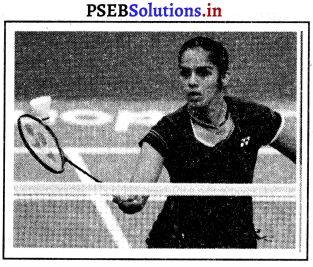
![]()
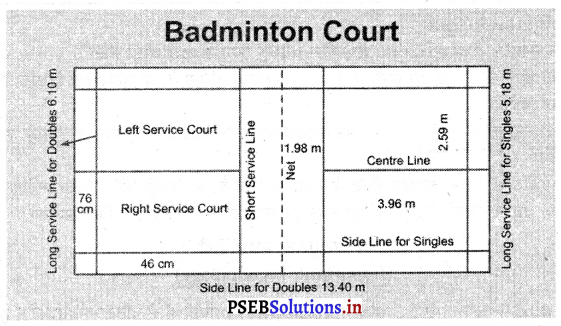
![]()
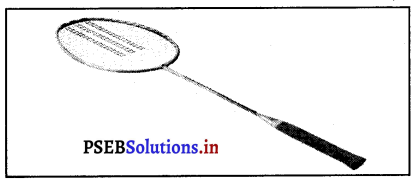
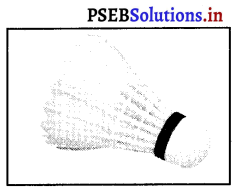
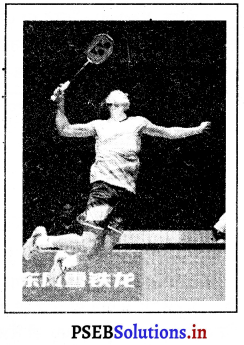
![]()
![]()
![]()

